Lugares de interés (POIs) del Mapa
0: A History of Romanesque Architecture 300 - 1300
This marker is part of an illustrated Survey of Romanesque Architecture, 300 to 1300 AD. To see and read all comments you have to download the post to your hard disk.
The objective of this Post is to present a survey of "Romanesque" architecture which brings together over 250 churches and cathedrals from the earliest beginnings of Christian architecture to the Gothic. Each example is illustrated with the best images I could find.
This period of Art History is amply documented in innumerable treatises and table-top books, why add another illustrated review? The answer becomes immediately apparent when one downloads the entire Post and expands it in Google-Earth.
In contrast to the customary organization of architectural history by countries this post is arranged in chronological order. The geographical locations are given by the GE map. This allows one to compare the development of different architectural styles in time and space. It leads to the "discovery" of, for instance, the seminal character of the architecture of Syria, Armenia, Georgia, Byzantium, the Goths in Spain, the 336 excommunicated heretic Ariani-Christians, and the Anglo-Saxons in England.
Two styles of early Christian architecture originated in the East in the 3rd-4th cent.: a Basilica and a centralized Cruciform Church. The Basilica derived from Roman provincial palaces in Syria and elsewhere, hence the designation of "Romanesque Architecture". Because of the need of the large western congrations the Basilica spread West.

Syria, the basilica of Kharrab Shams, (372). Photo by Raki_Man, Panoramio
Several of the most beautiful early basilicas are found in Ariani-Christian Ravenna.

Interior of St. Appolinare in Classe 549.
Photo from vito buccellato, Panoramio

Interior of the Aghia Sophia.
Photo Wikipedia
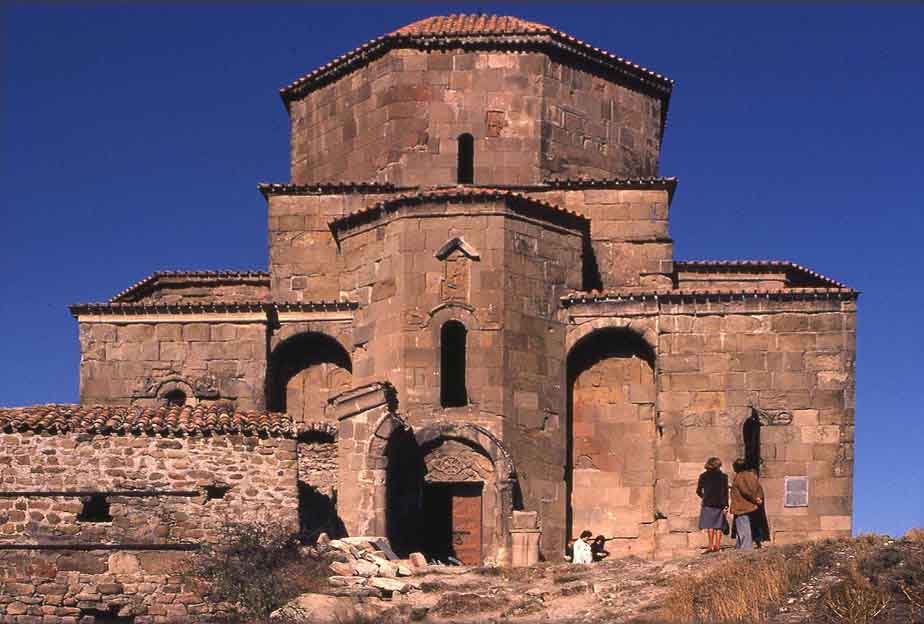
Djvari Mtskheta (Tbilisi), St. Nino's church, 6th cent.
Phhoto RWFG.
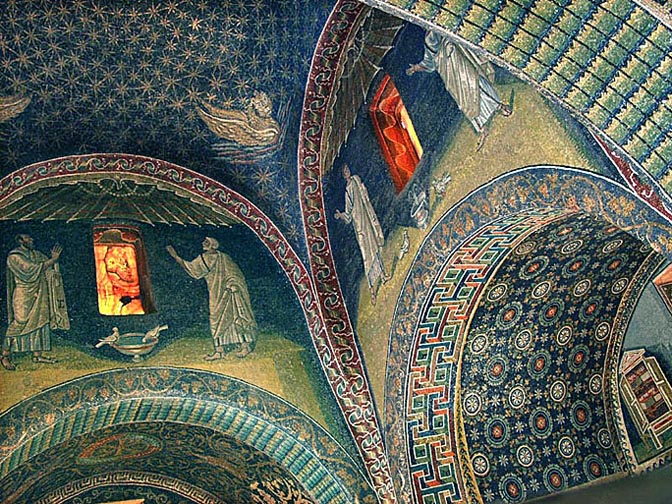
Mausoleum of Galla Placidia 430 AD. The window panes are thin alabaster slices! Photo RWFG

Mozarab frescoes in the hermitage of San Baudelio de Berlanga (early 11th cent)
Photo by VICMAEL, Panoramio
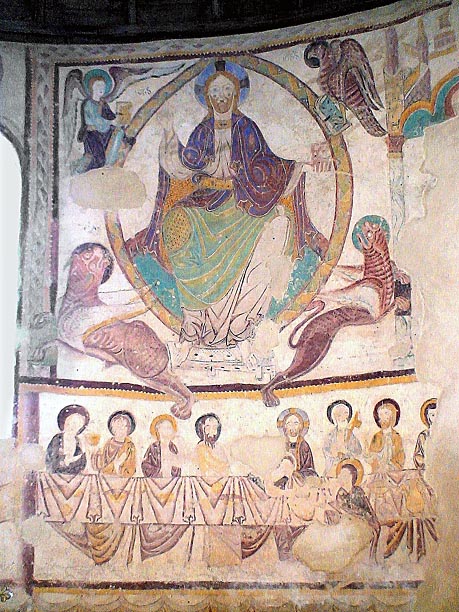
Christ in Majesty.
Photo Wikipedia.
RWFG, August 2008.
Más sobre A History of Romanesque Architecture 300 - 1300
1: Armenia, Echmiadzin Cathedral, 304, 484, 618, 1685
This marker is part of an illustrated Survey of Romanesque Architecture, 300 to 1300 AD. To see and read all comments you have to download the post to your hard disk.
Armenia, Echmiadzin Cathedral, 304, 484, 618, 1685

Photo by Karen_T, Panoramio
Más sobre Armenia, Echmiadzin Cathedral, 304, 484, 618, 1685
2: Trier Constantinian Aula Palatina, "Basilica" 310
This marker is part of an illustrated Survey of Romanesque Architecture, 300 to 1300 AD. To see and read all comments you have to download the post to your hard disk.
Trier, The Constantinian "Aula Palatina", ("Basilica") 310, was the Palace Aula (reception room) of Emperor Constantin's I. It was not used as a church during Constantine's time, but it is one of the earliest surviving examples of the U-form of the basilicas. to the Syrian church ruins and to Agh. Eirene in Constantinople.
Interior, Photo by Talavan, Panoramio
Más sobre Trier Constantinian Aula Palatina, "Basilica" 310
3: Italy, Rome, Basilica St John in Laterano 313 - 17th cent.
This marker is part of an illustrated Survey of Romanesque Architecture, 300 to 1300 AD. To see and read all comments you have to download the post to your hard disk.
Italy, Rome, Basilica St John in Laterano 313 - 17th cent.
The problem with the churches of Rome is that almost nothing remains of the earliest architecture. They have been rebuilt many times.
Basilica di San Giovanni in Laterano — is the oldest cathedral in Rome and ranks first among the four major basilicas of Rome. The site was occupied during the early Roman Empire by the palace of the gens Laterani. In time to host a synod of bishops in 313 that was convened to challenge the Donatist schism, the palace basilica was by Constantine I converted into a church and extended, eventually becoming the cathedral of Rome, the seat of the popes as bishops of Rome. It was enlarged and altered repeatedly so that nothing remains of the original church. In the 16th cent Pope Sixtus V tore down the original Lateran Palace and basilica and commissioned replacements.
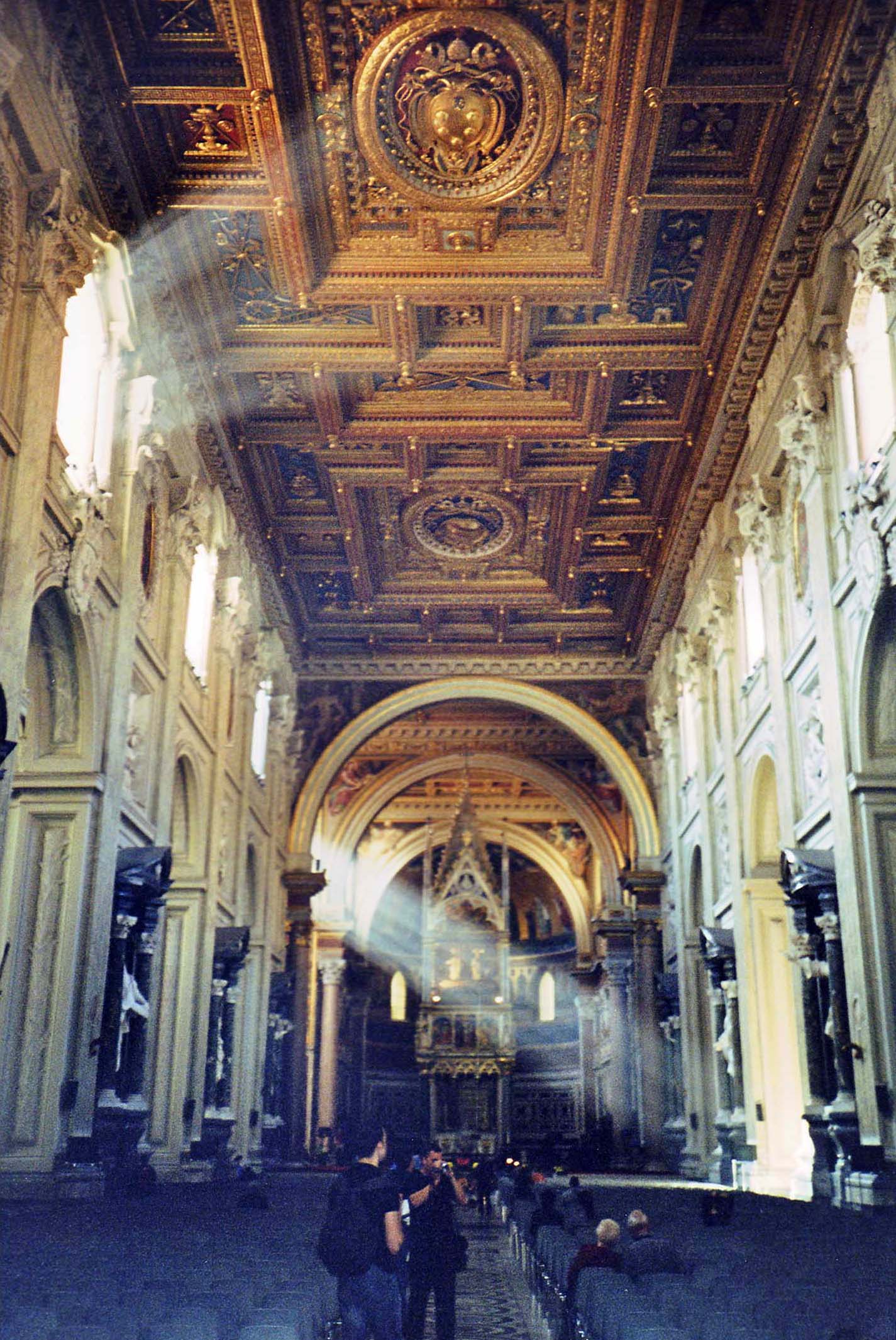
Photo and Text Wikipedia
Más sobre Italy, Rome, Basilica St John in Laterano 313 - 17th cent.
4: Italy, Rome, Basilica di San Clemente 4th cent, 1100
This marker is part of an illustrated Survey of Romanesque Architecture, 300 to 1300 AD. To see and read all comments you have to download the post to your hard disk.
Italy, Rome, Basilica di San Clemente 4th cent, 1100
The problem with the churches of Rome is that almost nothing remains of the earliest architecture. They have been rebuilt many times.
San Clemente is a three tiered archeological site with the upper most level being a twelfth century church dedicated to Pope Clement I (died 99 AD). Below it are the remnants of the church's 4th century predecessor built just before 1100. On the lowest leve a Roman Mthras temple of the 2nd cent. AD has been excavated. One of the most interesting and beautiful sites in Rome.

Interior of 11th cent building with well-preserved 4th cent. mosaics in the apse. Photo by mppp, Panoramio
Más sobre Italy, Rome, Basilica di San Clemente 4th cent, 1100
5: Jerusalem, Church of the Holy Sepulcher 325
This marker is part of an illustrated Survey of Romanesque Architecture, 300 to 1300 AD. To see and read all comments you have to download the post to your hard disk.
Jerusalem, Church of the Holy Sepulcher 325
Emperor Constantine I ordered in about 325/326 that the site be uncovered, and instructed Saint Macarius, Bishop of Jerusalem, to build a church on the site.

Entrance of the church.
Photo by Geraldo Antonio Salo…, Panoramio
Más sobre Jerusalem, Church of the Holy Sepulcher 325
6: Paros, Ekatontapyliadi Cathedral 326
This marker is part of an illustrated Survey of Romanesque Architecture, 300 to 1300 AD. To see and read all comments you have to download the post to your hard disk.
Paros, Ekatontapyliadi Cathedral 326
Extensiv archeological work during the past 20 years has revealed that a first church, dedicated to St. Nikolas was built in 326 AD during the time of Emperor Justinian with and inside the ruins of an Artemis temple - 211 years before the Aghia Sofia in Constantinople (537 AD). Of this first church the baptistery and the nave and apse with a bishop's throne, the left of the present church, have survived. This is one of the oldest Byzantine churches.
.
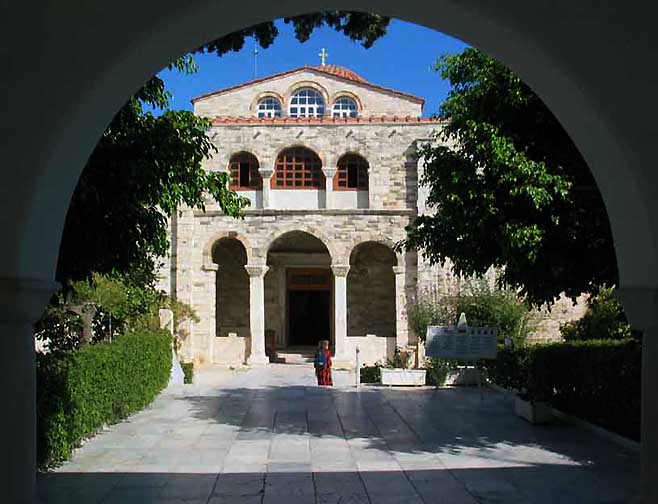
Legend has it that the Byzantine Empress, Saint Helena (6th century AD) brought one of the architects of the Aghia Sofia to Paros to erect the present cathedral filling the space between the two older buildings. Its grand-style architecture - provincial Byzantine churches are usually low, dark mole hills - seems to confirm this story. Like in the Aghia Sophia the 6th century addition is heavily indebted to spolia taken from 26 different classical temples - about which little seems to be known .
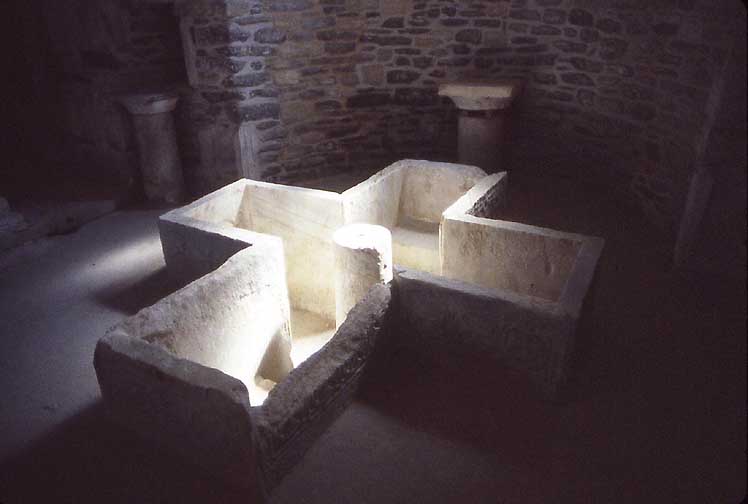
The baptismal font in the Baptisterion is the oldest such baptistry (326 AD) preserved in the Orthodox East
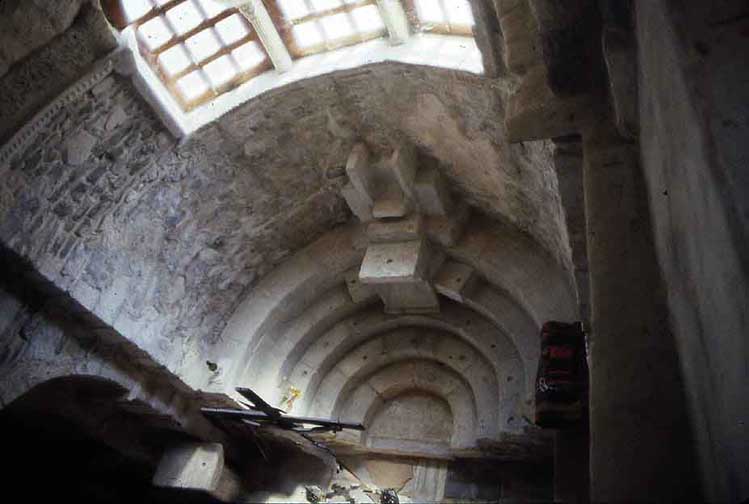
The rare Synthronon (seat of the bishop and the church council) in the apse of the Agh. Nicholaos church (4th century). (photo 1996)
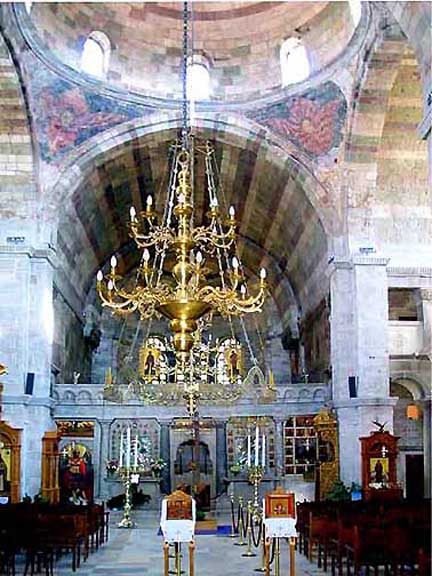
View of the iconostasis and the Byzantine chandelier in the nave of the main church. (560 AD). Photos RWFG.
Más sobre Paros, Ekatontapyliadi Cathedral 326
7: Germany, Trier Dom St. Peter 335, 1017
This marker is part of an illustrated Survey of Romanesque Architecture, 300 to 1300 AD. To see and read all comments you have to download the post to your hard disk.
Trier, Dom St. Peter present buillding 1017-1047 on foundations of a church by St. Helena (app. 335)

Photo by Christian Millen, Panoramio
Más sobre Germany, Trier Dom St. Peter 335, 1017
8: Italy, Rome, Santa Maria in Trastevere 340 - 18th cent.
This marker is part of an illustrated Survey of Romanesque Architecture, 300 to 1300 AD. To see and read all comments you have to download the post to your hard disk.
Italy, Rome, Santa Maria in Trastevere 340 - 18th cent.
The problem with the churches of Rome is that almost nothing remains of the earliest architecture. They have been rebuilt many times.
The basilica of Santa Maria in Trastevere is one of the oldest churches in Rome, perhaps the first in which mass was openly celebrated. The basic floor plan and wall structure of the church date back to the 340s. A Christian house-church was founded here about 220 by Pope St. Callixtus I (217-222) whose remains are preserved under the altar. It underwent two restorations in the fifth and eighth centuries. In 1140-43 the church was re-erected on its old foundations under Innocent II. Inside the church are a number of late 13th-century mosaics by Pietro Cavallini on the subject of the Life of the Virgin (1291). Reworked many times, the façade of the church was restored by Carlo Fontana in 1702,

Photo by mppp, Panoramio
Más sobre Italy, Rome, Santa Maria in Trastevere 340 - 18th cent.
9: Egypt Monastery of St. Anthony 356
This marker is part of an illustrated Survey of Romanesque Architecture, 300 to 1300 AD. To see and read all comments you have to download the post to your hard disk.
The monastery of Saint Anthony was built around 356 on the burial site of Saint Anthony. Little is known about the monastery's early period. During the sixth and seventh centuries, many monks from the monasteries of Scetes went to the monastery of Saint Anthony, in order to escape the frequent attacks by the Bedouins and Berbers. At this place Christian monasticism originated in the 4th cent..
Strictly speaking this is stylistically not "Romanesque" architecture. Here Eastern and Western influences come together. However the cultural impact of this venerable Monastery warrants its inclusion here.

Photo by martin.ullreich, Panoramio
Más sobre Egypt Monastery of St. Anthony 356
10: Spain, Carranque Basilica Theodosiana 360
This marker is part of an illustrated Survey of Romanesque Architecture, 300 to 1300 AD. To see and read all comments you have to download the post to your hard disk.
Carranque Archeological Park, ruin of a basilica, and a Roman villa.
The buildings date from the late fourth century and are thought to belong to a "Villa of Maternus Cinigius", the uncle of Theodosius I, Roman Emperor (347-395) , who was born in Hispania and during whose reign East and West Rome were united..
A Theodosian-era building that takes as models the governors' palaces. The hall was surrounded with 32 monolithic marble columns from the emperor's private quarries in Chios in Greece (known as or chium) and marble from Iscehisar and Afyon in Anatolia (phrygian or pavonazzeto marble). Soon it was converted for use in the Christian cult and burials. The Visigothic arrival brought some changes. It was also used during the Islamic age. The Knights Templars used it as an abbey or monastery.
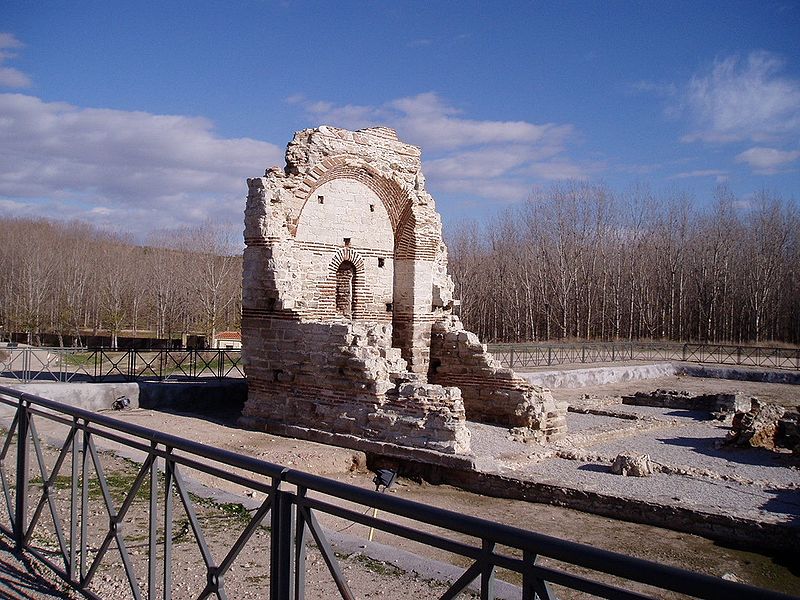
Photo Wikipedia
Más sobre Spain, Carranque Basilica Theodosiana 360
11: Istanbul. Aghia Eirene 4th cent, 548
This marker is part of an illustrated Survey of Romanesque Architecture, 300 to 1300 AD. To see and read all comments you have to download the post to your hard disk.
Constantinople-Istanbul, Aghia Eirene,

Originally built by Emperor Justinian I, 4th cent. Present building: 548. Photo by fisher40, Panoramio

The cross in the main apse is a unique example of the Islamic-inspired Iconoclast period in Byzantine art (730-787). Photo from Wkipedia
Más sobre Istanbul. Aghia Eirene 4th cent, 548
12: Italy, Rome, Old St. Peter 326-333
This marker is part of an illustrated Survey of Romanesque Architecture, 300 to 1300 AD. To see and read all comments you have to download the post to your hard disk.
Italy, Rome, Old St. Peter 326-333
The problem with the churches of Rome is that almost nothing remains of the earliest architecture. They have been rebuilt many times.
At least since the second century, the spot was thought to be the location of the tomb of Saint Peter, where there stood a small shrine. Construction was begun on the orders of the Roman emperor Constantine I between 326 and 333, and took about 30 years to complete. The design was a typical basilica form.
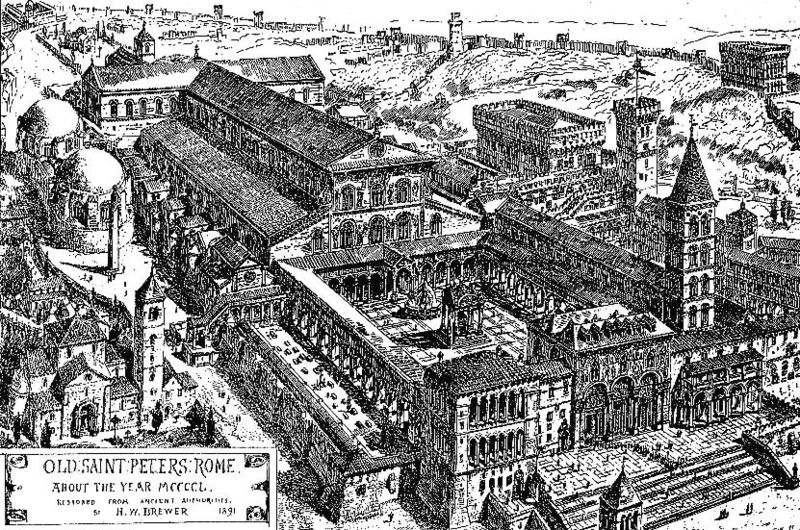
St. Peter in about 1483 certainly before 1506 when it was torn down and the present building was begun by Leone Battista Alberti and Bernardo Rossellin. Drawing Wikipedia
Más sobre Italy, Rome, Old St. Peter 326-333
13: Thessalonika, Rotonda 360
This marker is part of an illustrated Survey of Romanesque Architecture, 300 to 1300 AD. To see and read all comments you have to download the post to your hard disk.
Thessalonika, Rotonda built 306 by the Roman tetrarch Galerius, perhaps as a tomb. It was converted by Emperor Constantine I into a church in the 360s. It is now a museum of its badly deteriorated mosaics..
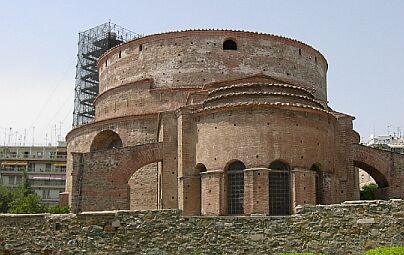
Photo Wikipedia
Más sobre Thessalonika, Rotonda 360
14: Syria, Mushabbak Church 4th cernt.
This marker is part of an illustrated Survey of Romanesque Architecture, 300 to 1300 AD. To see and read all comments you have to download the post to your hard disk.
Syria, Mushabbak Church 4th cernt.

Photo by Yasser.abdulaal, Panoramio
Más sobre Syria, Mushabbak Church 4th cernt.
15: Syria, Church of Burj Haidar 4th cent
This marker is part of an illustrated Survey of Romanesque Architecture, 300 to 1300 AD. To see and read all comments you have to download the post to your hard disk.
Syria, Burj Haidar 4th cent
Photo rubens.anu.edu.au
Más sobre Syria, Church of Burj Haidar 4th cent
16: Syria, Church of Kharrab Shams 372
This marker is part of an illustrated Survey of Romanesque Architecture, 300 to 1300 AD. To see and read all comments you have to download the post to your hard disk.
Syria, Church of Kharrab Shams 372

Photo by Raki_Man, Panoramio
Más sobre Syria, Church of Kharrab Shams 372
17: Syria, Damascus, Church of St. John Baptist 4th cent
This marker is part of an illustrated Survey of Romanesque Architecture, 300 to 1300 AD. To see and read all comments you have to download the post to your hard disk.
Syria, Damascus Church of St.John Baptist 4th cent - 705
rebuilt as: Great Omayyad Mosque 706 - 715
During Roman times the site was a temple of Jupiter which was in the 4th cent. converted into a Christian church dedicated to John the Baptist. The Muslim conquest of Damascus in 636 did not affect the church, as the site was shared by Muslim and Christian worshippers. The Umayyad caliph Al-Walid I purchased the site and demolished the church. He built the present mosque between 706 and 715 with the help of 200 skilled Byzantine workers: e.g., the mosaics in the overlong (136 x 37 m) prayer hall. Most of this interior decoration was lost in a great fire in 1893. The mosaics on the outside are of recent date.

Interior

Photo kaizergallery.com
It is seen that this building can be rightfully considered a "Romanesque" structure.....
Más sobre Syria, Damascus, Church of St. John Baptist 4th cent
18: Turkey, Ephesos, Church of Mary Theotokos 420
This marker is part of an illustrated Survey of Romanesque Architecture, 300 to 1300 AD. To see and read all comments you have to download the post to your hard disk.
Ephesos, Church of Mary Theotokos 420
The church is dated to the early 5th century, coinciding with the Third Ecumenical Council held in 431, suggesting that it may have been built specifically for the council, during which the title of Theotokos for the Mother of Christ was decided. The latest archaeological evidence suggests that the church was built on the ruins of an earlier Roman basilica-like building abandoned around the 3rd century. Around 500, the church was expanded into a monumental cathedral, whose apse and pillars partially still stand today on the site.
Strictly speaking this is stylistically not a "Romanesque" monastery. Here Eastern and Western influences come together. However the cultural impact of this venerable Monastery warrants its inclusion here.
The church served as a cathedral, the seat of the Bishop of Ephesus throughout Late Antiquity.
Más sobre Turkey, Ephesos, Church of Mary Theotokos 420
19: Rome, Santa Sabina 422
This marker is part of an illustrated Survey of Romanesque Architecture, 300 to 1300 AD. To see and read all comments you have to download the post to your hard disk.
Rome, Santa Sabina 422
The problem with the churches of Rome is that almost nothing remains of the earliest architecture. They have been rebuilt many times.
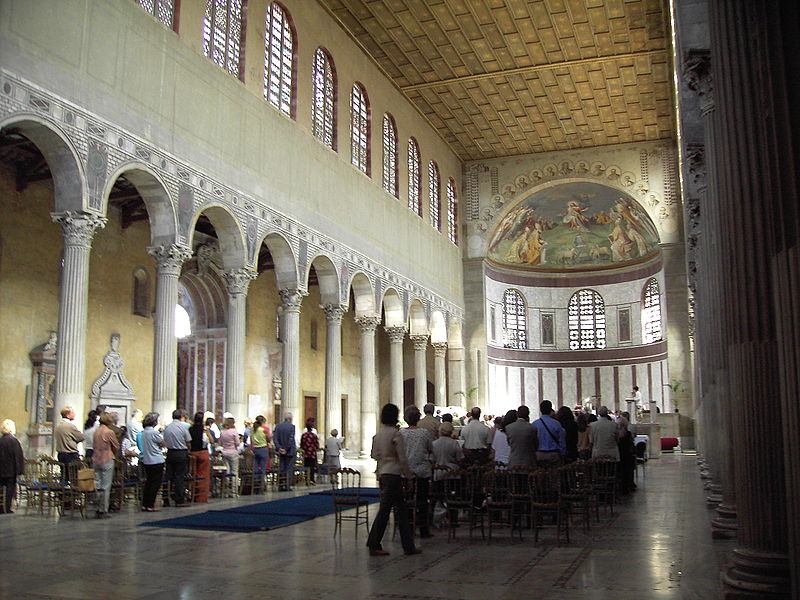
The basilica of Santa Sabina all'Aventino is the center of the Dominican order. The original 5th century apse mosaic was replaced by a very similar fresco by Taddeo Zuccari in 1559. Photo Wikipedia
Más sobre Rome, Santa Sabina 422
20: Syria, Aleppo, Church of St Simeon Stylite 473
This marker is part of an illustrated Survey of Romanesque Architecture, 300 to 1300 AD. To see and read all comments you have to download the post to your hard disk.
Syria, Aleppo, Church of St Simeon Stylite 473

Photo Washington University
Más sobre Syria, Aleppo, Church of St Simeon Stylite 473
21: Ravenna 430 - 561
This marker is part of an illustrated Survey of Romanesque Architecture, 300 to 1300 AD. To see and read all comments you have to download the post to your hard disk.
For a discussion of Ravenna see Wikipedia
For a collection of photographs see Adrian Fletcher, Paradox Places
Más sobre Ravenna 430 - 561
22: Mausoleum Galla Placidia 430 AD
This marker is part of an illustrated Survey of Romanesque Architecture, 300 to 1300 AD. To see and read all comments you have to download the post to your hard disk.
Mausoleum of Galla Placidia 430 AD.

Mausoleum of Galla Placidia 430 AD. The window panes are thin rock slices! Photo RWFG
Más sobre Mausoleum Galla Placidia 430 AD
23: Battisterio degli Ortodossi e Neoniani 490
This marker is part of an illustrated Survey of Romanesque Architecture, 300 to 1300 AD. To see and read all comments you have to download the post to your hard disk.
Battisterio degli Ortodossi e Neoniani, 490
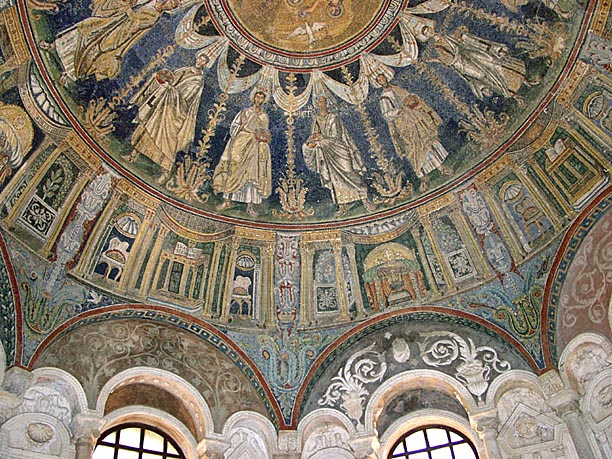
This is the oldest building in Ravenna. It was begun around 400 as the baptistry of the Ravenna Duomo, which no longer exists. The central part of the cupola mosaic was built by Bishop Neon (hence the name!) around 490. Parts were clumsily restored in the 19th cent. Dome of the Battisterio. Photo RWFG
Más sobre Battisterio degli Ortodossi e Neoniani 490
24: San Vitale 548 AD
This marker is part of an illustrated Survey of Romanesque Architecture, 300 to 1300 AD. To see and read all comments you have to download the post to your hard disk.
San Vitale 548 AD
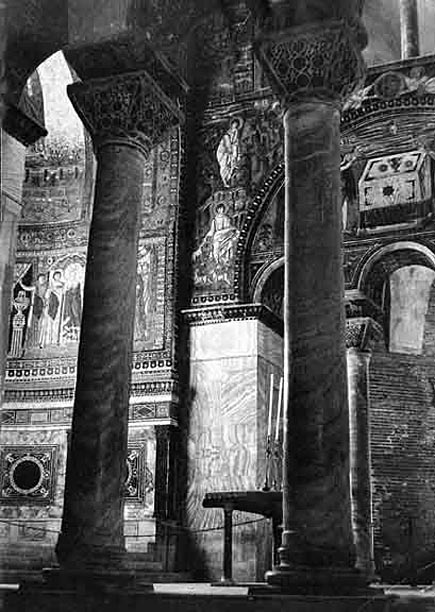
San Vitale 548 AD. Photo RWFG
Más sobre San Vitale 548 AD
25: Sant Appolinare in Classe 549
This marker is part of an illustrated Survey of Romanesque Architecture, 300 to 1300 AD. To see and read all comments you have to download the post to your hard disk.
Sant Appolinare in Classe (549)

Interior of Sant Appolinare in Classe 549. Photo from vito buccellato, Panoramio
Más sobre Sant Appolinare in Classe 549
26: Battisterio degli Ariani 500 AD
This marker is part of an illustrated Survey of Romanesque Architecture, 300 to 1300 AD. To see and read all comments you have to download the post to your hard disk.
Battisterio degli Ariani 500 AD
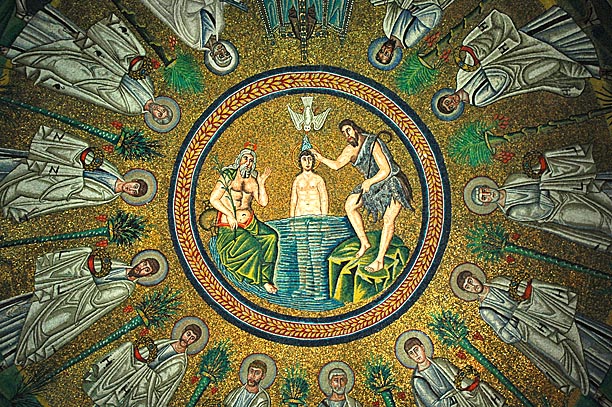
The ceiling mosaic of the Battisterio. Photo RWFG
Más sobre Battisterio degli Ariani 500 AD
27: Mausoleum of Theodorich 560
This marker is part of an illustrated Survey of Romanesque Architecture, 300 to 1300 AD. To see and read all comments you have to download the post to your hard disk.
Ravenna, Mausoleum of Theodorich, 560

Theodorich's tomb. 560
Photo by polskinorsk, Panoramio
Más sobre Mausoleum of Theodorich 560
28: Apollinare Nuovo 561
This marker is part of an illustrated Survey of Romanesque Architecture, 300 to 1300 AD. To see and read all comments you have to download the post to your hard disk.
Apollinare Nuovo 561AD
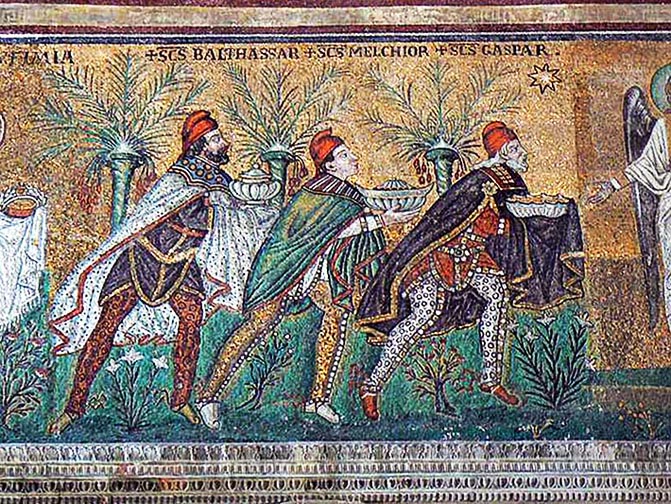
Sant Appolinare Nuovo 561 AD.
Photo RWFG
Más sobre Apollinare Nuovo 561
29: Thessalonika, Panagia Acheiropoietos 5th cent
This marker is part of an illustrated Survey of Romanesque Architecture, 300 to 1300 AD. To see and read all comments you have to download the post to your hard disk.
Thessalonika, Basilica Panagia Acheiropoietos 5th cent

The church was built in the middle of the 5th century, on the remains of a Roman bath. It was dedicated to the Holy Virgin "not made by human hands" (Acheiropoietos)-the name most probably refering to the cult image. A few fragments of mosaics have survived of the interior decoration in the soffits of the arches of the colonnades, dated to the 5th century A.D. Several parts of the wall paintings dated to the 13th century, are also preserved in the south aisle. Photo by Fillitsa Karantoni
Más sobre Thessalonika, Panagia Acheiropoietos 5th cent
30: Istanbul, Church of St. Mary of Blachernae 451
This marker is part of an illustrated Survey of Romanesque Architecture, 300 to 1300 AD. To see and read all comments you have to download the post to your hard disk.
Istanbul, Church of St. Mary of Blachernae 451
Built over a pagan spring in 451 by Pulcheria, the wife of the emperor Marcian. It was the repository of the robe and mantle of the Virgin Mary, the protectoress of the city, who appeared on the wall in 627 to disperse the Avars. The church was destroyed in a fire in 1434. There is nothing left but rubble today.
Más sobre Istanbul, Church of St. Mary of Blachernae 451
31: Istanbul, St. Mary Theotokos in Chalkeprateia, 450
This marker is part of an illustrated Survey of Romanesque Architecture, 300 to 1300 AD. To see and read all comments you have to download the post to your hard disk.
Istanbul, Ruins of St. Mary the Mother of God in the Copper-Market, named for its location. Only part of the apse and a fragment of the N wall remain. Founded in 450 by Pulcheria, wife of the Emperor Marcian it was the most important shrine of the Virgin in the city, since it housed her most sacred relic, the Holy Girdle and was the start or finish of all processions celebrating her feast-days.. After 1453 it was abandoned and fell into disrepair, being destroyed in the early 20th C.
Más sobre Istanbul, St. Mary Theotokos in Chalkeprateia, 450
32: Turkey, Antioch, Black Mountain, San Simeon Monastery 4th cent
This marker is part of an illustrated Survey of Romanesque Architecture, 300 to 1300 AD. To see and read all comments you have to download the post to your hard disk.
Turkey, Antioch, Black Mountain, San Simeon Monastery 5th cent

Photo by mustafator, Panoramio
Más sobre Turkey, Antioch, Black Mountain, San Simeon Monastery 4th cent
33: France, Frejus, Cathedral Baptistry 5th cent
This marker is part of an illustrated Survey of Romanesque Architecture, 300 to 1300 AD. To see and read all comments you have to download the post to your hard disk.
Frejus, Cathedral, Baptistry 5th cent , Naves 11th and 13th cent
It is part of a complex of medieval religious buildings dating from between the 5th and 13th centuries, when Fréjus was an important religious and commercial centre of Provence, comprising a parish church and a cathedral under one roof; a baptistery; the bishop's residence; a canonry, for the community of priests who served under the bishop; and a cloister.
The baptistery of the cathedral, built in the 5th century but hidden during later reconstruction, was rediscovered in 1925. It is considered the oldest Christian structure in Provence.

Wikipedia
Más sobre France, Frejus, Cathedral Baptistry 5th cent
34: Florence, Church of Santa Felicita 5th ,11th cent, 1736
This marker is part of an illustrated Survey of Romanesque Architecture, 300 to 1300 AD. To see and read all comments you have to download the post to your hard disk.
Florence, Church of Santa Felicita 5th ,11th cent, 1736
The Chiesa di Santa Felicita (Church of St Felicity) is probably the oldest church (after San Lorenzo) in Florence. It's history is as unique as it is unknown.
In the 2nd century, Syrian Greek merchants settled in the area south of the Arno. They are thought to have brought Christianity to the region. The first church on the site was probably built in the late 4th century or early 5th century and was dedicated to Saint Felicity of Rome. A new church was built in the 11th century and the current church largely dates from 1736–1739

Text and photo Wikipedia
Más sobre Florence, Church of Santa Felicita 5th ,11th cent, 1736
35: Autun St. Nazaire 5th cent
This marker is part of an illustrated Survey of Romanesque Architecture, 300 to 1300 AD. To see and read all comments you have to download the post to your hard disk.
France, Autun, Ruins of St. Nazaire 5th cent
The first cathedral of Autun was built from the 5th century onwards (later dedicated to Saint Nazarius or St. Nazaire, as it held relics of Saints Nazarius and Celsus) and several times refurbished and enlarged. The Bishop of Autun, Etienne de Bâgé, therefore decided in about 1120 on the construction of a new cathedral as a pilgrimage church and for the better veneration of the relics. The new cathedral was allotted a site to the north of the earlier cathedral of Saint Nazaire, of which some remains may still be seen.

The cathedral is famous for its many Bourgogne capitels and sculptures. Eve is from a lintel. Photo Terres-romanes.lu
Más sobre Autun St. Nazaire 5th cent
36: Istria, Porec, Cathedral 520-560
This marker is part of an illustrated Survey of Romanesque Architecture, 300 to 1300 AD. To see and read all comments you have to download the post to your hard disk.
Porec Cathedral Eufrasiana 520-560
Porec (Crotia) is the Roman city of Parentium. The cathedral was built by Bishop Euphrasius 553 over the site of an older basilica that dated back to the 4th century.

The most striking feature of the basilica are its mosaics, dating from the 6th century, which are considered amongst the finest examples of Byzantine art. The mosaics over the apse represent Christ with the Apostles,. Photo Wikipedia
Más sobre Istria, Porec, Cathedral 520-560
37: Egypt, St. Catharine Sinai Monsterey 527
This marker is part of an illustrated Survey of Romanesque Architecture, 300 to 1300 AD. To see and read all comments you have to download the post to your hard disk.
Istanbul, Haghia Sophia 532-537
The monastery was built by order of Emperor Justinian I between 527 and 565, enclosing the Chapel of the Burning Bush ordered to be built by St. Helena, the "mother, sister and later wife" of Emporer Constantine I - himself a Saint of Orthodoxy. For all possible historical explanations (there is a simpler apocryphal explanation) see Wikipedia

The monastery and Mt. Moses. Strictly speaking this is stylistically not a "Romanesque" monastery. Here Eastern and Western influences come together. However the cultural impact of this venerable Monastery warrants its inclusion here.
Photo katapi.org.uk
Más sobre Egypt, St. Catharine Sinai Monsterey 527
38: Istanbul, SS. Sergius and Bacchus 527
This marker is part of an illustrated Survey of Romanesque Architecture, 300 to 1300 AD. To see and read all comments you have to download the post to your hard disk.
Istanbul, SS. Sergius and Bacchus 527
Begun by Justinian in 527 it was dedicated to two martyred Roman soldiers and patrons of the Christian Roman army who appeared to the Emperor Justin I in a dream to convince him of his nephew’s innocence in a treason plot. Its irregular outline may be explained by the possibility it was built as a pair and deformed to accommodate its twin, the Church of SS. Peter and Paul directly to its south although nothing now remains of it. Like Haghia Sophia, which it may have been an architectural model for, very little remains of its original decoration, its mosaics having been plastered over.. Converted to Kucuk Aya Sofya Camii in the 16th C because of its resemblance to Haghia Sophia, it is still one of the finest preserved monuments in the city.
Más sobre Istanbul, SS. Sergius and Bacchus 527
39: Istanbul, Haghia Sophia 532-537
This marker is part of an illustrated Survey of Romanesque Architecture, 300 to 1300 AD. To see and read all comments you have to download the post to your hard disk.
Istanbul, Haghia Sophia 532-537
Byzantine churches fall into two stylistic categories: Basilicas based on the imperial Roman palaces, and centralized buildings based on the floor plans of the Roman baths. The former predominate in Western Europe, the latter in the East. Often the centralized, cruciform designs were erected over the grave of a saint, a practice adopted by Islam all over Central Asia, which developed the dome as the dominant structural element. The Aghia Sophia is the first great example of this design.

Interior. Photo Wikipedia
Más sobre Istanbul, Haghia Sophia 532-537
40: Scottland, Isle of Iona, Iona Abbey 563,
This marker is part of an illustrated Survey of Romanesque Architecture, 300 to 1300 AD. To see and read all comments you have to download the post to your hard disk.
Iona was founded in 563. From here began the wave of ealy Christianization of Nornthern Europe as far as Saxony, Regensburg and Aigsburg. Monks from Iona founded inumerous mmonasteries: e.g. Kells im Ireland,.
The present buildings date from the 12th cent.

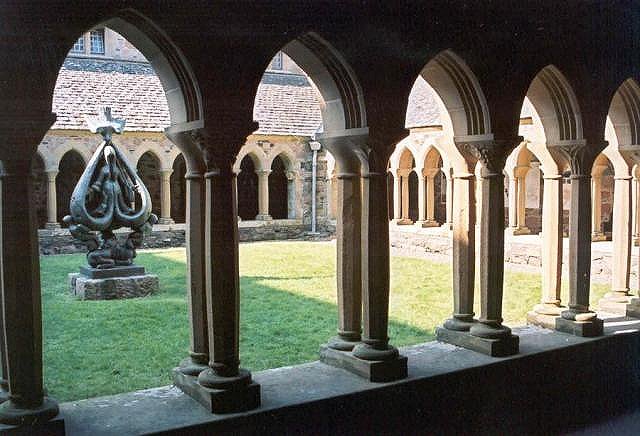
Photos from Wikipedia
Más sobre Scottland, Isle of Iona, Iona Abbey 563,
41: Georgia, Djvari-Mtskheta Church late 6th cent
This marker is part of an illustrated Survey of Romanesque Architecture, 300 to 1300 AD. To see and read all comments you have to download the post to your hard disk.
Djvari-Mtskheta Church lare 6th cent
The Holy Cross church high above Mtskheta is the Georgian national symbol. Built in the late 6th-cent in the place where Nino, the Cappadocian woman who converted the Georgians to Christianity in the 4th century, had erected a wooden cross.
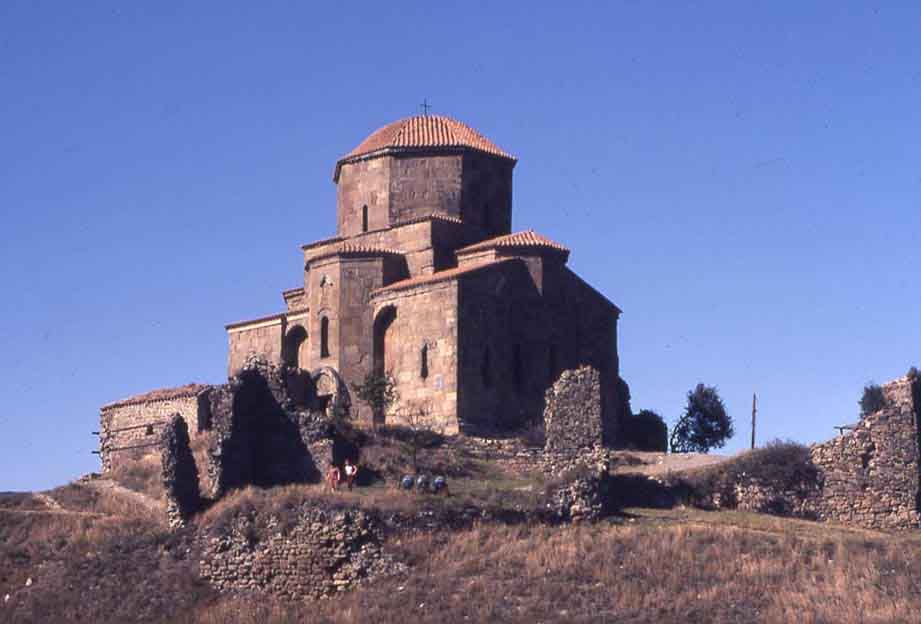

Like in Ilhara, Cappadocia Christ was symbolized by the "Raising of the Cross": Photos RWFG
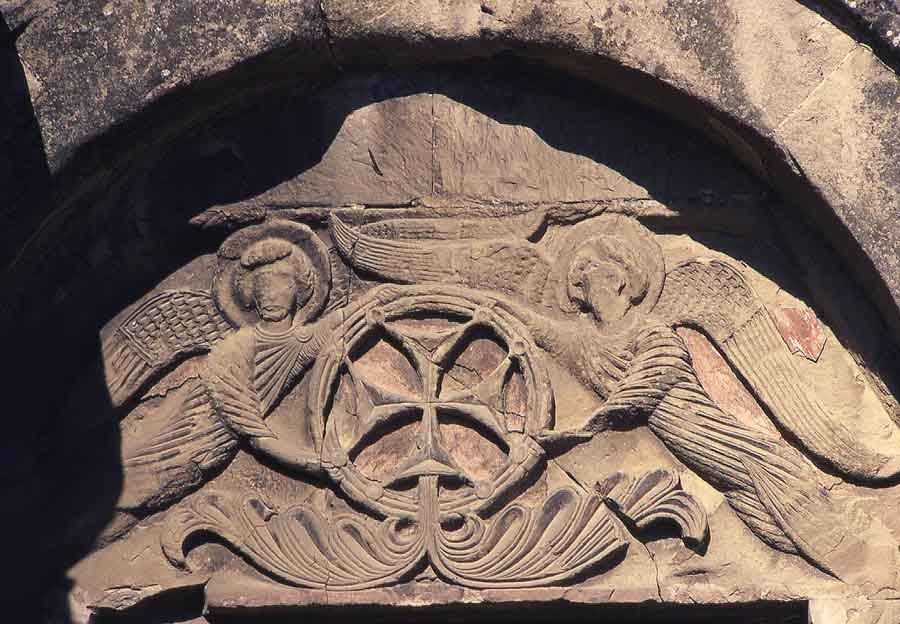
Más sobre Georgia, Djvari-Mtskheta Church late 6th cent
42: Spain, Ourense, Catedral, 6th, 13th cent
This marker is part of an illustrated Survey of Romanesque Architecture, 300 to 1300 AD. To see and read all comments you have to download the post to your hard disk.
Spain, Ourense, Catedral, 6th, 13th cent
The cathedral is the most important monument in Ourense. This cathedral (founded 572; rebuilt in the 13th century) is the second oldest in Galicia. It occupies the same site as the Suevian basilica that stood there in earlier times. Romanesque in structure, but with a mixture of Romanesque and Gothic styles, it is rather hidden away but, contains a façade with the Door of Paradise in imitation of the Door of Glory of the Cathedral of Santiago de Compostela.

Photo by saepiga, Panoramio
Más sobre Spain, Ourense, Catedral, 6th, 13th cent
43: Syria Mar Mousa Monastery 6th cent
This marker is part of an illustrated Survey of Romanesque Architecture, 300 to 1300 AD. To see and read all comments you have to download the post to your hard disk.
Syria Mar Mousa Monastery 6th cent
The Monastery of Mar Mousa al-Habashi is an active monastery in the Syrian mountains that dates from the 6th century. It was founded by St. Moses the Ethiopian.
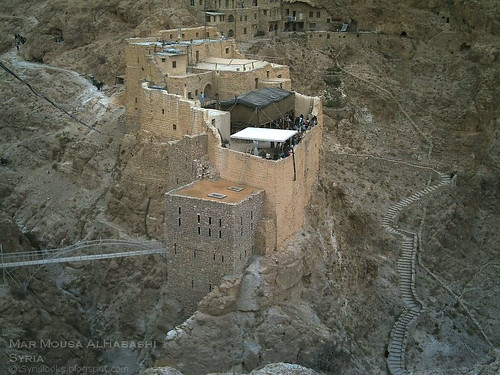
Photo
Más sobre Syria Mar Mousa Monastery 6th cent
44: Italy, Milano, San Ambrogiao 4th- 9th cent
This marker is part of an illustrated Survey of Romanesque Architecture, 300 to 1300 AD. To see and read all comments you have to download the post to your hard disk.
Italy, Milano, San Ambrogio 4th, 9th tower 12th cent.
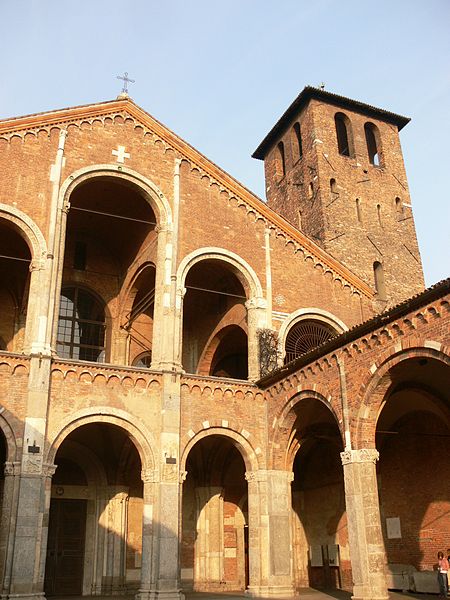
Photo Wikipedia
Más sobre Italy, Milano, San Ambrogiao 4th- 9th cent
45: Armenia, Echmiadzin Church of S. Hripsimeh 615-628
This marker is part of an illustrated Survey of Romanesque Architecture, 300 to 1300 AD. To see and read all comments you have to download the post to your hard disk.
Armenia, Echmiadzin Church of S. Hripsimeh 615-628 AD
The church was erected by the Katholikos Komitas (615-628 AD). The present church was built over the 4th century mausoleum erected by the Kat'olikos Sahak. During the renovations of 1959-1962, the remains of a pagan structure were found beneath the floor of the church.

Photo by Karen_T, Panoramio
Más sobre Armenia, Echmiadzin Church of S. Hripsimeh 615-628
46: Switzerland, Monastery St. Gallen. 613, 9th cent, 17th cent
This marker is part of an illustrated Survey of Romanesque Architecture, 300 to 1300 AD. To see and read all comments you have to download the post to your hard disk.
The monastery was founded in 613 and named after Gallus, an Irishman. St.Hgallen became one of the most important Carolingian study centeres. In 740 St. Gall's famous library was estanlished. Numerous Anglo-Saxon and Irish monks came to copy manuscripts. At Charlemagne's request Pope Adrian I sent distinguished chanters from Rome, who propagated the use of the Gregorian chant. Today the library at the Abbey is considered one of the richest medieval libraries in the world.
The floor plan of the original Carolingian Benedictine abbey is preserved. During the late 17th cent the 9th cent church was replaced by an early Baroqu e wonder.
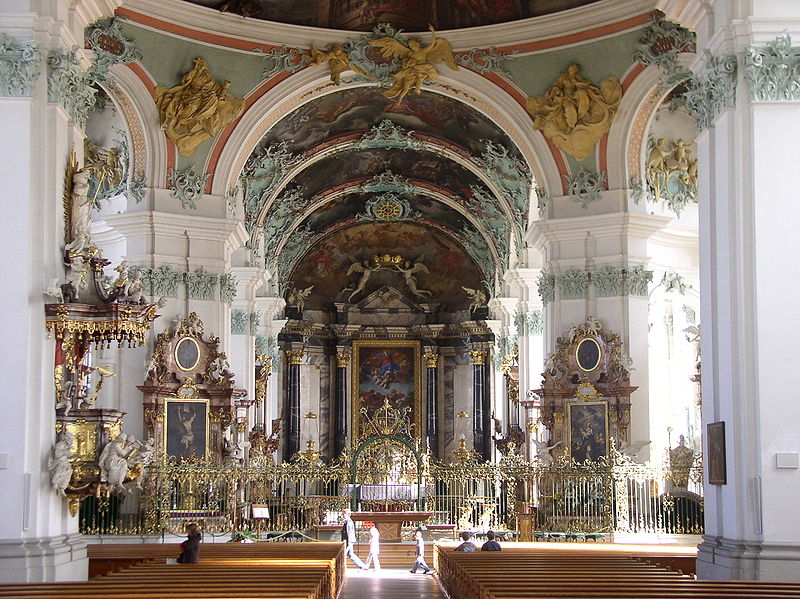
Photo Wikipedia
Más sobre Switzerland, Monastery St. Gallen. 613, 9th cent, 17th cent
47: Tao-Klarjeti, Bana, 630
This marker is part of an illustrated Survey of Romanesque Architecture, 300 to 1300 AD. To see and read all comments you have to download the post to your hard disk.
Tao-Klarjeti, Turkey, Cathedral of Bana, 630
Bana is located in magnificent landscape.
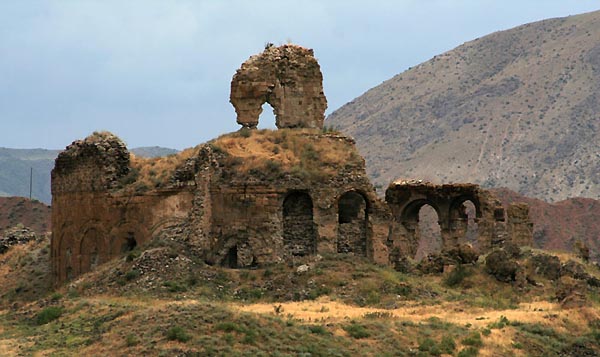
The ruined church (photo 2007). Photos from the 1920s show that since that time the unique circular monument, reminiscent of Svartnots (Armenia) and St. Gregory-Ani (Turkey), has been subjected to extensive quarring of stones and spolia. It is today one of the most endangered archeological sites in northeastern Turkey.
<
Más sobre Tao-Klarjeti, Bana, 630
48: Armenia, Zvartnots Cathedral 648 - 652
This marker is part of an illustrated Survey of Romanesque Architecture, 300 to 1300 AD. To see and read all comments you have to download the post to your hard disk.
Armenia, Zvartnots Cathedral 648 - 652
Between 643 and 652 the Catholikos Nerses III (nicknamed the builder) built a majestic cathedral dedicated to St. George at the place where a meeting between king Trdat III and Gregory the Illuminator was supposed to have taken place. In 930 the church was ruined by an earthquake, and remained buried until its rediscovery in the early 20th century.

Photo by Ardani, Panoramio
Más sobre Armenia, Zvartnots Cathedral 648 - 652
49: Poitiers, Baptistery St-Jean, 360, 6th-7th cent
This marker is part of an illustrated Survey of Romanesque Architecture, 300 to 1300 AD. To see and read all comments you have to download the post to your hard disk.
Poitiers, Baptistery of Saint-Jean Merovingian 360, with expansions in 6th/7th century, is reputed to be the oldest extant Christian building in France and one of the most prominent examples of Merovingian architecture.

The baptistry. Photo Photo © Jaufré Rudel. Sacred Destinations
Más sobre Poitiers, Baptistery St-Jean, 360, 6th-7th cent
50: Winchester Anglo-Saxon Minster 648
This marker is part of an illustrated Survey of Romanesque Architecture, 300 to 1300 AD. To see and read all comments you have to download the post to your hard disk.
Old Anglo-Saxon Minster of 648. The outline of the Saxon church is visible from space in the grass next to the Norman cathedral which replaced it in 1079.

>BR>Foundations of the Anglo-Saxon church. Phptp Winchester Cathedral.com
Más sobre Winchester Anglo-Saxon Minster 648
51: Spain, San Martín de Montalbán, Santa María de Melque 7th cent
This marker is part of an illustrated Survey of Romanesque Architecture, 300 to 1300 AD. To see and read all comments you have to download the post to your hard disk.
Spain, San Martín de Montalbán, Santa María de Melque 7th-8th cent
The church stands out, exemplary Mozarabic-Visigoth, as the most important religious monument of the Early Middle Ages in Spain.
Santa María de Melque came into being as a monastic collection in the 7th and 8th centuries inside of what was the capital of the Visigothic Kingdom, Toledo. Construction commenced in the 7th century, coinciding with the end of the Visigothic kingdom, and probably came to a halt with the arrival of the Arabs, to be continued later. Melque could be at first a mausoleum, destined to burial of a distinguished personage from Toledo's Visigothic Kingdom. The church was later redesigned on at least two occasions.

Inside with Visigoth / Mozarab arches. Photo by Shenkaros, Panoramio
Más sobre Spain, San Martín de Montalbán, Santa María de Melque 7th cent
52: Spain, Sotosalbos San Pedro de la Nave 680-711
This marker is part of an illustrated Survey of Romanesque Architecture, 300 to 1300 AD. To see and read all comments you have to download the post to your hard disk.
San Pedro de la Nave is one of the last works of Visigothic architecture. Originally the church was sited on the banks of the river Esla, but, when the Ricobayo dam was built, it was moved to avoid submersion in the higher waters of the Esla. Thanks to the efforts of Manuel Gómez-Moreno, it was decided that the church would be moved stone by stone to its current location. This operation was carried out in 1930-32, under the direction of the architect Alejandro Ferrant Vázquez. - The church's first design corresponded to a Greek cross in plan, although later two lateral naves were added, which gave it a hybrid shape between basilical and cruciform.
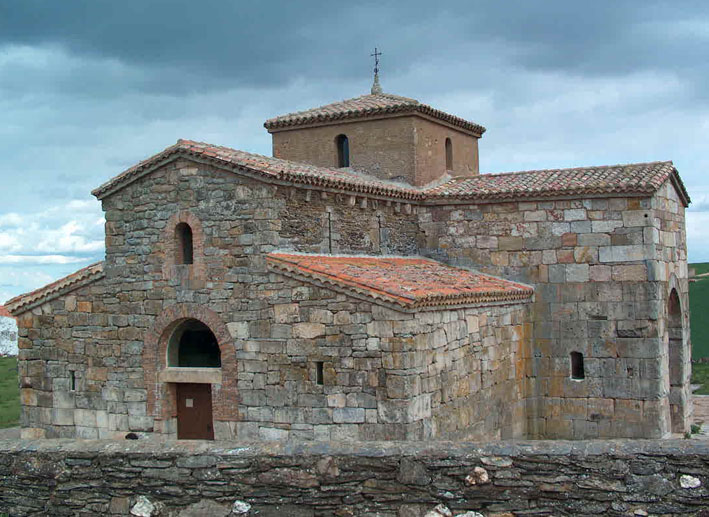
Photo Wikipedia
Más sobre Spain, Sotosalbos San Pedro de la Nave 680-711
53: Spain, Campillo, San Pedro de la Nave 680
This marker is part of an illustrated Survey of Romanesque Architecture, 300 to 1300 AD. To see and read all comments you have to download the post to your hard disk.
Spain, Campillo, San Pedro de la Nave 680, Visigoth
The church foundation goes back to the reign of Ergica, having been built between 680 and before the Muslim conquest of Spain in 711; San Pedro de la Nave is thus one of the last works of Visigothic architecture.

Photo by vacceos, Panoramio
Más sobre Spain, Campillo, San Pedro de la Nave 680
54: Germany, Lorsch Benedictine Abbey 760
This marker is part of an illustrated Survey of Romanesque Architecture, 300 to 1300 AD. To see and read all comments you have to download the post to your hard disk.
Lorsch, Gatehouse of the former Benedectine abbey 760

Photo thaïs.it
Más sobre Germany, Lorsch Benedictine Abbey 760
55: Italy Benevento Santa Sofia 762
This marker is part of an illustrated Survey of Romanesque Architecture, 300 to 1300 AD. To see and read all comments you have to download the post to your hard disk.
Benevento Chiesa Santa Sofia, 762

Interior of the chiesa di Santa Sofia in Benevento. Photo from thais.it/architettura/romanica/
Más sobre Italy Benevento Santa Sofia 762
56: Georgia, Ateni, late 8th cent
This marker is part of an illustrated Survey of Romanesque Architecture, 300 to 1300 AD. To see and read all comments you have to download the post to your hard disk.
Georgia, Ateni, late 8th cent .
Ateni's 12th-century frescoes are one of the treasures of Georgia. The Djvari-type church in its romantic setting among vineyards probably dates from the 8th cent, as the recent discovery of iconoclast (mid-late 8th cent) frescoes has shown :
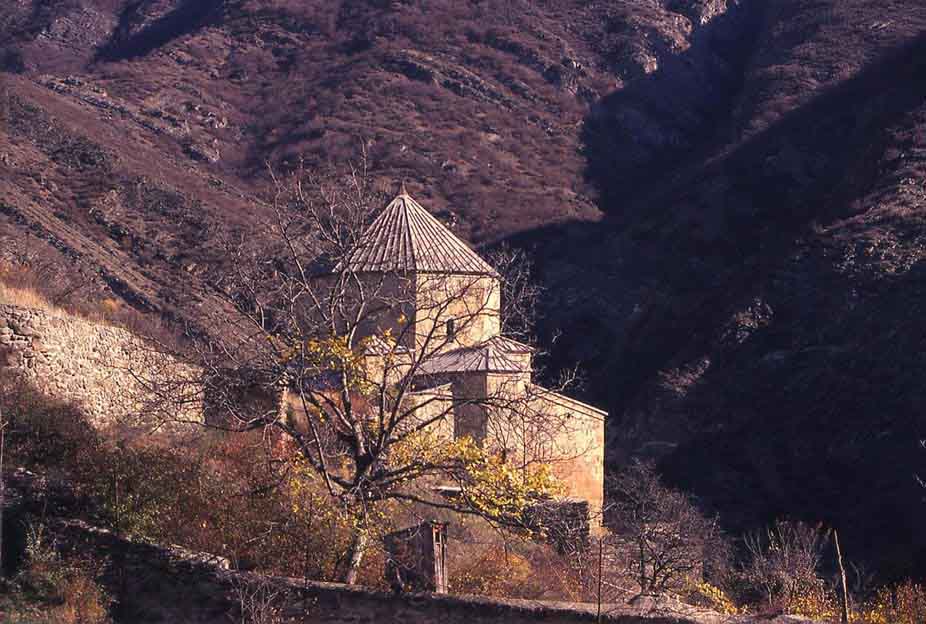
Ateni's frescoes differ from contemporary murals in the Greek-Byzantine churches by their liveliness. Joseph's dream may be the most celebrated of them:
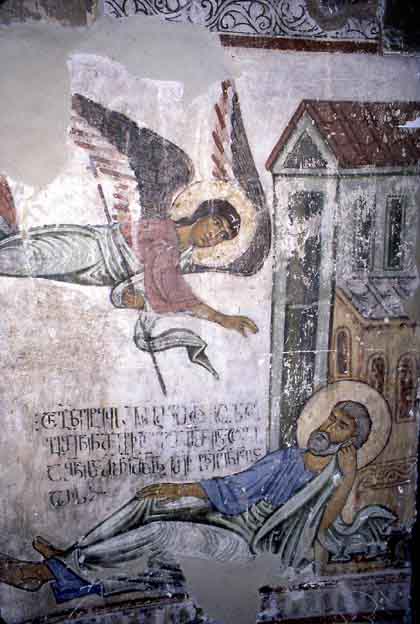
Last Supper
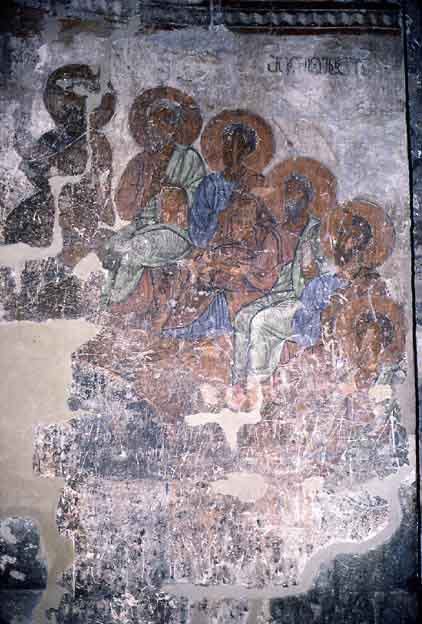
Photos RWFG
Más sobre Georgia, Ateni, late 8th cent
57: Cappdocia, Frescoes of Peristrema 8th cent.
This marker is part of an illustrated Survey of Romanesque Architecture, 300 to 1300 AD. To see and read all comments you have to download the post to your hard disk.
Cappadocia, The Frecoes of Peristrema 8th cent
There are supposedly twenty-five chapels and churches hidden in caves in the rock walls. We could find only three, but they were special.
The paintings in the Sumbullu Kilise - the Church of the Hyacinth must be the oldest frescoes I have seen outside of Georgia and Dunhuang.
This "Elevation of Christ" predates the Iconoclast Period — i.e., it goes back to the beginning of the 8th century. It is different from the Elevation (a relief not a fresco) at Djvari-Mtskheta in Georgia (5th cent) where Christ is represented only by a cross carried by angels. Here Christ actually appears, floating on a Greek cross, and carried (according to Dionysos Arapagitos' mystic visions) by tweny-four wonderfully naïve angels.
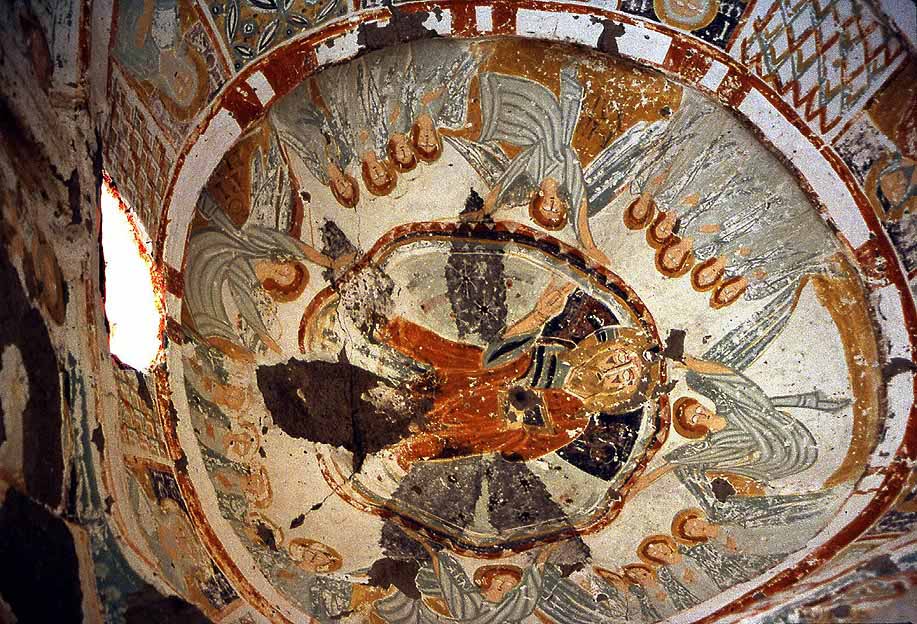
The frescoes in the vault of another church are half a century later! Fully abstract - an influence of the nascent Islamic movement without their acute sense of form - they are from the Iconoclast Period (725-843 AD).
Más sobre Cappdocia, Frescoes of Peristrema 8th cent.
58: Germany, Aachen, Capella Palatina 792-805
This marker is part of an illustrated Survey of Romanesque Architecture, 300 to 1300 AD. To see and read all comments you have to download the post to your hard disk.
Germany, Aachen Capella Palatina 792-805

Interior of Charlemagnes's Coronation Cathedral at Aachen, 792-805. Photo from thais.it/architettura/romanica/
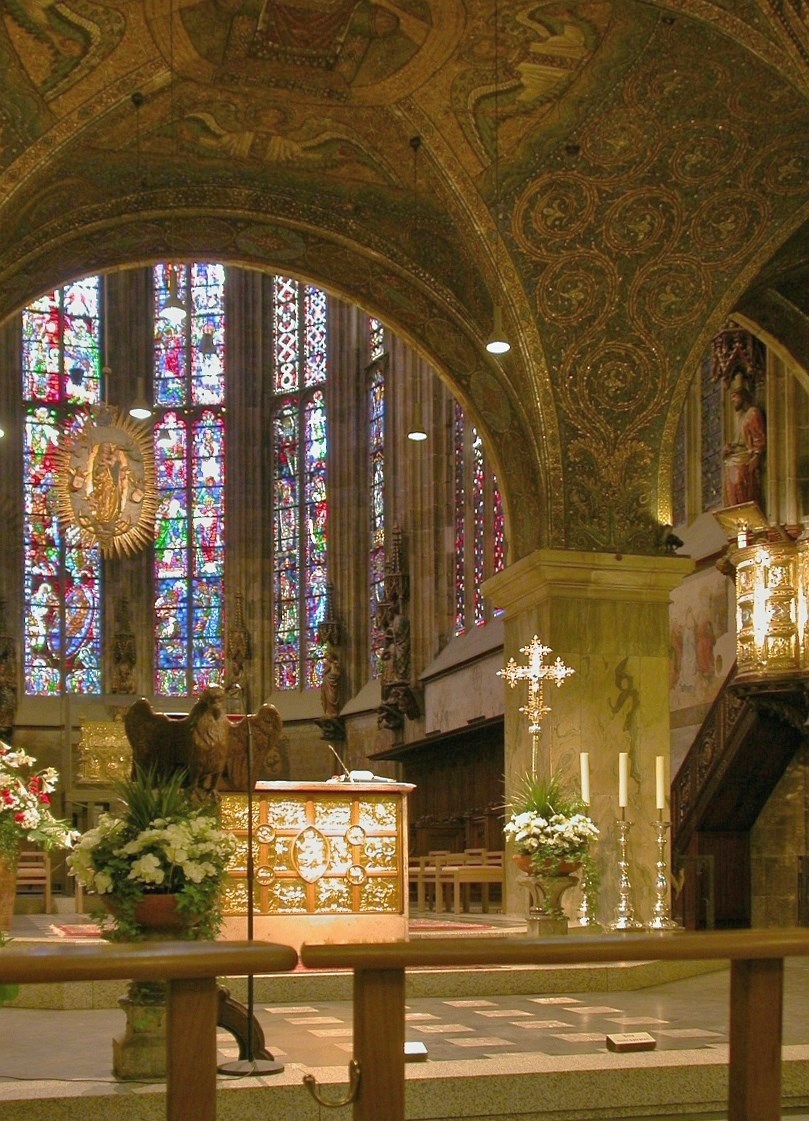
View of the high altar and the choir. Photo Wikipedia
Más sobre Germany, Aachen, Capella Palatina 792-805
59: France, St. Germiny-des-Pres Oratoire 806
This marker is part of an illustrated Survey of Romanesque Architecture, 300 to 1300 AD. To see and read all comments you have to download the post to your hard disk.
France, St. Germiny-des-Pres, Theodulf's private Oratory, 806.
The small, plain church here incorporates at its east end one of the few surviving buildings from the Carolingian Renaissance, a tiny, perfectly formed church in the shape of a Greek cross. It was built in 806 as a private oratory for Theodulf, who was one of Charlemagne's counsellors as well as bishop of Orléans and abbot of St-Benoît. Theodulf was a Visigoth, while the chapel itself is a typically Carolingian design (Aachen), its unique mosaic in the dome of the eastern chapel points to Andalusian influences.
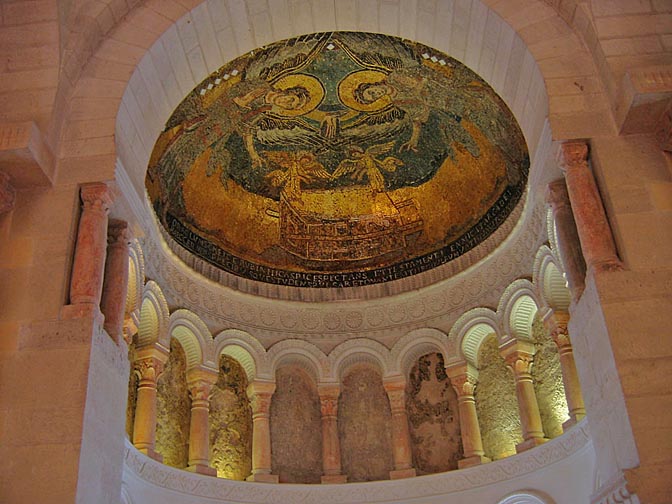
The mosaic
Photo by by JMZ2007, Panoramio (here slightly digitally lightened by RWFG)
The uniqueness of this mosaic lies in its subject: the Old Testament Ark of the Jewish Covenant (Josh. 3:6; Hebrews 9:4) ! - even the 2 angels were included in the composition. - does not seem to exist anywhere else - obviously not in Jewish synagogues nor ib Christian churches. It with JMZ a Jewish connection to Al-Andalus - that far north!
Más sobre France, St. Germiny-des-Pres Oratoire 806
60: Ireland, Monastery of Kells 804
This marker is part of an illustrated Survey of Romanesque Architecture, 300 to 1300 AD. To see and read all comments you have to download the post to your hard disk.
The Monastery at Kells was founded in 804 by monks from St Colmcille's Abbey of Iona. The Book of Kells was written here in he 9th century, the monastery is famous for it's Round Tower and Celtic High Crosses.

Photo Megalithic Ireland
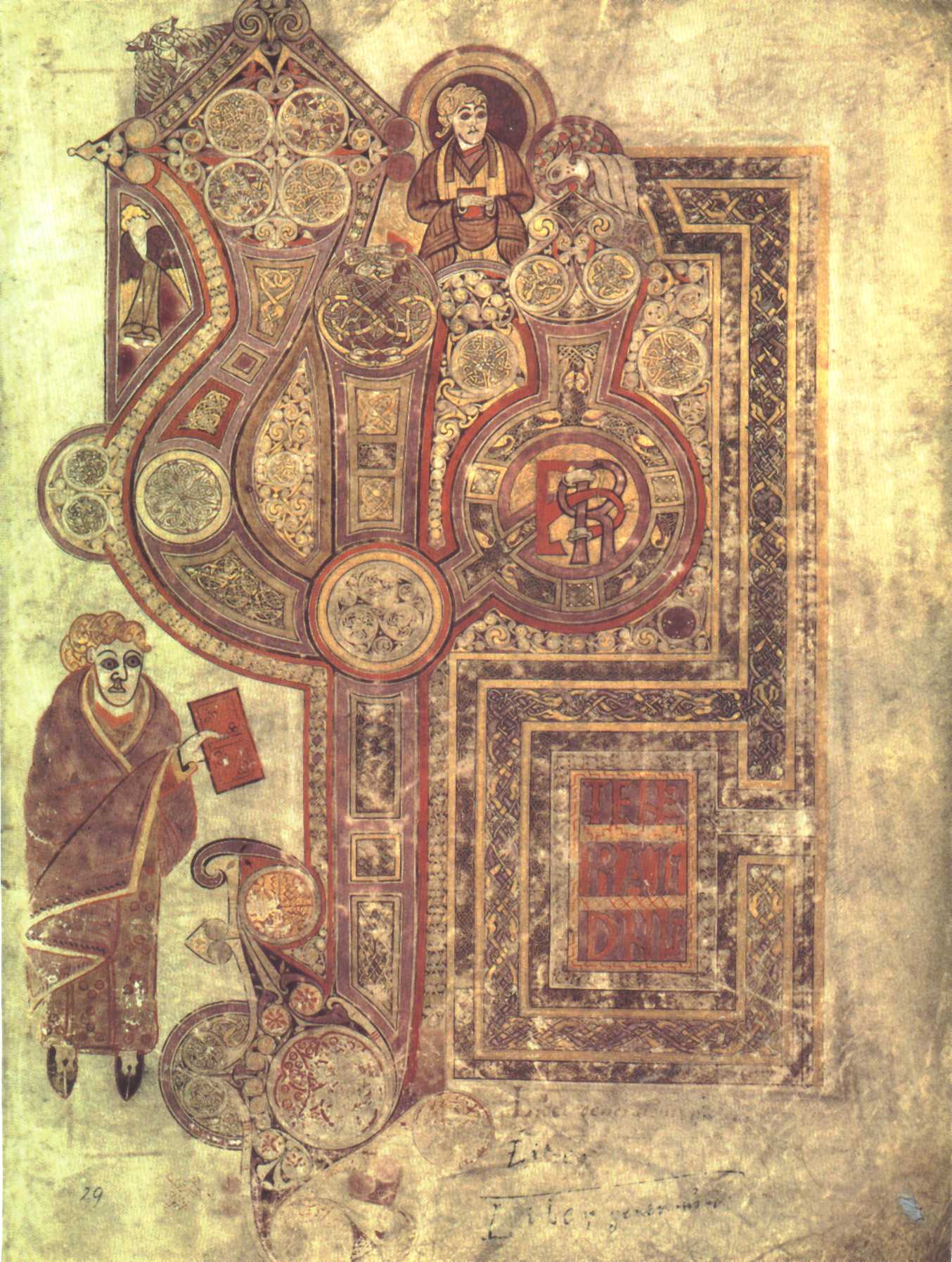
The title page of St. Mathew's Gospel in the Book of Kells. (presumed to be from around 800 AD) The elaborate ornamental "carpet" design was influenced by early Islamic examples, brought from Syria.
Photo Wikipedia
Más sobre Ireland, Monastery of Kells 804
61: Ireland, Gallarus Oratory, Dingle Peninsula 7- 8th cent
This marker is part of an illustrated Survey of Romanesque Architecture, 300 to 1300 AD. To see and read all comments you have to download the post to your hard disk.
Ireland, Gallarus Oratory, Dingle Peninsula 7- 8th cent

Photo from Wikipedia
"In Gallarus Oratory" (1969) is a poem written by Seamus Heaney.
Más sobre Ireland, Gallarus Oratory, Dingle Peninsula 7- 8th cent
62: Bordeaux, Eglise Sainte Croix, 7th - 12th cent
This marker is part of an illustrated Survey of Romanesque Architecture, 300 to 1300 AD. To see and read all comments you have to download the post to your hard disk.
Bordeaux, Eglise Sainte Croix, 7th - 12th cent

It is part of a Benedictine abbey founded in the 7th century, and was built in the late 11th-early 12th centuries. The façade is in Romanesque style. Photo from Wikipedia
Más sobre Bordeaux, Eglise Sainte Croix, 7th - 12th cent
63: Spain, Oviedo, San Julian 812 - 42
This marker is part of an illustrated Survey of Romanesque Architecture, 300 to 1300 AD. To see and read all comments you have to download the post to your hard disk.
Oviedo San Julian de los Prados 812 - 42

The church is not the oldest but perhaps the most important of the 4 early Romanesque churches in Oviedo. Photo by vcespon, Panoramio

The interior
Photo from thais.it/architettura/romanica/
Más sobre Spain, Oviedo, San Julian 812 - 42
64: Germany, Corvey Monastery 822
This marker is part of an illustrated Survey of Romanesque Architecture, 300 to 1300 AD. To see and read all comments you have to download the post to your hard disk.
Germany Corvey Benedictine Klosterkirche 822 - 44


Photos from thais.it/architettura/romanica/
Más sobre Germany, Corvey Monastery 822
65: Germany Seligenstadt Basilica 828
This marker is part of an illustrated Survey of Romanesque Architecture, 300 to 1300 AD. To see and read all comments you have to download the post to your hard disk.
Seligenstadt "Einhard Basilica" St Marcellinus und St Petrus 828 - 40

It was founded 820 by Charlemagne's cousins Wala and Adelard with monks from Corbie Abbey in Picardy, under the patronage of the Emperor Louis the Pious and the abbot of the older foundation, whence the new one derived its name. It became "one of the most privileged Carolingian monastic sanctuaries in ninth-century Saxony"
Photo from thais.it/architettura/romanica/
Más sobre Germany Seligenstadt Basilica 828
66: Tao-Klarjeti, Opiza 826
This marker is part of an illustrated Survey of Romanesque Architecture, 300 to 1300 AD. To see and read all comments you have to download the post to your hard disk.
Tao-Klarjeti, Turkey
Church of Opiza, 826
Like Bana Opiza, having been used as a quarry for local building materials, is in a deplorable state of delapidation.
Two spolia from the church depicting - according to the inscriptions - King Ashok I and his son David presenting the church to Christ (826). The inscrptions are in Asomtavruli-Georgian. In the left upper corner Ashok's country is named as "tao".
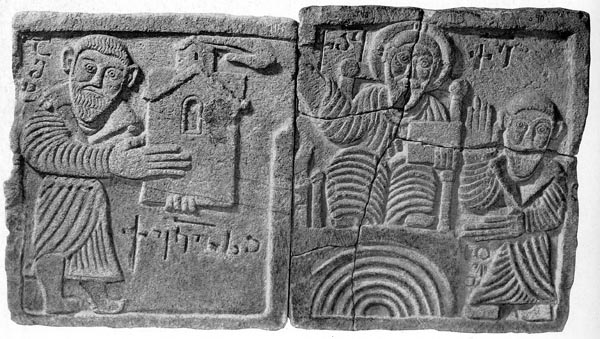
<
Más sobre Tao-Klarjeti, Opiza 826
67: Spain, Oviedo Santa Maria del Naranco 842
This marker is part of an illustrated Survey of Romanesque Architecture, 300 to 1300 AD. To see and read all comments you have to download the post to your hard disk.
Oviedo, Santa Maria del Naranco 842
The building was ordered by Ramiro I built as a palace, being finished in the year 842 AD, as part of a building complex that also included the nearby church of San Miguel de Lillo, erected just a hundred meters away. It was consecrated as a church in the 13th cent

Photo wikipedia
Más sobre Spain, Oviedo Santa Maria del Naranco 842
68: Spain, Oviedo San Miguel de Lillo 842-848
This marker is part of an illustrated Survey of Romanesque Architecture, 300 to 1300 AD. To see and read all comments you have to download the post to your hard disk.
Oviedo San Miguel de Lillo 842-848

Photo by margoban, Panoramio
Más sobre Spain, Oviedo San Miguel de Lillo 842-848
69: Germany, Höchst, St. Justinius, after 850
This marker is part of an illustrated Survey of Romanesque Architecture, 300 to 1300 AD. To see and read all comments you have to download the post to your hard disk.
Germany, Höchst, St. Justinius, after 850

Carolingian nave after 850, Baroque altar (18th cent). Photo http://www.panoramio.com/photo/4864170" target="_blank">by Michael König, Panoramio
Más sobre Germany, Höchst, St. Justinius, after 850
70: Reichenau Oberzell 890
This marker is part of an illustrated Survey of Romanesque Architecture, 300 to 1300 AD. To see and read all comments you have to download the post to your hard disk.
Reichenau Oberzell Sankt Georg about 890
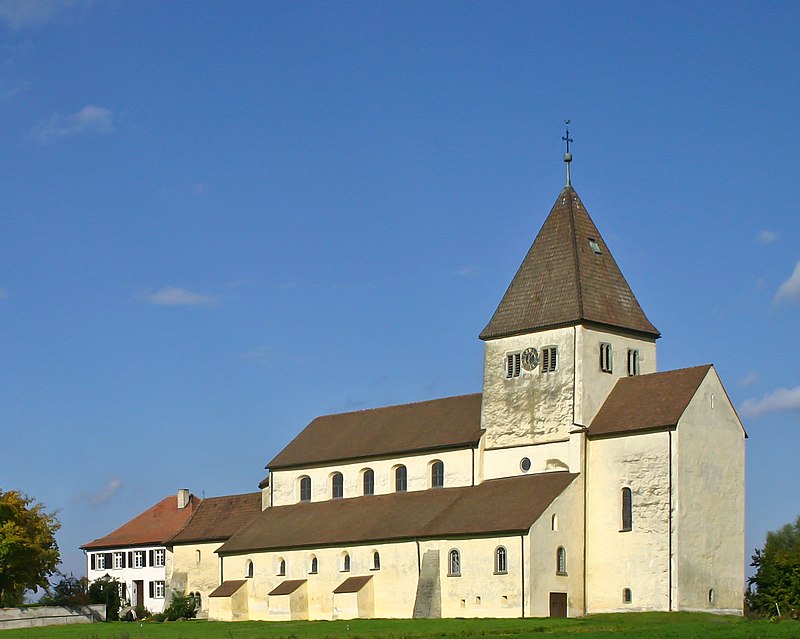
View of the church from the south. Photo Wikipedia
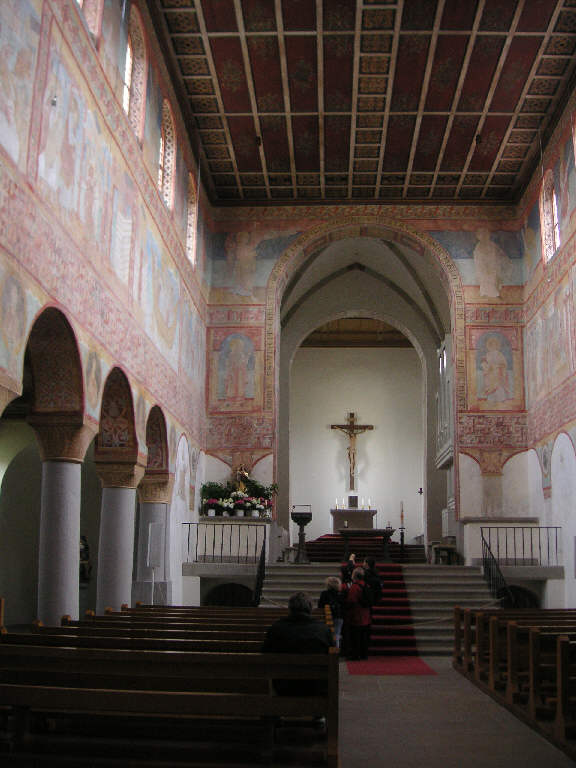
The oldest of the three churches on Reichenau Island. (890) with rich Romansque frescoes from the 10th cent. Photo by ochmann
Más sobre Reichenau Oberzell 890
71: Georgia, Sioni-Kazbegi, Basilica 9th cent
This marker is part of an illustrated Survey of Romanesque Architecture, 300 to 1300 AD. To see and read all comments you have to download the post to your hard disk.
Georgia, Sioni-Kazbegi, Basilica 9th cent
Sioni in its spectacular mountain setting on the Georgian Military Road boasts a watchtower and a rare 9th-century basilica (on ledge above the village)
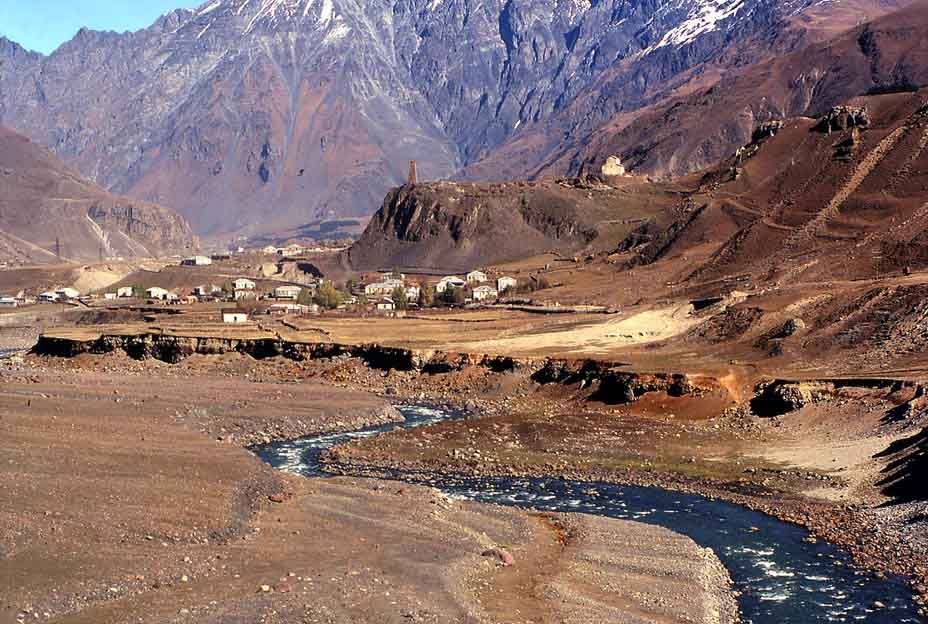
Más sobre Georgia, Sioni-Kazbegi, Basilica 9th cent
72: France, Abbaye de Cluny 910
This marker is part of an illustrated Survey of Romanesque Architecture, 300 to 1300 AD. To see and read all comments you have to download the post to your hard disk.
France, Abbaye de Cluny 910
was founded in 910 by William I, Count of the Auvergne, who installed Abbot Berno and placed the abbey under the immediate authority of Pope Sergius III.
The Benedictine order was a keystone to the stability that European society achieved in the 11th century, and partly owing to the stricter adherence to a reformed Benedictine rule, Cluny became the acknowledged leader of western monasticism from the later 10th century. A sequence of highly competent abbots of Cluny were statesmen on an international stage. The monastery of Cluny itself became the grandest, most prestigious and best endowed monastic institution in Europe. The height of Cluniac influence was from the second half of the 10th century through the early 12th. The Abbey was sacked and mostly destroyed in 1790 by a mob of revolutionaries. Only a small part of the original remains.

Photo by yves_grau, Panoramio
Más sobre France, Abbaye de Cluny 910
73: Spain, Escalada San Miguel 913
This marker is part of an illustrated Survey of Romanesque Architecture, 300 to 1300 AD. To see and read all comments you have to download the post to your hard disk.
Escalada Monasterio de San Miguel 913

Following a period of Arab sovereignty, the Asturian King, Alfonso III conquered the region of Leon. The Mozarabic church at San Miguel de Escalada was commissioned in 913 under the rule of Alfonso's son, Garcia. This brick and masonry church features a basilica plan with its central nave partitioned from the two side aisles and the apse by colonnades of horseshoe arches. The Asturian Corinthian capitals and possibly Roman or Visigothic columns may already have been in situ. Photo from thais.it/architettura/romanica/
Más sobre Spain, Escalada San Miguel 913
74: Spain, Jaca, Monastery San Juan de la Peña 920
This marker is part of an illustrated Survey of Romanesque Architecture, 300 to 1300 AD. To see and read all comments you have to download the post to your hard disk.
Jaca, Monastery San Juan de la Peña 920

The ruined cloisters. Photo by Gerhard Tinhof, Panoramio
Más sobre Spain, Jaca, Monastery San Juan de la Peña 920
75: Turkey, Lake Van, Akhtamar, 920
This marker is part of an illustrated Survey of Romanesque Architecture, 300 to 1300 AD. To see and read all comments you have to download the post to your hard disk.
Turkey, Lake Van, Akhtamar, 920
The Armenian Church at Akhtamar was built by King Gagik Ardzrouni in 920. Its sculptures are the only remnant of the former splendor. Everywhere fruit trees were blooming
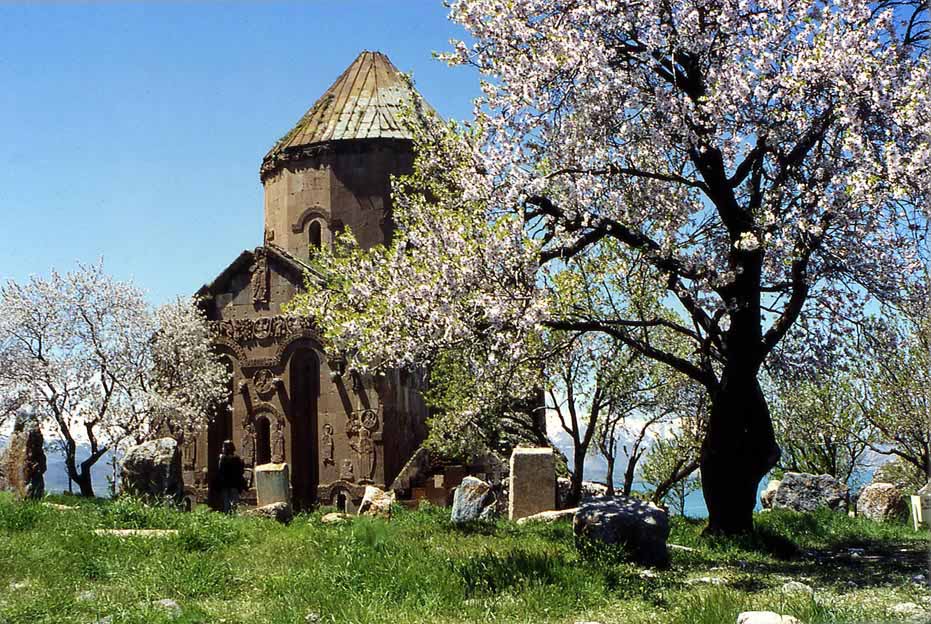
View of the east façade of the church towards the mountains along the south shore.
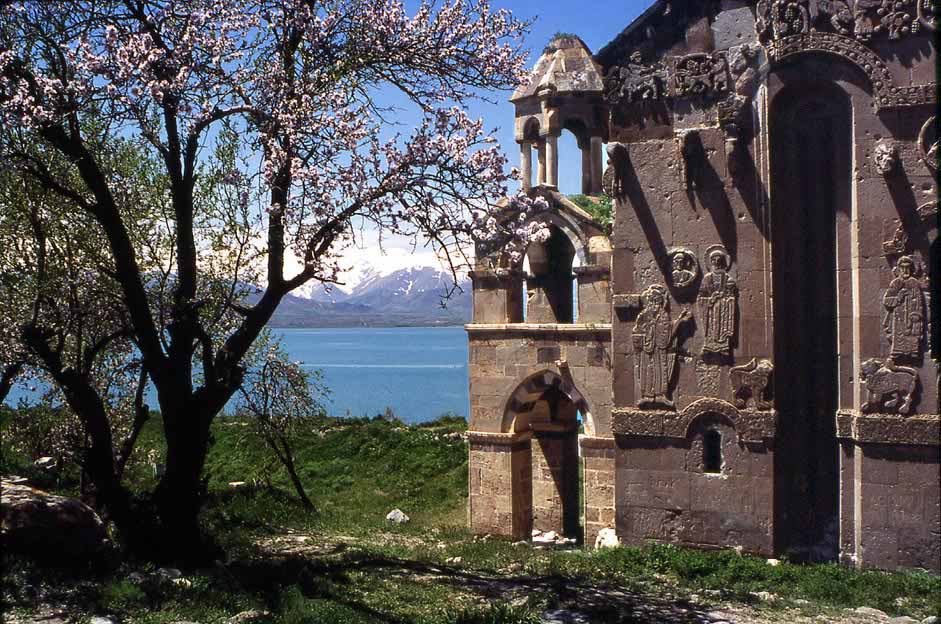
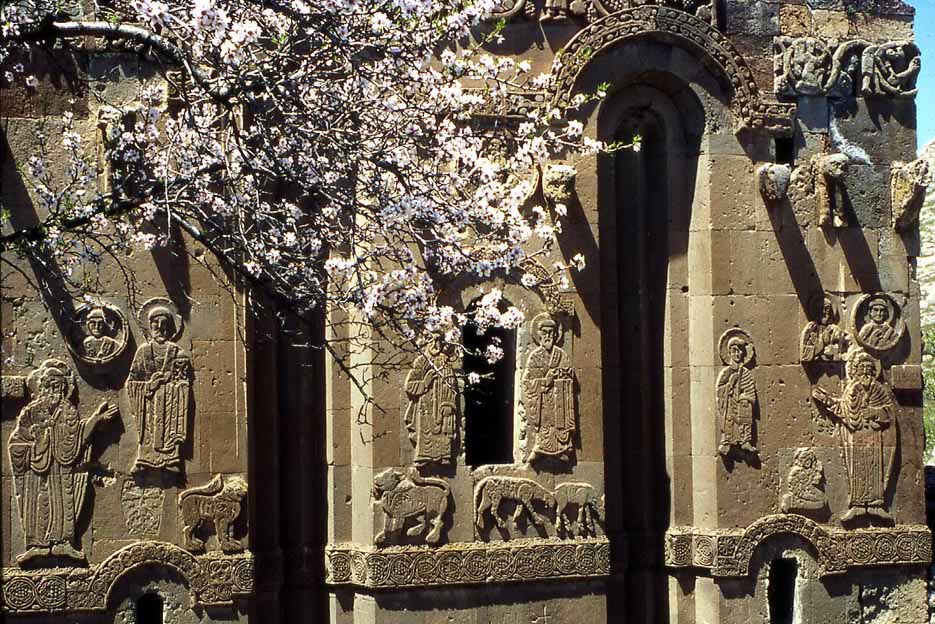
Wily David and a Byzantine Goliath in full armor.
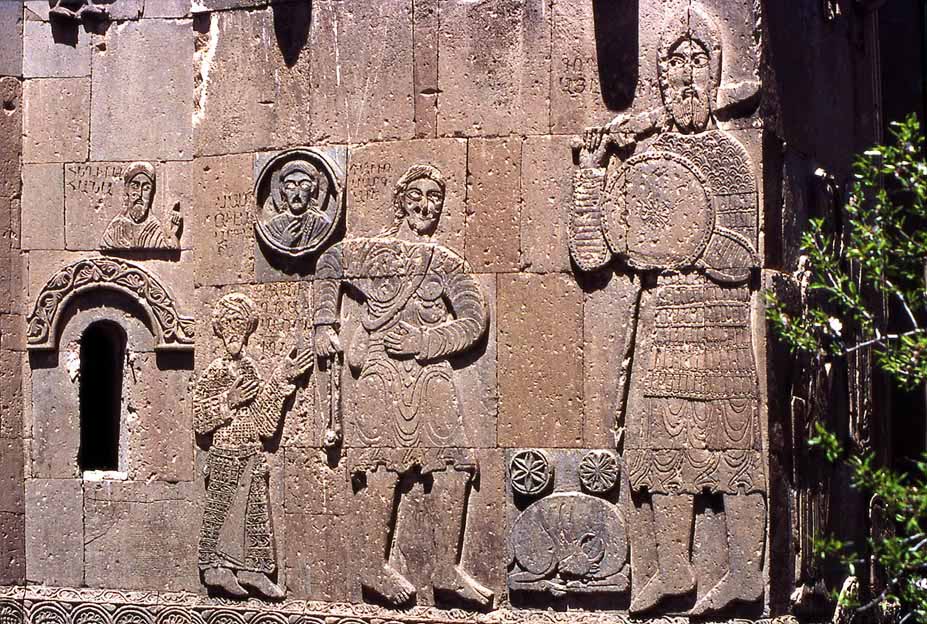
After having been regurgitated by the whale, Jonas sleeps in a vineyard and then preaches to the King of Niniveh, which is very close, due south from here.
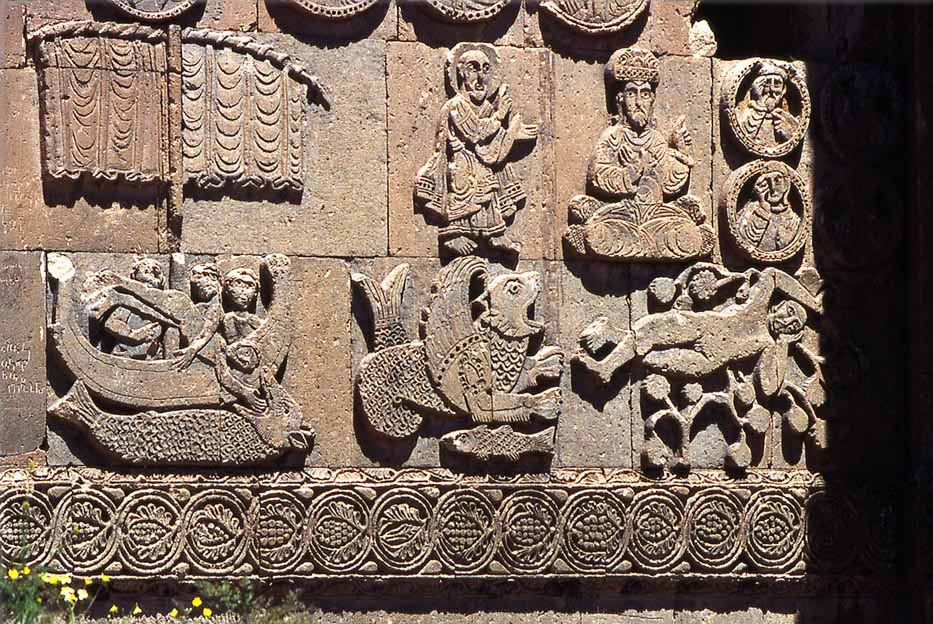
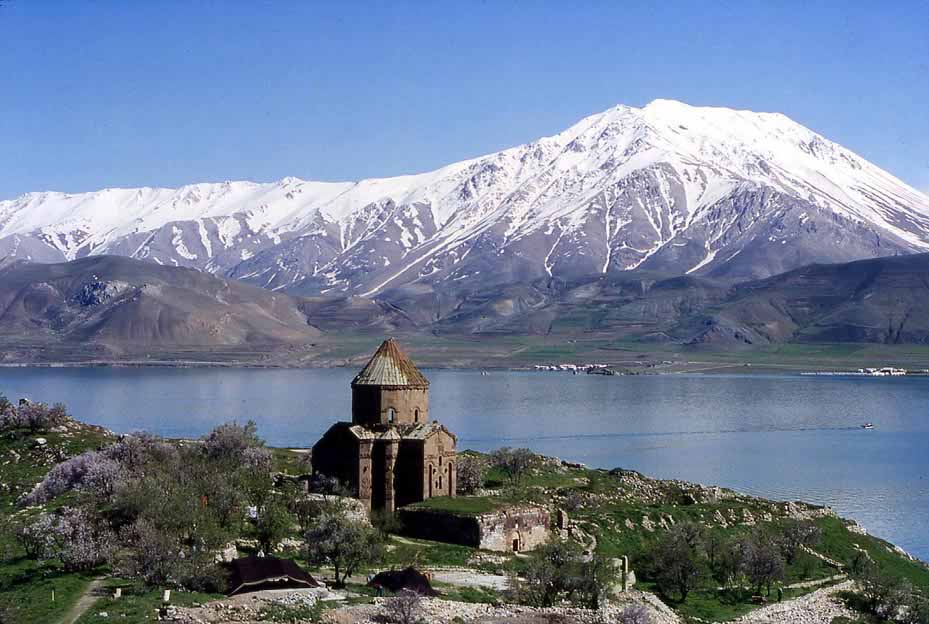
Más sobre Turkey, Lake Van, Akhtamar, 920
76: Spain, Ponferrada, Santiago de Peñalba 930
This marker is part of an illustrated Survey of Romanesque Architecture, 300 to 1300 AD. To see and read all comments you have to download the post to your hard disk.
Spain, Ponferrada, Santiago de Peñalba 930
Santiago de Peñalba church is one of the Mozarabic architectural jewels. It's situated in the Valle del Silencio (Silence Valley) in the Leonese region of El Bierzo close to Ponferrada in León (Spain). The Valle del Silencio area was full of sanctuaries and monasteries since the 8th century. That's why it was called "La Tebaida Berciana" (Bercian Thebaid).
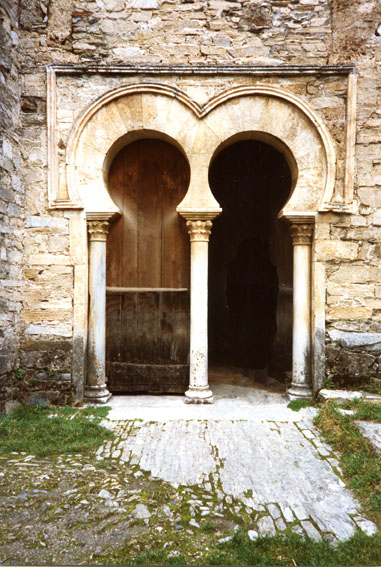
Photo Wikipedia
Más sobre Spain, Ponferrada, Santiago de Peñalba 930
77: Spain, San Cebrián de Mazote, Visigoth-Mozarabic 915
This marker is part of an illustrated Survey of Romanesque Architecture, 300 to 1300 AD. To see and read all comments you have to download the post to your hard disk.
Spain, San Cebrián de Mazote, Valldolid, Mozarab before 915

Photo romanicozamorano.com
Más sobre Spain, San Cebrián de Mazote, Visigoth-Mozarabic 915
78: Caoppadicia, Caves of Cavusin 10th cent
This marker is part of an illustrated Survey of Romanesque Architecture, 300 to 1300 AD. To see and read all comments you have to download the post to your hard disk.
The Caves of Cavusin. 10th cent
In Çavusin lives only one family and the guardian of the church, the frescoes of which are among the most extensive and best preserved in Cappadocia. The church was dedicated in 969 by Nikephoros Phokas who also founded the Great Lavra, the oldest monastery on Athos (962). He was a very successful admiral and by the grace of the Empress for a brief time Emperor of Byzantium (963-69) — before she had him killed by his successor in her bed, the Armenian Tsimiskes (969-76).... The apogee of Byzantine history.....
Hewn from the rock the cave church is very dark and photographing difficult (absolutely no flash!). The only reason to preserve the frescoes of the 10th to 12th century is for the tourist. Neither the locals nor the government has much interest in these Christian paintings. - A Last Supper above the entrance door - much like in Khintsvisi in Georgia.
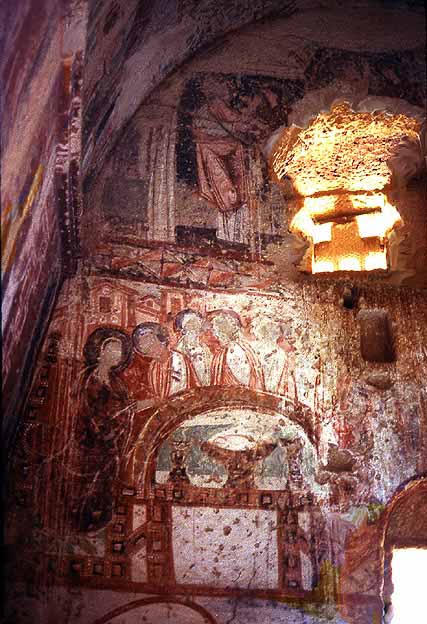
In the vault Christ is being elevated by four angels. The close relationship between Georgian and Cappadocia frescoes is noticeable everywhere.
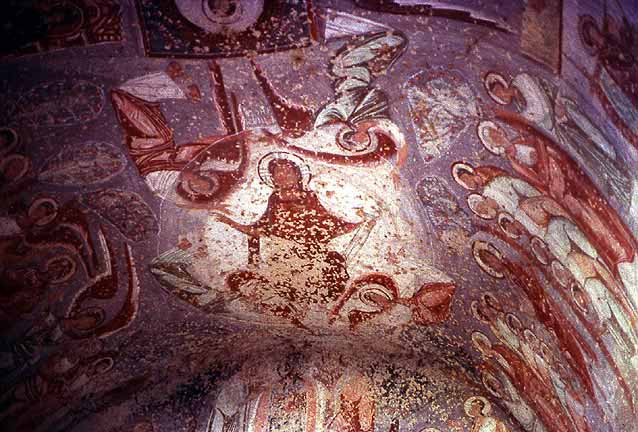
Christ flanked by the twelve apostles and two other saints attended by angels in a, for me unidentifiable, scene.
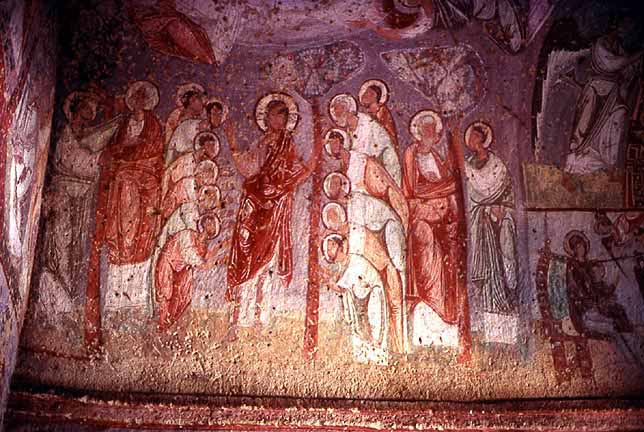
Photos by RWFG
Más sobre Caoppadicia, Caves of Cavusin 10th cent
79: Netherlands, Maastricht Onze Lieve Vrouwen 950
This marker is part of an illustrated Survey of Romanesque Architecture, 300 to 1300 AD. To see and read all comments you have to download the post to your hard disk.
Maastricht Onze Lieve Vrouwenkerk 10th cent
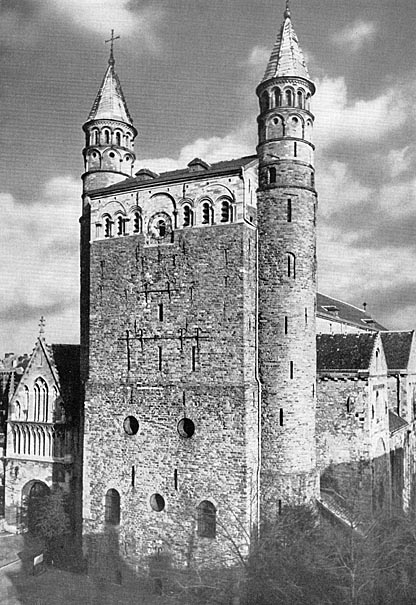
The forbidding facade of the church.
Más sobre Netherlands, Maastricht Onze Lieve Vrouwen 950
80: Germany, Cologne, St Pantaleon 960
This marker is part of an illustrated Survey of Romanesque Architecture, 300 to 1300 AD. To see and read all comments you have to download the post to your hard disk.
Germany, Cologne, St Pantaleon 960

Photo by b-f-g, Panoramio
Más sobre Germany, Cologne, St Pantaleon 960
81: Spain, Montbui La Tossa 970
This marker is part of an illustrated Survey of Romanesque Architecture, 300 to 1300 AD. To see and read all comments you have to download the post to your hard disk.
Montbui, La Tossa 970
The chapel
Interior of the chapel. Photo castells, picasaweb
Más sobre Spain, Montbui La Tossa 970
82: Germany, Mainz, Cathedral St. Martin 976
This marker is part of an illustrated Survey of Romanesque Architecture, 300 to 1300 AD. To see and read all comments you have to download the post to your hard disk.
Germany, Mainz, Cathedral St. Martin 976

The church seen from the cloisters. Photo by Stone-ssjq, Panoramio
Más sobre Germany, Mainz, Cathedral St. Martin 976
83: Italy, Lonato, Chiesa di San Zeno 977-1045
This marker is part of an illustrated Survey of Romanesque Architecture, 300 to 1300 AD. To see and read all comments you have to download the post to your hard disk.
Italy, Lonato, Chiesa di San Zeno, 977-1045

Photo Thaïs.it
Más sobre Italy, Lonato, Chiesa di San Zeno 977-1045
84: Armenia, Sanhin Monastery 970
This marker is part of an illustrated Survey of Romanesque Architecture, 300 to 1300 AD. To see and read all comments you have to download the post to your hard disk.
Armenia, Sanahin Monastery 970
The monasteries are situated in the north of Armenia, in the Tumanian district. Sanahin is now within the limits of Alaverdi city, and Haghpat is to the north-east of it, in the village of the same name. Standing on a high plateau, amidst low structures, they rise sharp against the background of steep forest-grown slopes of Bazum ridge. The ensembles are complemented by small churches built near them.
The exact date of the foundation of Sanahin and Haghpat is unknown. Documentary evidence and monuments of material culture suggest that these structures date back to the middle of the 10th century. The formation of Tashir-Dzoraget kingdom of the Kyurikids in 979 and the great attention paid to Sanahin and Haghpat by various rulers of Armenia and their vassals favored the construction of many religious and civil structures there. In these monasteries, especially in Sanahin, humanitarian sciences and medicine were studied, scientific treatises written and paintings, most miniatures, created.

Photo Forum.hyeclub.com
Más sobre Armenia, Sanhin Monastery 970
85: Tao-Klarjeti, Okhta Eklesia 980
This marker is part of an illustrated Survey of Romanesque Architecture, 300 to 1300 AD. To see and read all comments you have to download the post to your hard disk.
Otkhta Eklesia (Dörtkilise)
Tao-Klarjeti, Turkey
3-nave Basilika and Convent for Nuns of Otkhta Eklesia, 980
Built by King David III Kuropalates
The convent
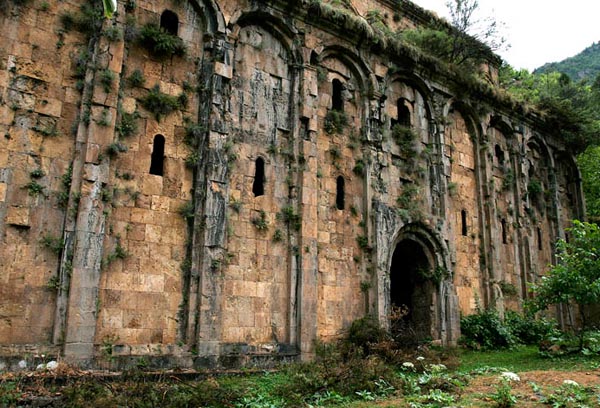
Más sobre Tao-Klarjeti, Okhta Eklesia 980
86: Spain, La Roja, San Millán de la Cogolla, Suso 984
This marker is part of an illustrated Survey of Romanesque Architecture, 300 to 1300 AD. To see and read all comments you have to download the post to your hard disk.
Spain, La Roja, San Millán de la Cogolla, Suso 984
The monastic community founded by St Millán in the mid-6th century (visigoth time) became a place of pilgrimage. A fine Romanesque church built in honour of the holy man still stands at the site of Suso. It was here that the first literature was produced in Castilian, from which one of the most widely spoken languages in the world today is derived

Photo by magoncan, Panoramio
Suso church was consecrated in 984. It has a simple exterior, but it hides a surprise: decidedly Mozarab arches,

Photo Wikipedia
Más sobre Spain, La Roja, San Millán de la Cogolla, Suso 984
87: France, Abbaye St. Michael de Cuxa 10 cent
This marker is part of an illustrated Survey of Romanesque Architecture, 300 to 1300 AD. To see and read all comments you have to download the post to your hard disk.
Abbaye St. Michael de Cuxa 10th cent.

Photo by Nick Ayres, Panoramio
The cloisters

Photo by Michel Ciria, Panoramio
Más sobre France, Abbaye St. Michael de Cuxa 10 cent
88: Tao-Klarjeti, Khakhuli 10th cent.
This marker is part of an illustrated Survey of Romanesque Architecture, 300 to 1300 AD. To see and read all comments you have to download the post to your hard disk.
Tao-Klarjeti, Turkey, Cathedral of Khakhuli 10th cent
The exact location of the placemarker is uncertain.
Supposedly the church is well preserved. Its fame, however, is due to the magnificent gold icon in the Tbilisi National Museum.A piece sine-qua-non among Georgian icons. The gilded-silver Khakhuli Triptych of the Virgin, 147cm x 202 cm when opened, embellished with numerous enamel plaques from earlier centuries, precious stones, filigree ornaments, and pearls. The icon of the Virgin at its center is lost, only her enamel(!) hands and face survive. It was once the largest (54 x 41cm) cloisonné enamel in existence. The triptych was commissioned by King Demetre I in 1130.

Photo from Rolf Gross, Georgian Gold Treasures
Más sobre Tao-Klarjeti, Khakhuli 10th cent.
89: Poitiers Saint Hilaire le Grand 10th cent
This marker is part of an illustrated Survey of Romanesque Architecture, 300 to 1300 AD. To see and read all comments you have to download the post to your hard disk.
Poitiers, Saint Hilaire-le-Grand 10th cent
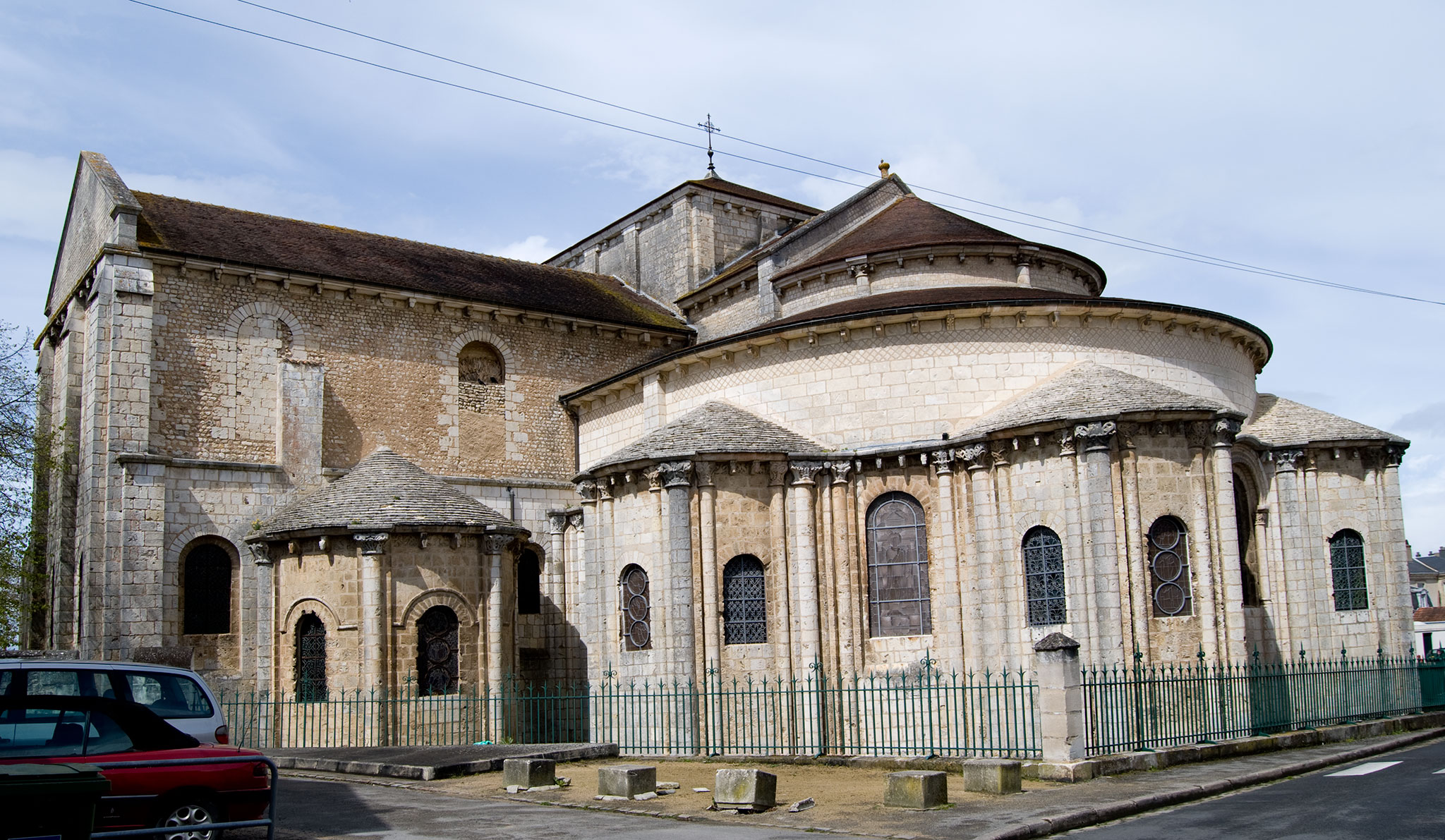
Photo Wikepedia
Más sobre Poitiers Saint Hilaire le Grand 10th cent
90: Spain, Leon, Basilica of San Isidoro 10th cent
This marker is part of an illustrated Survey of Romanesque Architecture, 300 to 1300 AD. To see and read all comments you have to download the post to your hard disk.
Leon, Basilica of San Isidoro 10th cent

Photo by [ Froilán López ] Panoramio
Más sobre Spain, Leon, Basilica of San Isidoro 10th cent
91: Turkey, Ani, 10th cent
This marker is part of an illustrated Survey of Romanesque Architecture, 300 to 1300 AD. To see and read all comments you have to download the post to your hard disk.
Once mighty Ani, the city of 100 churches, 10th cent
Together with Trabzon, Merv-Mary, Marikanda-Samarkand, and Karakhoto near Turpan,
China, Ani was once a rich and important city along the Silk Road. Marco Polo slept here. Ani was first destroyed by the Selçuks in the 11th, a second time by Timur Tamerlane in the 13th century, finally an earthquake leveled it for good. In between it was for a while the capital of the Armenian kings, and the Armenians still consider "the City of a Hundred Churches" their holy shrine. Since the Russo-Turkish war of 1918 and especially in the 1960s it had been inaccessible to foreigners. For the first time one could visit it on one's own without a military escort.
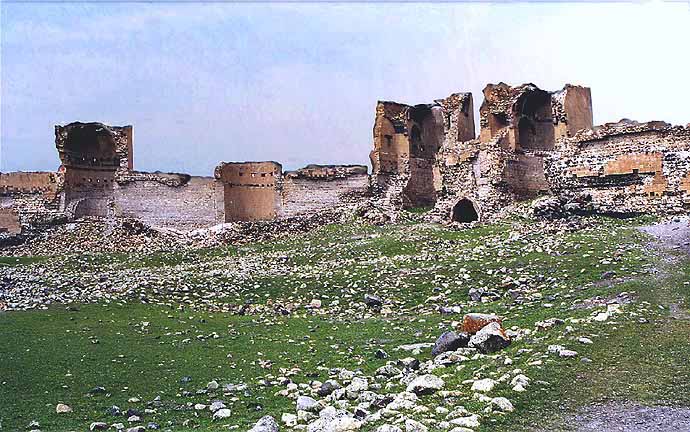
Unexcavated and neglected, there is not much to see. On a triangular plateau between two rivers covered with rubble three churches — easily identified by their careful masonry as Armenian — are still standing. This is Gagik's church of St. Gregory (1000)..

The high nave of the Armenian Cathedral (989-1010), unmistakably high-Armenian architecture...
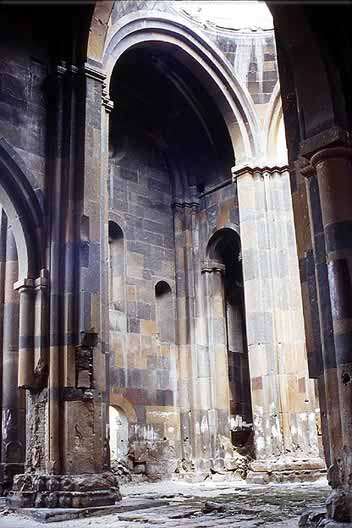
... and a third church of St. Gregory of the Abughamrents, resembling the church at Svarnots near Yerevan, Armenia.
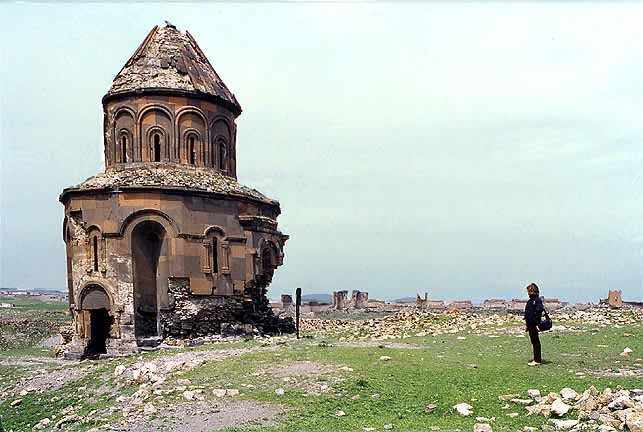
The maonastery of the Hripsimian Virgin in the gorge of the Arpaçay (Akhurian) river, the eastern border of Ani and of Turkey. The opposite bank is Armenia and was once the Soviet Union. In the distance one can see, once again, a flourishing Armenian town...
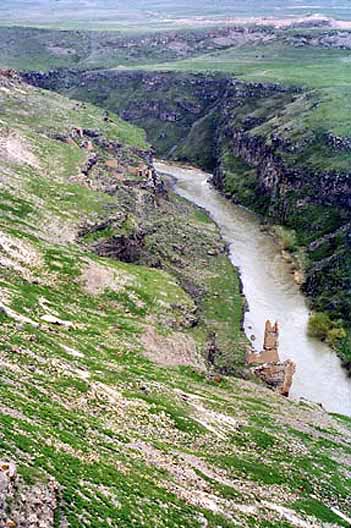
For a detailed historical map of Ani click here Ani Map
Más sobre Turkey, Ani, 10th cent
92: France, Abbaye Lessay 10th cent
This marker is part of an illustrated Survey of Romanesque Architecture, 300 to 1300 AD. To see and read all comments you have to download the post to your hard disk.
Abbaye Lessay 10th cent

Photo architecture.relig.free
Más sobre France, Abbaye Lessay 10th cent
93: France, Loches St. Ours 10-12th cent
This marker is part of an illustrated Survey of Romanesque Architecture, 300 to 1300 AD. To see and read all comments you have to download the post to your hard disk.
France, Loches Collegiata Church St. Ours 10-12th cent
The conical towers are reminiscent of Angulememe und other cathedrals in the south.

Más sobre France, Loches St. Ours 10-12th cent
94: Spain, Monastery of Leyre 10-16th cent
This marker is part of an illustrated Survey of Romanesque Architecture, 300 to 1300 AD. To see and read all comments you have to download the post to your hard disk.
Spain, Monastery of Leyre 10-16th cent

Photo by rmascarell, Panoramio
Más sobre Spain, Monastery of Leyre 10-16th cent
95: Switzerland, Romainmotier 1000
This marker is part of an illustrated Survey of Romanesque Architecture, 300 to 1300 AD. To see and read all comments you have to download the post to your hard disk.
Romainmotier 1000
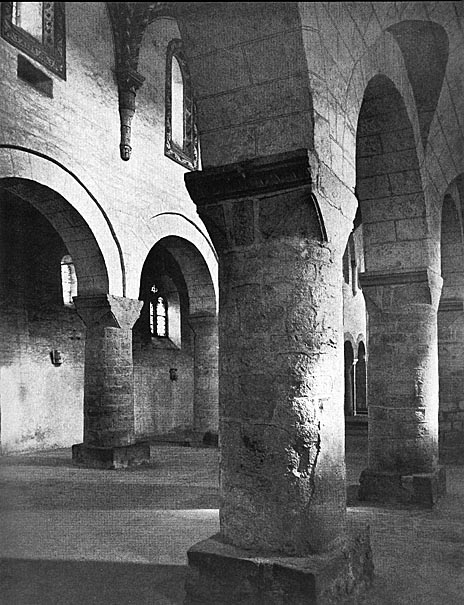
Early heavy columns
Más sobre Switzerland, Romainmotier 1000
96: Macedonia, St Panteleimon 10-13th cent
This marker is part of an illustrated Survey of Romanesque Architecture, 300 to 1300 AD. To see and read all comments you have to download the post to your hard disk.
Macedonia, St Panteleimon 10-13th cent(?) a recently excavated mosaic floor of a baptisterium may be from the 5th cent.
Much restored after 2005 this is one of the most sacred churches in Macedonia.

Photo by pkocovic, Panoramio
Más sobre Macedonia, St Panteleimon 10-13th cent
97: Italy, Genga, San Vittore 1007
This marker is part of an illustrated Survey of Romanesque Architecture, 300 to 1300 AD. To see and read all comments you have to download the post to your hard disk.
Abbazia di San Vittore alle Chiuse (San Vittore Terme-Genga) 1007 - 1011

Photo from thais.it/architettura/romanica/
Más sobre Italy, Genga, San Vittore 1007
98: France, Saint-Martin-du-Canigou 1009
This marker is part of an illustrated Survey of Romanesque Architecture, 300 to 1300 AD. To see and read all comments you have to download the post to your hard disk.
Saint-Martin-du-Canigou 1009

Photo Wikipewdia
Más sobre France, Saint-Martin-du-Canigou 1009
99: Germany, Hildesheim, St Michael 1001
This marker is part of an illustrated Survey of Romanesque Architecture, 300 to 1300 AD. To see and read all comments you have to download the post to your hard disk.
Germany, Hildesheim, St. Michaelis 1001-1033

Interior. Photo Thaïs.it
Más sobre Germany, Hildesheim, St Michael 1001
100: Spain, Santo Domingo de Silos Abbey 1000–1073
This marker is part of an illustrated Survey of Romanesque Architecture, 300 to 1300 AD. To see and read all comments you have to download the post to your hard disk.
Santo Domingo de Silos Abbey 1000–1073

Photo by robe, Panoramio
Más sobre Spain, Santo Domingo de Silos Abbey 1000–1073
101: Georgia, Mtskheta, Tsveti Shkhoveli Cathedral 1010-1029
This marker is part of an illustrated Survey of Romanesque Architecture, 300 to 1300 AD. To see and read all comments you have to download the post to your hard disk.
Before Tbilisi Mtskheta was the capital of the Georgian Kings. Their tombs are still in Tsveti Shkhoveli cathedral.
Tsveti Skhoveli the royal cathedral (1010-1029) with many later additions.
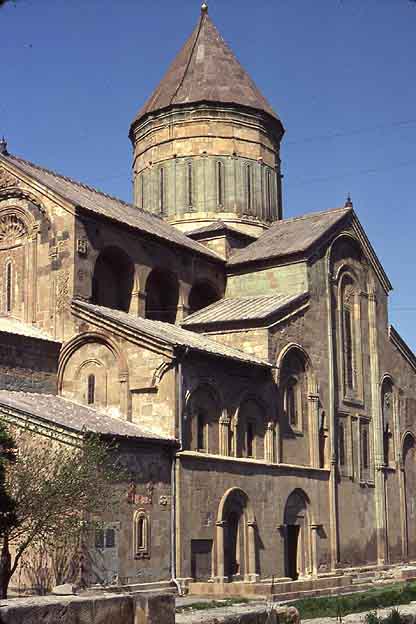
Más sobre Georgia, Mtskheta, Tsveti Shkhoveli Cathedral 1010-1029
102: Germany, Worms Dom St. Peter 1110, 1181-13th cent
This marker is part of an illustrated Survey of Romanesque Architecture, 300 to 1300 AD. To see and read all comments you have to download the post to your hard disk.
Germany, Worms Dom St. Peter 1110, 1181-13th cent
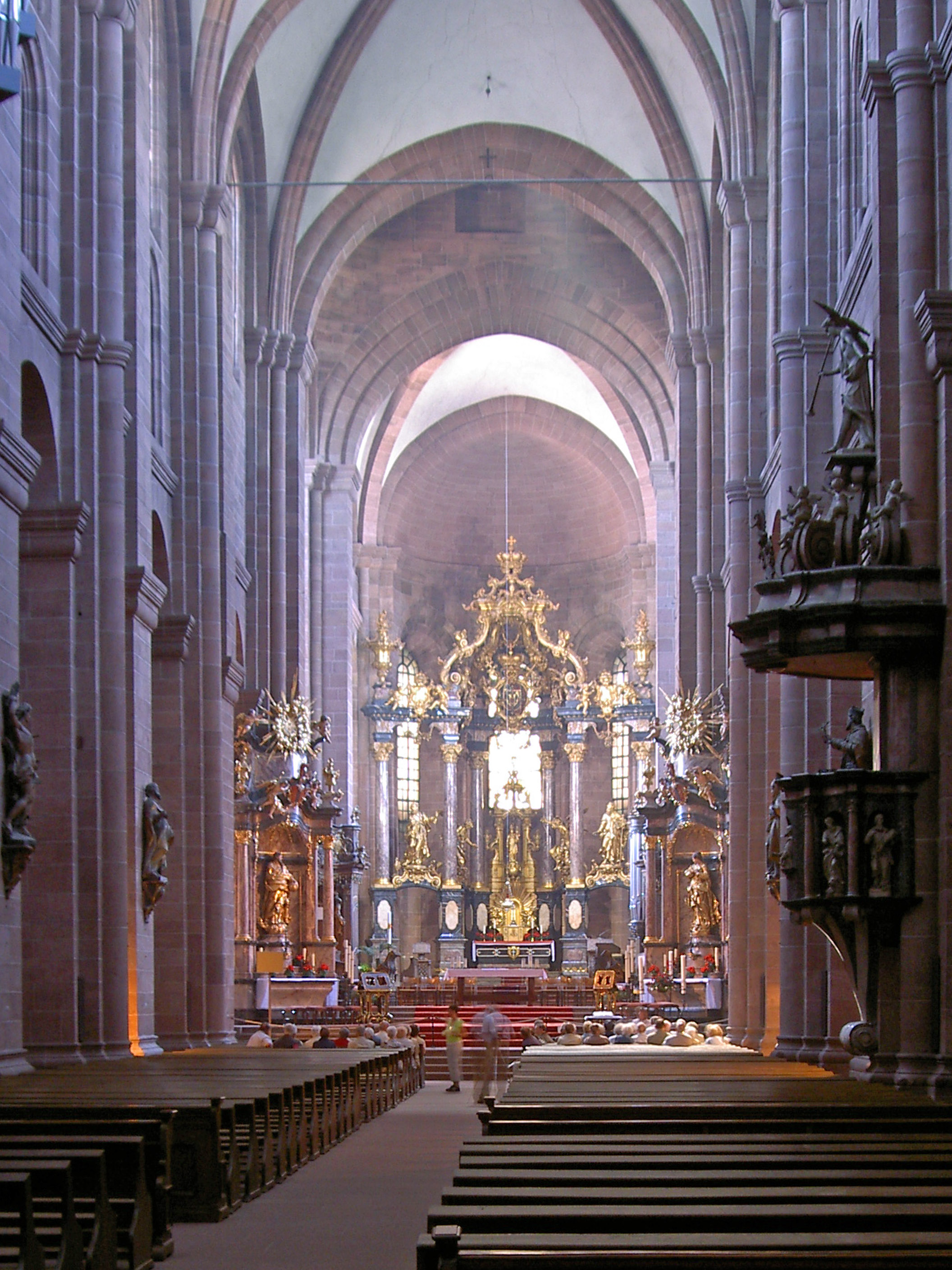
Interior view with Baroque altar. Photo Wikipedia
Más sobre Germany, Worms Dom St. Peter 1110, 1181-13th cent
103: France, Angouleme St. Pierre Cathedral 1017, 1128
This marker is part of an illustrated Survey of Romanesque Architecture, 300 to 1300 AD. To see and read all comments you have to download the post to your hard disk.
Aguleme St Pierre Cathedral 1017, 1128
Photo Wikipedia
Más sobre France, Angouleme St. Pierre Cathedral 1017, 1128
104: France, Conques 1030-1060
This marker is part of an illustrated Survey of Romanesque Architecture, 300 to 1300 AD. To see and read all comments you have to download the post to your hard disk.
Conques, Cathedral Ste. Foy 1030-1060
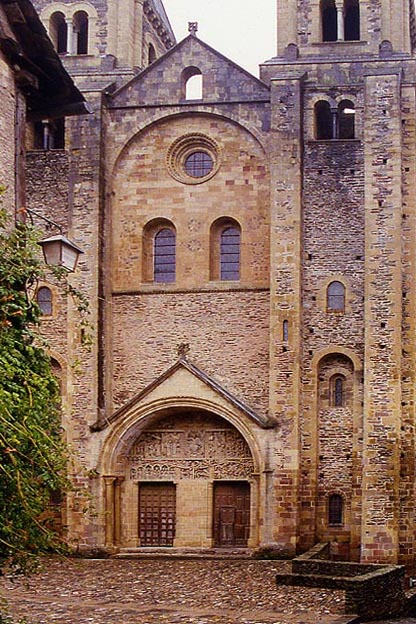
The Westfassade of the church
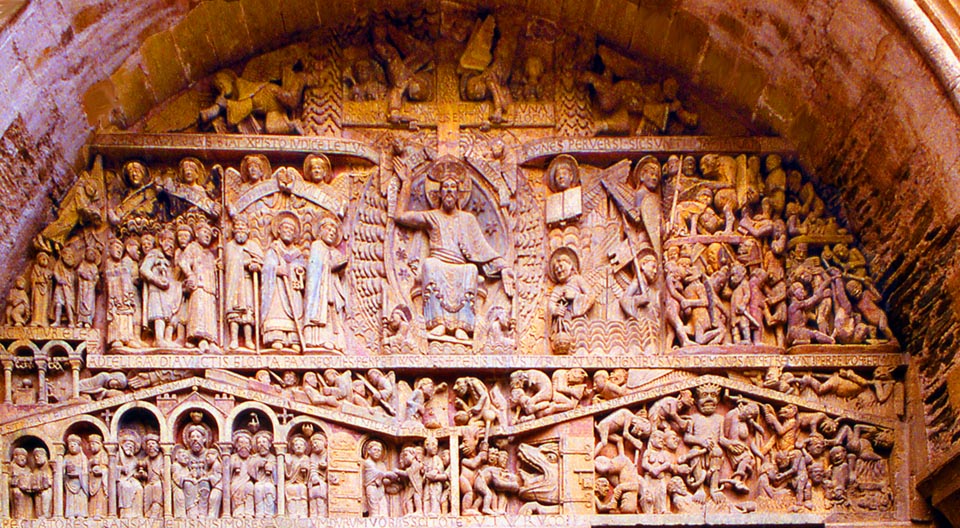
The tympanon above the entrance, the Second Coming of Christ, shows rare remnants of the gay, old coloration
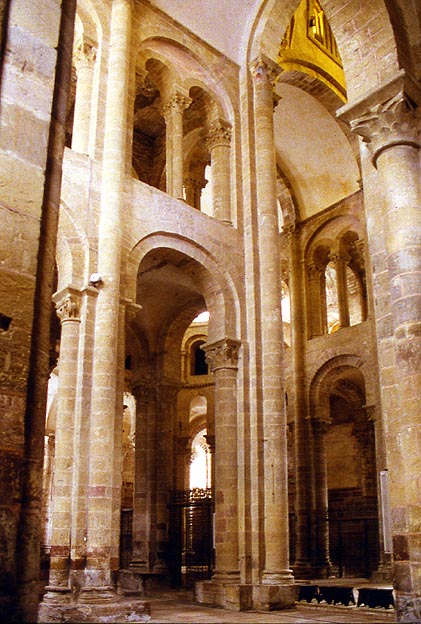
Interior, the transept.
Photos RWFG
Más sobre France, Conques 1030-1060
105: Ukraine, Kiev, Cathral Santa Sophia 1037-1057
This marker is part of an illustrated Survey of Romanesque Architecture, 300 to 1300 AD. To see and read all comments you have to download the post to your hard disk.
Ukraine, Kiev, Cathedral Santa Sophia 1037-1057
The first foundations were laid in 1037 but the cathedral took two decades to complete. On the inside, it retains mosaics and frescos from the eleventh century. Originally the cathedral was a burial place of the Kievan rulers including Vladimir Monomakh, Vsevolod Yaroslavich and of course the cathedral's founder Yaroslav I the Wise, although only the latter's grave survived to our days. After the pillaging of Kiev by Andrei Bogolyubsky of Vladimir-Suzdal in 1169 followed by Mongolian Tatars in 1240 the cathedral fell into disrepair.
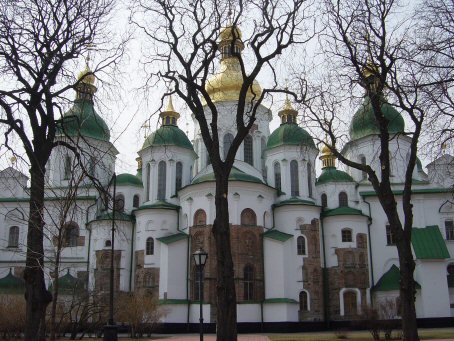
Photo Wikipedia
Más sobre Ukraine, Kiev, Cathral Santa Sophia 1037-1057
106: Russia, Novgorod, Cathedral of St. Sophia 1045 -1050
This marker is part of an illustrated Survey of Romanesque Architecture, 300 to 1300 AD. To see and read all comments you have to download the post to your hard disk.
Russia, Novgorod, Cathedral of St. Sophia 1045 -1050
The cathedral was built by Vladimir of Novgorod between 1045 and 1050, making it the oldest church building in Russia proper

Photo Wikipedia
Más sobre Russia, Novgorod, Cathedral of St. Sophia 1045 -1050
107: France, Vignory 1049-1059
This marker is part of an illustrated Survey of Romanesque Architecture, 300 to 1300 AD. To see and read all comments you have to download the post to your hard disk.
France, Vignory Saint-Etienne 1049-1059

L'église saint-Etienne de Vignory, consacrée à Saint-Etienne est un exemple rare et remarquable de transition de l'architecture carolingienne au style roman. La première pierre à été posée en 1032, par la volonté de Guy de Vignory, premier seigneur du nom. L'église saint-Etienne est l’un des rares édifices du nord de la France du tout début de l’ère romane qui a traversé l’histoire sans avoir subi de profonds remaniements (à l’exception d’ajout, aux XV-XVIème siècles, de cinq chapelles ouvrant sur le bas-côté sud de l’édifice).
Photo and text from thais.it/architettura/romanica/
Más sobre France, Vignory 1049-1059
108: Germany, Reichenau, Mittelzell 1048
This marker is part of an illustrated Survey of Romanesque Architecture, 300 to 1300 AD. To see and read all comments you have to download the post to your hard disk.
Reichenau Mittelzell former Benedictine monastery church St Maria and Markus 1048
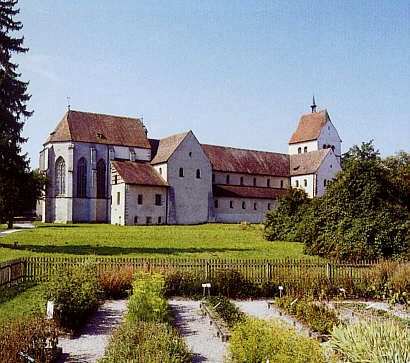
The church (1048 + 12th cent) with its high Gothic Choir (1550-55)
Interior: the preromanesque crypt. Photo castells, picasaweb
Más sobre Germany, Reichenau, Mittelzell 1048
109: Germany, Hirsau 1059
This marker is part of an illustrated Survey of Romanesque Architecture, 300 to 1300 AD. To see and read all comments you have to download the post to your hard disk.
Hirsau 1059

Ruins of the Benedictine monastery that was once among the most influential in Europe. Founded in about 830 by Count Erlafried of Calw and re-founded, after a period of decline, in 1059 by abbot William of Hirsau, who brought it to international prominence as the origin of the Hirsau Reforms. It was secularised in 1558, and the buildings were destroyed by the French in 1692.
Photo by Mast, Panoramio.
Más sobre Germany, Hirsau 1059
110: Spain, Estrella, San Miguel 11 cent
This marker is part of an illustrated Survey of Romanesque Architecture, 300 to 1300 AD. To see and read all comments you have to download the post to your hard disk.
Spain, Estrella, San Miguel

Photo by estudiooberon.com. Panoramio
Más sobre Spain, Estrella, San Miguel 11 cent
111: Istanbul, Pammakaristos Church - Fetiyeh Cami 11/12th cent
This marker is part of an illustrated Survey of Romanesque Architecture, 300 to 1300 AD. To see and read all comments you have to download the post to your hard disk.
Constantinople-Istanbul
Church of the Monastery of Pammakaristos - Fetiyeh Camii
11th or 12th cent

Text and photo Archnet.org
The fire of Balatkapi damaged the mosque in 1640. It was repaired in 1845, and finally restored in 1936-38. Abandoned after the restoration, the main space was re-opened to Islamic prayer only in 1960. The parekklesion, restored to its pre-Ottoman state by the Byzantine Institute of America, is now open to visitors as a museum. The obove photo shows mainly the parekklision with its copulas.
Más sobre Istanbul, Pammakaristos Church - Fetiyeh Cami 11/12th cent
112: France, Saint-Savin sur Gartempe 11th-12th century
This marker is part of an illustrated Survey of Romanesque Architecture, 300 to 1300 AD. To see and read all comments you have to download the post to your hard disk.
Abbey of Saint-Savin sur Gartempe 11th-12th century
The church of St. Savin seems to have been founded in the time of Charlemagne (747-814) after the miraculous discovery of the bodies of two 5th-century martyrs, Savin and Cyprian. The Abbey of Saint-Savin was rebuilt in the 11th century — this is the structure, with its 11th- and 12th-century murals, that stands today. It was further expanded in the 13th cent. The spire was added in the 14th century.

The abbey church.
Photo by Paul Kentish, Sacred-destinations.com
Más sobre France, Saint-Savin sur Gartempe 11th-12th century
113: Germany, Maria Laach 1100
This marker is part of an illustrated Survey of Romanesque Architecture, 300 to 1300 AD. To see and read all comments you have to download the post to your hard disk.
Maria Laach, Benedictine Abbey Church 1100-1300

Photo by japoo, Panoramio
Más sobre Germany, Maria Laach 1100
114: France, Mont Saint-Michel 1022
This marker is part of an illustrated Survey of Romanesque Architecture, 300 to 1300 AD. To see and read all comments you have to download the post to your hard disk.
France, Mont Saint-Michel Norman 1022-1135
One of the most touristy place in France. Photo ????????
Más sobre France, Mont Saint-Michel 1022
115: France, Poitiers Notre-Dame-la-Grande 1030
This marker is part of an illustrated Survey of Romanesque Architecture, 300 to 1300 AD. To see and read all comments you have to download the post to your hard disk.
Poitiers, Église Notre-Dame-la-Grande, 11th cent Byzantine

Photo culture.gouv.fr
Más sobre France, Poitiers Notre-Dame-la-Grande 1030
116: Italy, Aquileia, Cathedral 1031
This marker is part of an illustrated Survey of Romanesque Architecture, 300 to 1300 AD. To see and read all comments you have to download the post to your hard disk.
Italy, Aquileia, Cathedral 1031
The Cathedral of Aquileia is a flat-roofed basilica erected by Patriarch Poppo in 1031 on the site of an earlier church. It was internally rebuilt arpound 1379 in the Gothic style.

Photo by sundaysw.com, Panoramio
Más sobre Italy, Aquileia, Cathedral 1031
117: Germany, Hildesheim Dom 1020-1300
This marker is part of an illustrated Survey of Romanesque Architecture, 300 to 1300 AD. To see and read all comments you have to download the post to your hard disk.
Hildesheim Dom 1020 - 1300
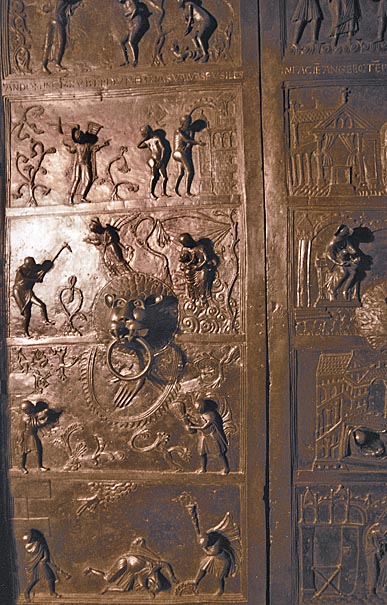
The bronze doors of St Bernhard 1050.

Interior. Photo Wikipedia
Más sobre Germany, Hildesheim Dom 1020-1300
118: France, Jumieges Abb. Notre Dame1037
This marker is part of an illustrated Survey of Romanesque Architecture, 300 to 1300 AD. To see and read all comments you have to download the post to your hard disk.
Jumieges, Abbey de Notre-Dame 1037 - 67

Photo by marc peltzer, Panoramio
Más sobre France, Jumieges Abb. Notre Dame1037
119: Germany, Würzburg, Dom 1040 - 1225
This marker is part of an illustrated Survey of Romanesque Architecture, 300 to 1300 AD. To see and read all comments you have to download the post to your hard disk.
Germany, Würzburg, Dom 1040 - 1225

The nave from the cloisters.
Photo by Klaus Rommel, Panoramio
Más sobre Germany, Würzburg, Dom 1040 - 1225
120: France, Tournus St Philibert 10-11thcent
This marker is part of an illustrated Survey of Romanesque Architecture, 300 to 1300 AD. To see and read all comments you have to download the post to your hard disk.
France, Tournus St Philibert 10th-11th cent
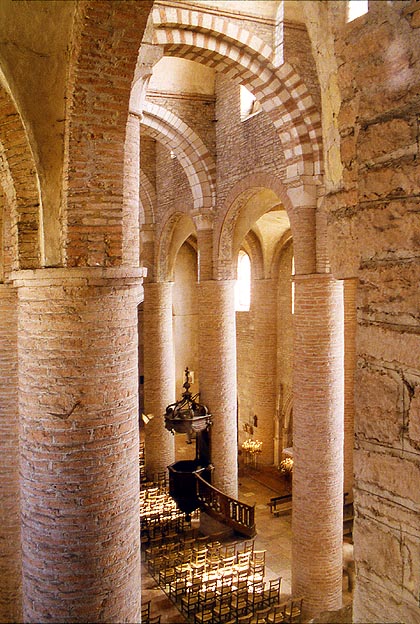
Church of St Philibert (10.-11.cent) argueably one of the most beautiful churches of Romanesque France.
Photo RWFG
Más sobre France, Tournus St Philibert 10-11thcent
121: Georgia, Alaverdi Cathedral 11th cent
This marker is part of an illustrated Survey of Romanesque Architecture, 300 to 1300 AD. To see and read all comments you have to download the post to your hard disk.
The tall white building of the 11th-century cathedral of Alaverdi rises above the Kakhetian vinyards . Famous for is proportions: the over-high nave is reminiscent the contemporary churches of the French Gothic. - A Persian potentate who made Alaveri his abode, erected the 17th-century fortifications During his reign Alaverdi's frescoes disappeared except for a "Mother of God" (12th cent) in the apse.
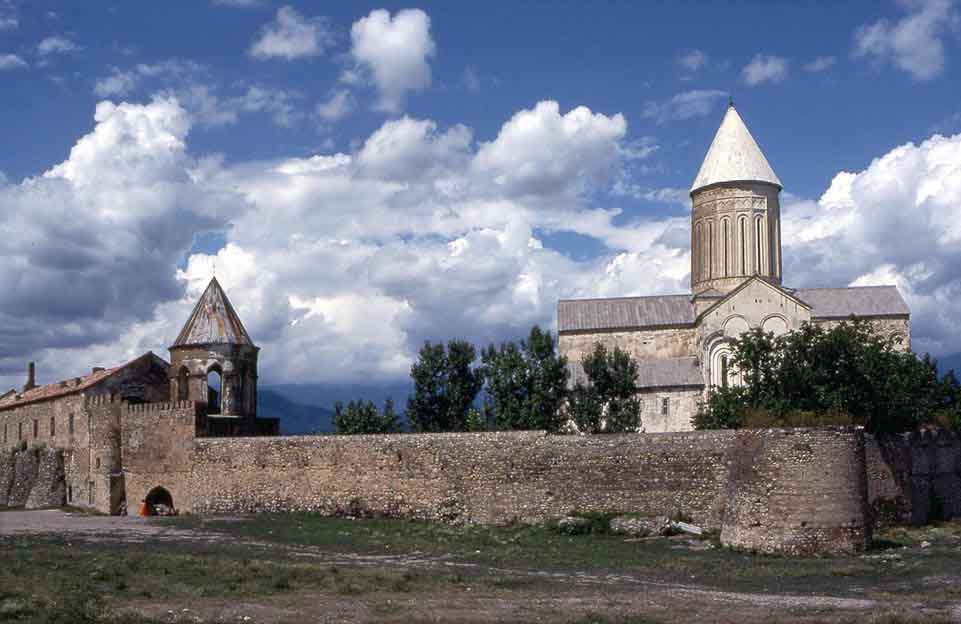
Más sobre Georgia, Alaverdi Cathedral 11th cent
122: France, Caen Abbeye aux Dames 1057
This marker is part of an illustrated Survey of Romanesque Architecture, 300 to 1300 AD. To see and read all comments you have to download the post to your hard disk.
France, Caen Abbeye aux Dames 1057 Norman built by William the Conqueror's wife

Photo by Aurélien Knockaert, Panoramio
Más sobre France, Caen Abbeye aux Dames 1057
123: France, Saint Benoit sur Loire 1073
This marker is part of an illustrated Survey of Romanesque Architecture, 300 to 1300 AD. To see and read all comments you have to download the post to your hard disk.
France, Saint-Benoit-sur-Loire 1073
One of the most important Benedictine monasteries in France. Begun in the 7th cent, plundered and burned by the Normans, later invaders, and the French Revolution, the Cathedral of Our Lady is all that remains. St Benedict is buried here.

View of the church from the south. The unique truncated tower serves also as entry hall.

The church shares the elegant, narrow, high nave with the Burgundian churches of the same era.

Main side entrance Photos Panoramio
Más sobre France, Saint Benoit sur Loire 1073
124: France, Caen, St. Etienne Abbaye aux Hommes 1057
This marker is part of an illustrated Survey of Romanesque Architecture, 300 to 1300 AD. To see and read all comments you have to download the post to your hard disk.
Caen, St. Etienne Abbaye aux Hommes. Normannic church built by William the Conqueror 1057, who is burried there.

Photo by Rafel Sabater, Panoramio
Más sobre France, Caen, St. Etienne Abbaye aux Hommes 1057
125: Spain, Fromista, St. Martin de Tours 1066-
This marker is part of an illustrated Survey of Romanesque Architecture, 300 to 1300 AD. To see and read all comments you have to download the post to your hard disk.
Fromista the curch of St. Martin of Tours 1066, reconstructed in the 12th and 13th cent and restored in the 19th cent.

Photo by nacho riestra, Panoramio
Más sobre Spain, Fromista, St. Martin de Tours 1066-
126: Germany, Cologne, St Gereon 1067 - 1227
This marker is part of an illustrated Survey of Romanesque Architecture, 300 to 1300 AD. To see and read all comments you have to download the post to your hard disk.
Cologne St Gereon 1067 - 1227
Begun in 1067, it features the largest dome in the Occident built in the time between the erection of the Hagia Sophia and the Florence Duomo. The oval dome, being 21.0 m long and 16.9 m wide, was completed in 1227 on the remains of Roman walls, which are still visible. The dome is also notable for its rare decagonal structure.
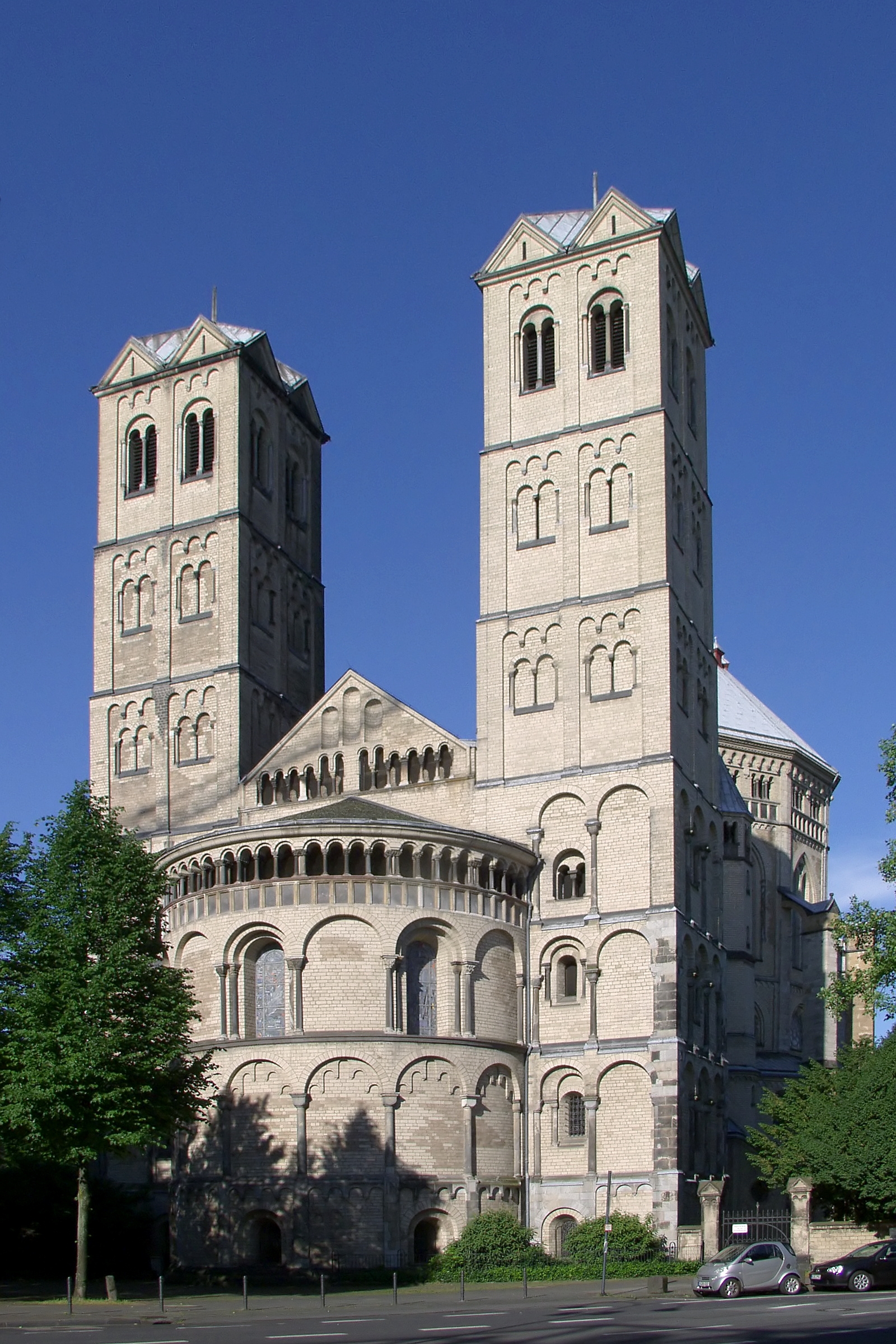
St. Gereon, Photo Wikipedia
Más sobre Germany, Cologne, St Gereon 1067 - 1227
127: France, Anzy-le-Duc Monastery church 1070
This marker is part of an illustrated Survey of Romanesque Architecture, 300 to 1300 AD. To see and read all comments you have to download the post to your hard disk.
France, Anzy-le-Duc Monastery church 1070
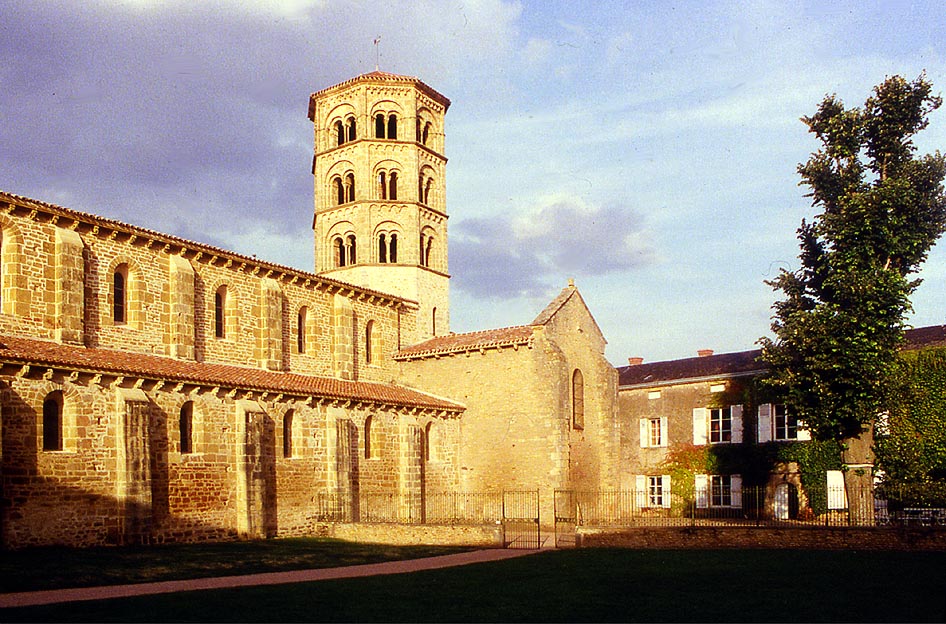
Former Cluniacensian monastery church in this tiny hamlet is built from a deeply honey colored stone that glowed in the afternoon light. Exceptionally well preserved sculptures. Its floorplan followed almost exactly that of Charlieu and became the origin of the floorplan of Vezelay all in the spirit of Cluny. Photo RWFG
Más sobre France, Anzy-le-Duc Monastery church 1070
128: Germany, Gandersheim Stiftskirche 1070
This marker is part of an illustrated Survey of Romanesque Architecture, 300 to 1300 AD. To see and read all comments you have to download the post to your hard disk.
Germany, Gandersheim Stiftskirche 1070

Thaïs, architettura
Más sobre Germany, Gandersheim Stiftskirche 1070
129: Spain, Santiago de Compostela 1075, 16-18th cent
This marker is part of an illustrated Survey of Romanesque Architecture, 300 to 1300 AD. To see and read all comments you have to download the post to your hard disk.
Santiago de Compostela
was the destination of the most famous pilgrims routes in the European Middle Ages. Construction of the present cathedral began in 1075 under the reign of Alfonso VI of Castile. It was enlarged during the 16th-18th cent.

Photo Wikipedia
Más sobre Spain, Santiago de Compostela 1075, 16-18th cent
130: England, Winchester Cathedral 1079-93
This marker is part of an illustrated Survey of Romanesque Architecture, 300 to 1300 AD. To see and read all comments you have to download the post to your hard disk.
Winchester Cathedral Norman 1079-93

Photo wikipedia
Más sobre England, Winchester Cathedral 1079-93
131: Germany, Speyer Dom before 1080
This marker is part of an illustrated Survey of Romanesque Architecture, 300 to 1300 AD. To see and read all comments you have to download the post to your hard disk.
Speyer Dom, before 1080

Photo by Alberto Segovia, Panoramio
Más sobre Germany, Speyer Dom before 1080
132: Italy, Bari, Cathedral St. Nicolas 1087-1197
This marker is part of an illustrated Survey of Romanesque Architecture, 300 to 1300 AD. To see and read all comments you have to download the post to your hard disk.
Italy, Bari, Cathedral St. Nicolas 1087-1197
The basilica was built between 1087 and 1197, during the Italo-Norman domination of Apulia, the area previously occupied by the Byzantine Catapan of which Bari was the seat. Its foundation is related to the stealing of the relics of St. Nicholas from the saint’s original shrine in Myra, in what is now Turkey.
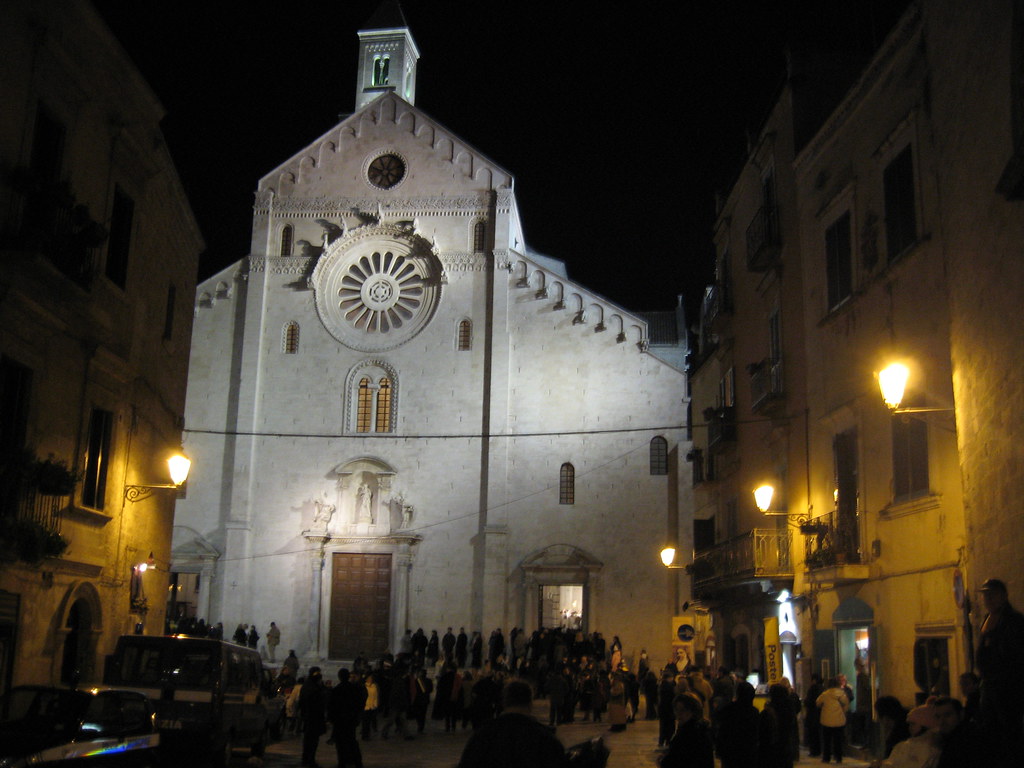
Photo By Dean Christakos
Más sobre Italy, Bari, Cathedral St. Nicolas 1087-1197
133: Italy, Otranto Cathedral S Annunziata 1088
This marker is part of an illustrated Survey of Romanesque Architecture, 300 to 1300 AD. To see and read all comments you have to download the post to your hard disk.
Italy, Otranto Cathedral S Annunziata 1088,
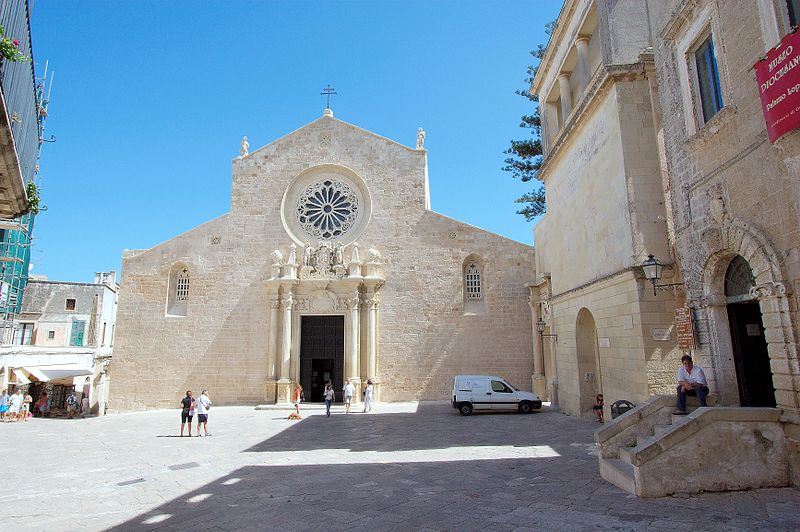
The cathedral has a unique floor mosaic 1166,
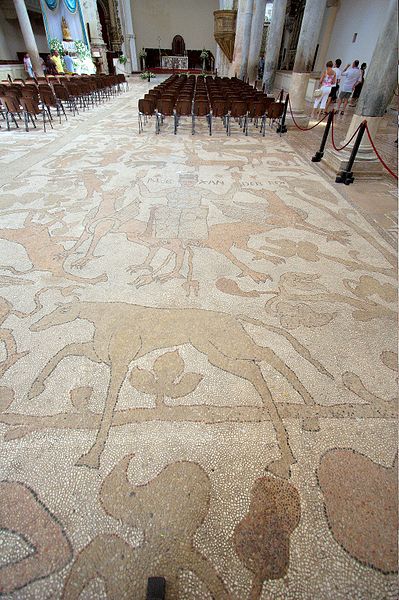
Photos Wikipedia
Más sobre Italy, Otranto Cathedral S Annunziata 1088
134: Germany, Alpirsbach Monastery 1095
This marker is part of an illustrated Survey of Romanesque Architecture, 300 to 1300 AD. To see and read all comments you have to download the post to your hard disk.
Germany, Alpirsbach Monastery church 1095

Photo by gereon, Panoramio
Más sobre Germany, Alpirsbach Monastery 1095
135: England, Ely Cathedral 630, 1093-1198
This marker is part of an illustrated Survey of Romanesque Architecture, 300 to 1300 AD. To see and read all comments you have to download the post to your hard disk.
England, Ely Cathedral 630, 1093-1198

The Cathedral in the Cambridgeshire fens. Photo mjausson.com
Más sobre England, Ely Cathedral 630, 1093-1198
136: Italy, Trani 1094-1240
This marker is part of an illustrated Survey of Romanesque Architecture, 300 to 1300 AD. To see and read all comments you have to download the post to your hard disk.
Trani Cathedral, Norman, 1094-1240

Photo by arquitotal, Panoramio
Más sobre Italy, Trani 1094-1240
137: England, Durham Cathedral 1093 and 1490
This marker is part of an illustrated Survey of Romanesque Architecture, 300 to 1300 AD. To see and read all comments you have to download the post to your hard disk.
England, Durham Cathedral 1093 and 1490
Durham, with the exception of the upper parts of its towers, the eastern extension known as the Chapel of Nine Altars, and the large west window of 1341, is entirely Norman.

Photo Wikipedia
Más sobre England, Durham Cathedral 1093 and 1490
138: Istanbul, Chora-Kariye Ekkllesia 11th cent
This marker is part of an illustrated Survey of Romanesque Architecture, 300 to 1300 AD. To see and read all comments you have to download the post to your hard disk.
Constantinople-Istanbul
Chora Ekkllesia - Kariye Camii Present building: 11th cent

Text and photo from Archnet.org
Restored after an earthquake in 557, the basilica was rebuilt in its current Greek-cross plan in the 11th century. Additions and renovations (1316-1321) were sponsored by Theodore Metochites, a scholar and prime minister under Andronicus II. One of the last churches built before the Fall of Constantinople (1453).
Its importance does not lie as much with its architecture but in the mosaics and frescoes which grace its interior and that of the attached parekklesion.
After it was declared a museum, the Byzantine Institute of Washington D.C. and the Dumbarton Oaks Center of Byzantine Studies restored it in 1948.
My photographs (before digital cameras) were taken free-hand.
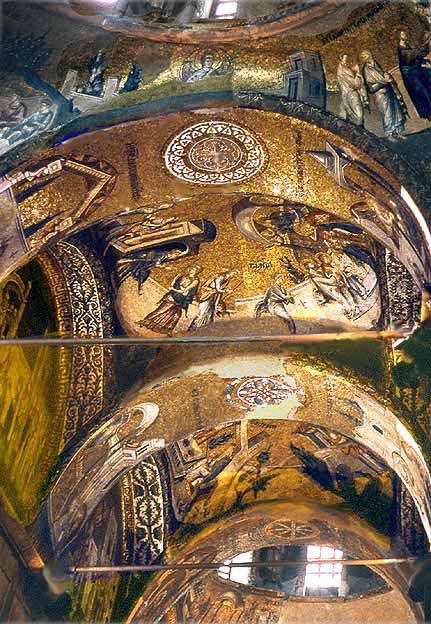
and some of its mosaics: The Emperor presenting the church
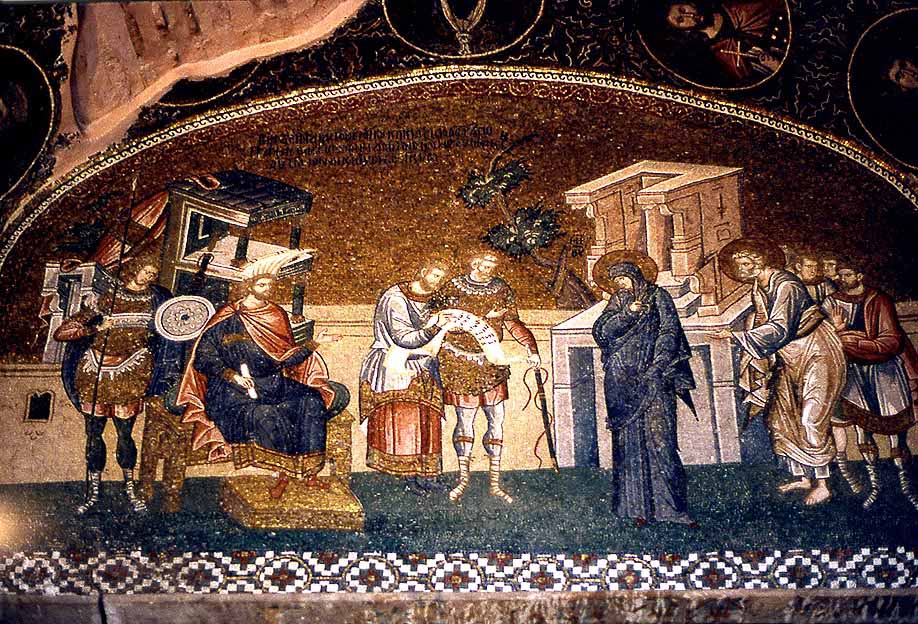
Christ's Baptism
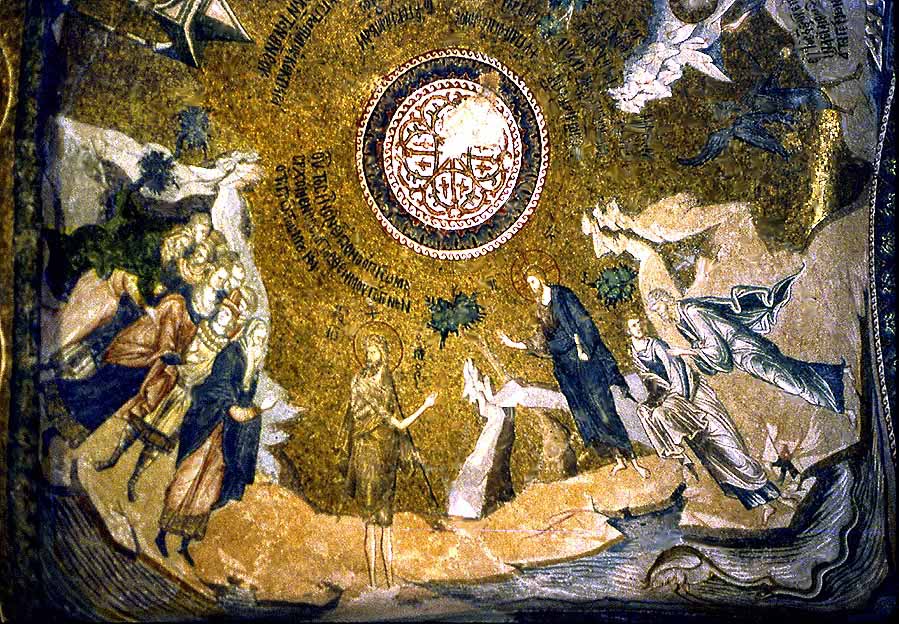
Christ Pantocrator in the dome

Interior photos RWFG
Más sobre Istanbul, Chora-Kariye Ekkllesia 11th cent
139: Tao-Klarjeti, Oshki 11th cent
This marker is part of an illustrated Survey of Romanesque Architecture, 300 to 1300 AD. To see and read all comments you have to download the post to your hard disk.
Tao-Klarjeti, Turkey
Cathedral of Oskhi, 11th cent.
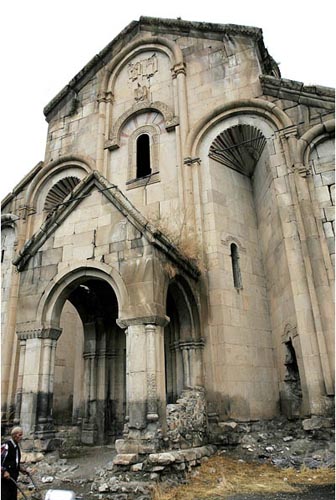
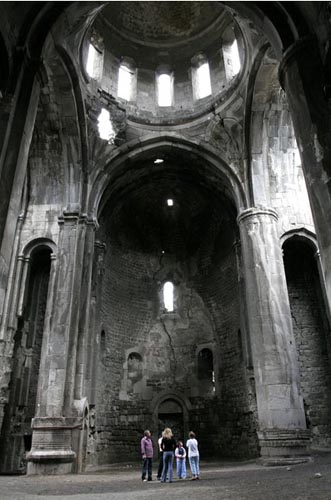
Más sobre Tao-Klarjeti, Oshki 11th cent
140: Spain, Aquilar de Campoo, Monastery of Santa María La Real 11th cent
This marker is part of an illustrated Survey of Romanesque Architecture, 300 to 1300 AD. To see and read all comments you have to download the post to your hard disk.
Aquilar de Campoo, Monastery of Santa María La Real 11th cent
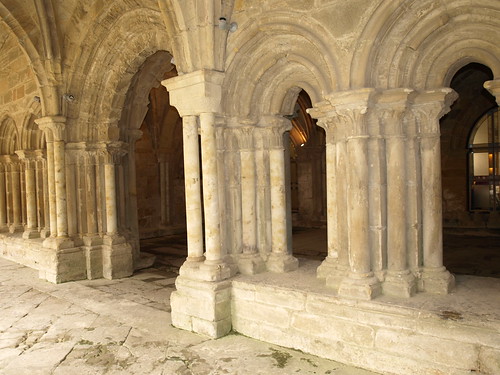
Sala Capitular de Monasterio de S. M. Real, Photo rabespierre photostream flikr
Más sobre Spain, Aquilar de Campoo, Monastery of Santa María La Real 11th cent
141: France, Chapaize, Eglise 11th cent
This marker is part of an illustrated Survey of Romanesque Architecture, 300 to 1300 AD. To see and read all comments you have to download the post to your hard disk.
Chapaize, Eglise 11th cent

Phoro Wikipedia
Más sobre France, Chapaize, Eglise 11th cent
142: Spain, Aguilar de Campoo, Collegiata San Miquel 11th cent
This marker is part of an illustrated Survey of Romanesque Architecture, 300 to 1300 AD. To see and read all comments you have to download the post to your hard disk.
Spain, Aguilar de Campoo, Collegiata San Miquel 11th cent
Photo by CarolineBelgium
Más sobre Spain, Aguilar de Campoo, Collegiata San Miquel 11th cent
143: Netherland, Maastricht, Cathedral san Servatius 11-13th cent
This marker is part of an illustrated Survey of Romanesque Architecture, 300 to 1300 AD. To see and read all comments you have to download the post to your hard disk.
Netherland, Maastricht, Cathedral san Servatius 11-13th cent

Photo by lyra_ballerina, Panoramio
Más sobre Netherland, Maastricht, Cathedral san Servatius 11-13th cent
144: Tao-Klarjeti, Ishkhani 11th cent.
This marker is part of an illustrated Survey of Romanesque Architecture, 300 to 1300 AD. To see and read all comments you have to download the post to your hard disk.
Tao-Klarjeti, Turkey
Cathedral of Iskhani 11th cent
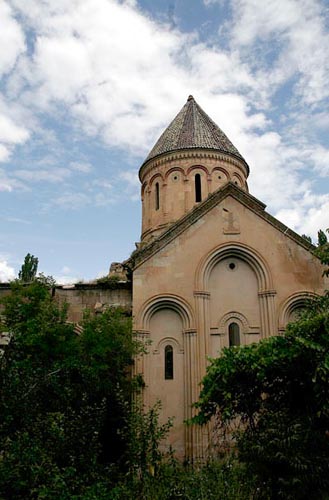
<
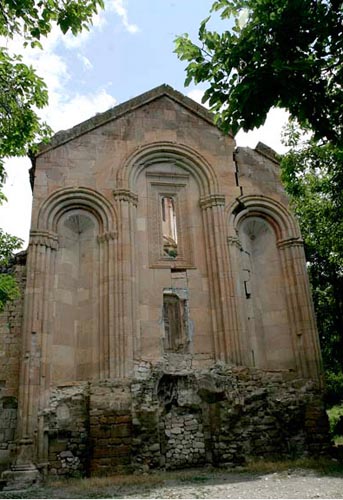
A large processional cross from Ishkhani (973), cast silver gilded, showing the sculptural sensibilies of the 10th century: sparse, almost rigid, nevertheless of great expressiveness. It was saved from the Ottoman conquest of Tao-Klarjeti in the 16th cent and is now In the Tbilisi National Museum. The inscription is in Georgian

Photo Rolf Gross, Georgian Gold Treasures
Más sobre Tao-Klarjeti, Ishkhani 11th cent.
145: France, Abbaye de Montmajour 10-13th cent
This marker is part of an illustrated Survey of Romanesque Architecture, 300 to 1300 AD. To see and read all comments you have to download the post to your hard disk.
France, Benedictine Abbaye de Montmajour 10-13th cent

Photo by johnrock, Panoramio
Más sobre France, Abbaye de Montmajour 10-13th cent
146: Spain, Olmos de Ojeade 11th cent
This marker is part of an illustrated Survey of Romanesque Architecture, 300 to 1300 AD. To see and read all comments you have to download the post to your hard disk.
Spain, Olmos de Ojeade 11th cent

Photo by diegourdiales, Panoramio
Más sobre Spain, Olmos de Ojeade 11th cent
147: Spain, San Juan de Ortega 300-1300
This marker is part of an illustrated Survey of Romanesque Architecture, 300 to 1300 AD. To see and read all comments you have to download the post to your hard disk.
Monasterio San Juan de Ortega, near Barrios de Colina

Photo Wikipedia
Más sobre Spain, San Juan de Ortega 300-1300
148: Spain, San Salvador de Cantamuda 11th cent
This marker is part of an illustrated Survey of Romanesque Architecture, 300 to 1300 AD. To see and read all comments you have to download the post to your hard disk.
Spain, San Salvador de Cantamuda 11th cent

Photo by Pepe Nogales, Panoramio
Más sobre Spain, San Salvador de Cantamuda 11th cent
149: Italy, Verona S. Lorenzo 1110
This marker is part of an illustrated Survey of Romanesque Architecture, 300 to 1300 AD. To see and read all comments you have to download the post to your hard disk.
Verona, Chiesa di S. Lorenzo 1110

Photo by virtualtourist.com
Más sobre Italy, Verona S. Lorenzo 1110
150: Portugal, Oporto, Cathedral, Se do Porto 5th cent - 1110
This marker is part of an illustrated Survey of Romanesque Architecture, 300 to 1300 AD. To see and read all comments you have to download the post to your hard disk.
Portugal, Oporto, Cathedral, Se do Porto 5th cent - 1110
Photo Wikipedia
The Romanesque nave is rather narrow and is covered by barrel vaulting. It is flanked by two aisles with a lower vault. The stone roof of the central aisle is supported by flying butresses, making the building one of the first in Portugal to use this architectonic feature.
The external appearance of the Cathedral was greatly altered during Baroque times. In 1772 a new main portal substituted the old Romanesque original and the tower cupolas were altered. Around 1732 Italian architect Nicolau Nasoni added an elegant Baroque loggia to the lateral façade of the Cathedral.
Más sobre Portugal, Oporto, Cathedral, Se do Porto 5th cent - 1110
151: France, Fontevraud-l'Abbaye 1110 - 1119.
This marker is part of an illustrated Survey of Romanesque Architecture, 300 to 1300 AD. To see and read all comments you have to download the post to your hard disk.
Fontevraud-l'Abbaye 1110 - 1119
The abbey was originally the site of the tombs of King Henry II of England, his wife Eleanor of Aquitaine, their son King Richard I of England, their daughter Joan, their grandson Raymond VII of Toulouse, and Isabella of Angoulême, wife of their son King John. However, there is no remaining corporal presence of Henry, Eleanor, Richard or the others on the site. Their remains as they were, were destroyed during the French Revolution.

Photo Wikipedia
Más sobre France, Fontevraud-l'Abbaye 1110 - 1119.
152: Germany, Regensburg, Schottenkirche St. Jakob 1110-1190
This marker is part of an illustrated Survey of Romanesque Architecture, 300 to 1300 AD. To see and read all comments you have to download the post to your hard disk.
Germany, Regensburg, Schottenkirche St. Jakob 1110-1190
The Benedictine abbey of St James (Jakobskirche) in Regensburg, Germany, was founded by Hiberno-Scottish missionaries and for most of its history was in the hands of first Irish, then Scottish monks. Hence it is known as the Scots Monastery, in German Schottenkirche, Schottenkloster or Schottenstift. (In Middle Latin, Scotti meant Gaels from Scotland or Ireland, so that the term Schottenstift already dates from the Irish period.) The full official name of the actual church, the most prominent building within the abbey complex, is Die irische Benediktinerklosterkirche St. Jakob und St. Gertrud (literally: "The Irish Benedictine Abbey Church of St. James and St. Gertrude").

The Romanesque portal of the "Schottenkirche" (under its modern protective overhang roof) is one of Regensburg's main treasures. Photo by Klaus Rommel, Panoramio
Más sobre Germany, Regensburg, Schottenkirche St. Jakob 1110-1190
153: France, Moissac, Abbaye St Pierre 1115 - 1130
This marker is part of an illustrated Survey of Romanesque Architecture, 300 to 1300 AD. To see and read all comments you have to download the post to your hard disk.
France, Moissac, Abbaye St Pierre 1115 - 1130

The beauty of Moissac is in it's sculptures, especially in the cloisters and the portals of the church. The interior of the church is a hideous modern job of decoration. Photo by Thysen Jean, Panoramio
Más sobre France, Moissac, Abbaye St Pierre 1115 - 1130
154: England, Gloucester Cathedral 1120
This marker is part of an illustrated Survey of Romanesque Architecture, 300 to 1300 AD. To see and read all comments you have to download the post to your hard disk.
England, Gloucester Cathedral, Norman 1120-60
originated with the foundation of an abbey dedicated to Saint Peter in 678 or 679 (dissolved by King Henry VIII of England). The present church was constructed by Abbot Serlo (1072-1104), The Norman nucleus), was later added to in every style of Gothic architecture.
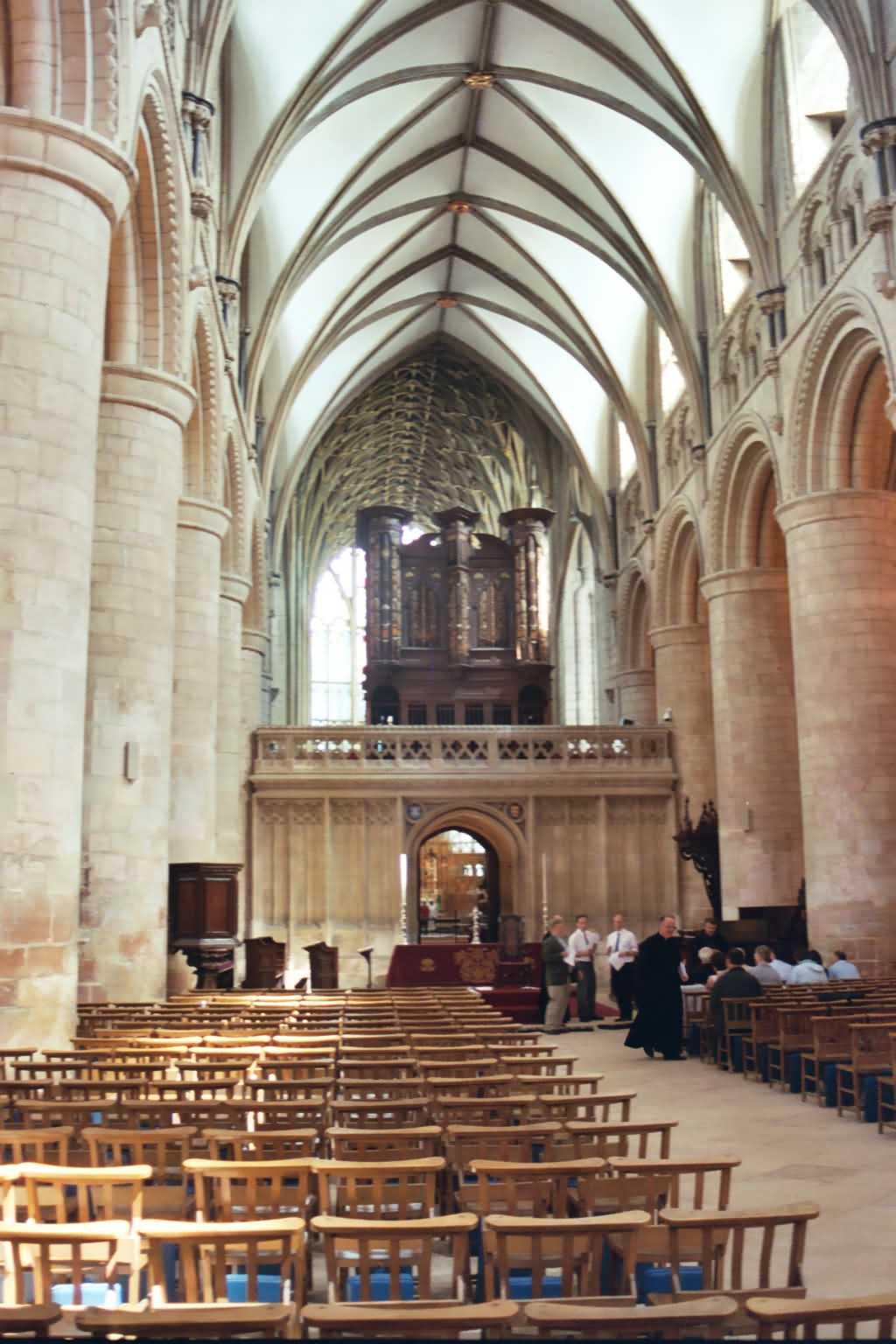
The interior shows the Norman nave wiith later structural additions. Photo Hintermeister.com
Más sobre England, Gloucester Cathedral 1120
155: Italy, S. Ambrogio di Valpolicella 1120
This marker is part of an illustrated Survey of Romanesque Architecture, 300 to 1300 AD. To see and read all comments you have to download the post to your hard disk.
S. Ambrogio di Valpolicella, Pieve di San Giorgio di Valpolicella 1120


The interior and the cloisters. Photo Thaïs.it
Más sobre Italy, S. Ambrogio di Valpolicella 1120
156: France, Montbard, Abbaye-de-Fontenay 1115
This marker is part of an illustrated Survey of Romanesque Architecture, 300 to 1300 AD. To see and read all comments you have to download the post to your hard disk.
Montbard, Abbaye-de-Fontenay 1115
Second foundation of St. Bernard (1115), one of the oldest Cistercensian monasteries in France. Privately restored 1906.
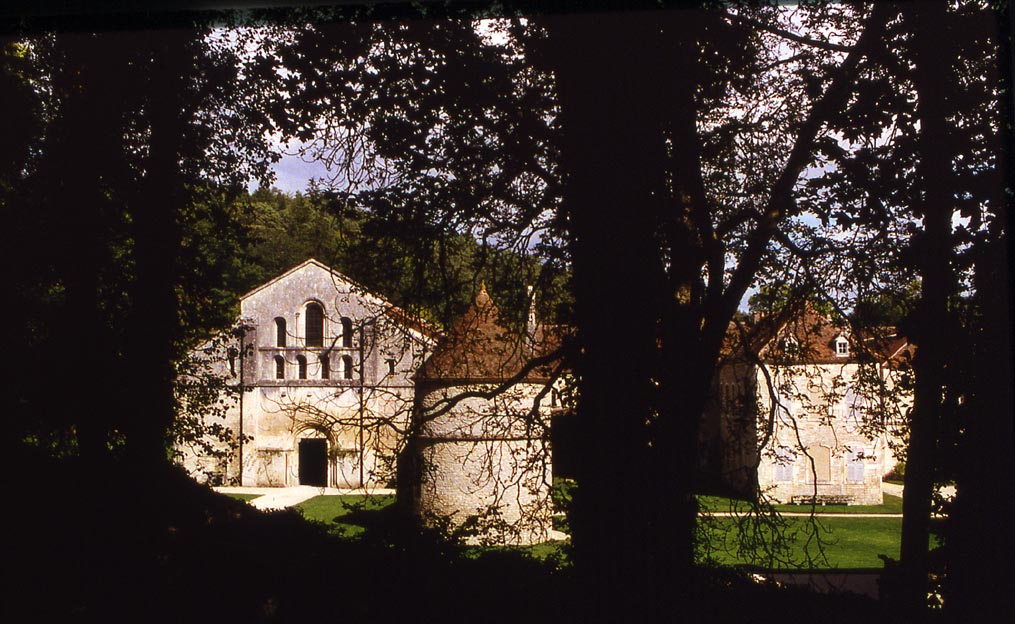
Photo RWFG
Más sobre France, Montbard, Abbaye-de-Fontenay 1115
157: Italy, Sant'Antimo 1117
This marker is part of an illustrated Survey of Romanesque Architecture, 300 to 1300 AD. To see and read all comments you have to download the post to your hard disk.
Abbazia Sant'Antimo 1117-1260
Legendary foundation of Charlemange (813 AD.) Basilica 1117-1260 unfinished. Strong influence of the French Gothic (Burgundy), unusual for Italy: Beautiful capitals
View of San Antimo

Photo Wikipedia
Modern windows by Lino Dinetto at Monte Antimo:
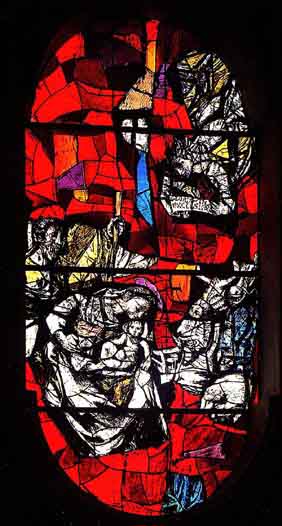
Más sobre Italy, Sant'Antimo 1117
158: England Peterborough Cathedral 1118-1250
This marker is part of an illustrated Survey of Romanesque Architecture, 300 to 1300 AD. To see and read all comments you have to download the post to your hard disk.
England Peterborough Cathedral 655, 1118-1250, 1508

Photo Wikipedia
Built between 1117 and 1508, Peterborough is remarkable as the least altered of the Norman cathedrals with only its famous Early English west front, with its later porch and the Perpendicular rebuilding of the eastern ambulatory being in different styles. The long wooden roof of the nave is original and has retained its painting from 1220.
Más sobre England Peterborough Cathedral 1118-1250
159: Istanbul, Pantocrator Church -Zeyrek Camii 1118-1143
This marker is part of an illustrated Survey of Romanesque Architecture, 300 to 1300 AD. To see and read all comments you have to download the post to your hard disk.
Constantinople-Istanbul
Pantocrator Church -Zeyrek Camii 1118-1143

The main trakt, used as mosque is in poor, the right parakklision in better condition. Photo Wikipedia
Más sobre Istanbul, Pantocrator Church -Zeyrek Camii 1118-1143
160: France, Montoire-sur-le Loir 1120
This marker is part of an illustrated Survey of Romanesque Architecture, 300 to 1300 AD. To see and read all comments you have to download the post to your hard disk.
Montoire-sur-le Loir, St Gilles 1120
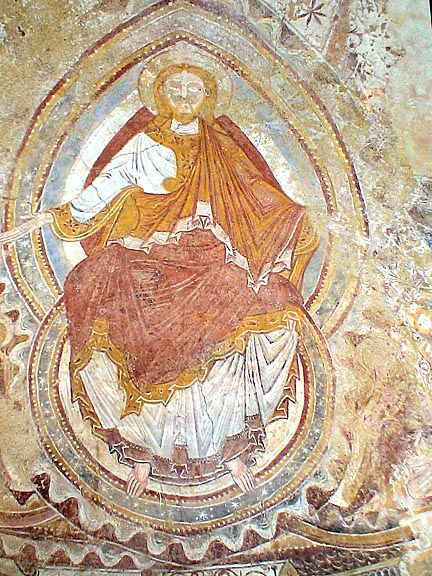
Interior, Romanesque frescoes: Christ in Majesty (12th cent)
Más sobre France, Montoire-sur-le Loir 1120
161: France, Saint-Paul-Trois-Châteaux, Cathedral, 1120-13th cent
This marker is part of an illustrated Survey of Romanesque Architecture, 300 to 1300 AD. To see and read all comments you have to download the post to your hard disk.
Saint-Paul-Trois-Châteaux, Cathedral, 1120-13th cent

Photo: by art-roman.net
Más sobre France, Saint-Paul-Trois-Châteaux, Cathedral, 1120-13th cent
162: Italy, Castell'Arquato, Collegiate Church 1120
This marker is part of an illustrated Survey of Romanesque Architecture, 300 to 1300 AD. To see and read all comments you have to download the post to your hard disk.
Italy, Castell'Arquato, Collegiate Church 1120
Photo Picasa-Web
Más sobre Italy, Castell'Arquato, Collegiate Church 1120
163: France Autun St. Lazare 1120-1130
This marker is part of an illustrated Survey of Romanesque Architecture, 300 to 1300 AD. To see and read all comments you have to download the post to your hard disk.
France Autun St. Lazare 1120-1130
Work on the new cathedral of Saint Lazarus or St. Lazare began in around 1120 and advanced rapidly enough for the building to be consecrated in 1130. It was mostly finished by 1146, when the relics of Lazarus were translated from the old cathedral. The Tomb of Lazarus, the shrine of the relics, was constructed in the choir in 1170-1180[1]. The narthex or portico was not completed until the very end of the century.
The inspiration of the new building, both in layout and decoration, was Cluniac. The designs were the work of the bishop Etienne de Bagé, who was particularly influenced by the Cluniac abbey of Paray-le-Monial.
For a number of years after 1146 the two cathedrals operated in tandem, with Saint Lazare as the summer cathedral (from Easter to All Saints' Day) and Saint Nazaire as the winter cathedral. Saint Lazare was eventually confirmed as the one cathedral of Autun in 1195.

Photo skyscrapercity.com
See the sculpture of Autun
Más sobre France Autun St. Lazare 1120-1130
164: France, Lavardin 1125
This marker is part of an illustrated Survey of Romanesque Architecture, 300 to 1300 AD. To see and read all comments you have to download the post to your hard disk.
Lavardin, St-Genest, 1125

Romansque frescoes in the small church of St. Genest. Photo artandarchitecture.org.uk

Photo from Wikipedia
Más sobre France, Lavardin 1125
165: Sweden, Lund Domkyrkan 1125-1145
This marker is part of an illustrated Survey of Romanesque Architecture, 300 to 1300 AD. To see and read all comments you have to download the post to your hard disk.
Lund Domkyrkan 1125-1145, Built by King Canut as a copy of Speyer.

Photo by mogens13, Panoramio
Más sobre Sweden, Lund Domkyrkan 1125-1145
166: Germany, Freckenhorst 1130
This marker is part of an illustrated Survey of Romanesque Architecture, 300 to 1300 AD. To see and read all comments you have to download the post to your hard disk.
Freckenhorst Abbey church 1130
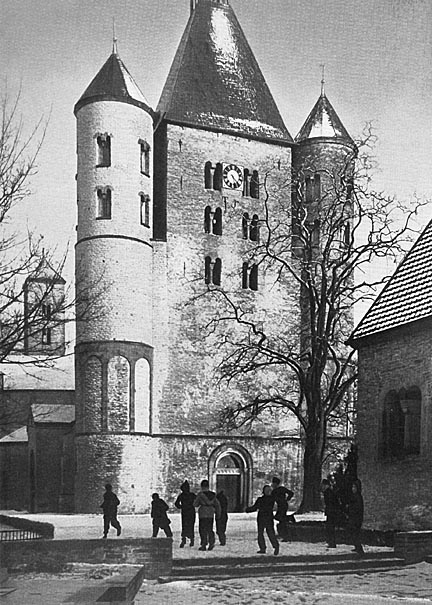
The church at Freckenhorst. Photo RWFG
Más sobre Germany, Freckenhorst 1130
167: Italy, Palermo, Cappella Palatina 1130-1143
This marker is part of an illustrated Survey of Romanesque Architecture, 300 to 1300 AD. To see and read all comments you have to download the post to your hard disk.
Palermo, Sicily, Capella Palatina, 1130-1143
Built by Arabic and Byzantine craftsmen in the employ of Norman King Roger II, the Cappella Palatina was his private chapel. This golden cave is a wonder of the harmonious synergy of Byzantine mosaic art, Arabic intarsia, and Norman architecture.
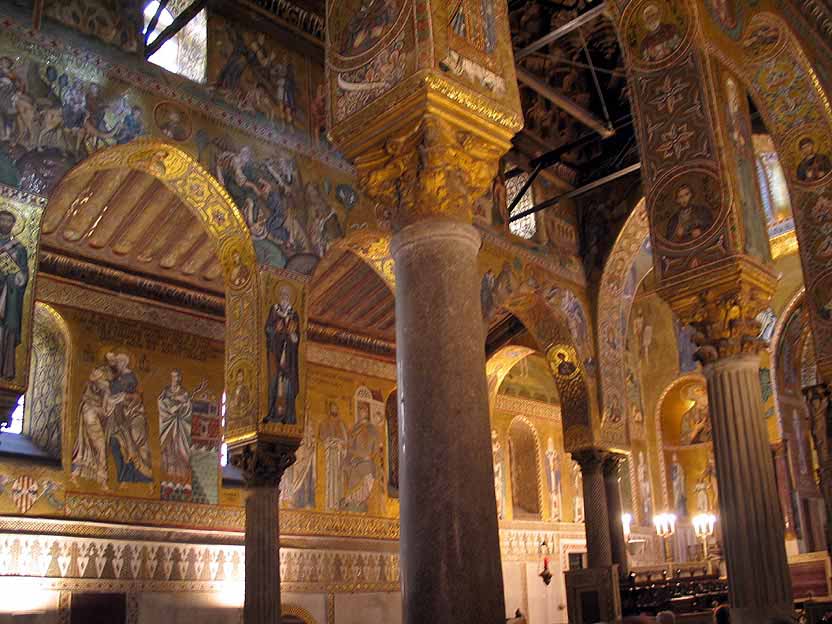
Photo Rolf Gross's collection of the Capella Palatina
Más sobre Italy, Palermo, Cappella Palatina 1130-1143
168: Germany, Idensen Siegward Kirche 1130
This marker is part of an illustrated Survey of Romanesque Architecture, 300 to 1300 AD. To see and read all comments you have to download the post to your hard disk.
Idensen Sigward Kirche 1130

Más sobre Germany, Idensen Siegward Kirche 1130
169: Italy, Cefalu 1131
This marker is part of an illustrated Survey of Romanesque Architecture, 300 to 1300 AD. To see and read all comments you have to download the post to your hard disk.
Cefalu San Pietro Cathedral, Norman 1131
Cefalú's singular attraction is the Duomo, erected 49 years before Monreale, in the Arabic-Norman style by King Roger II.
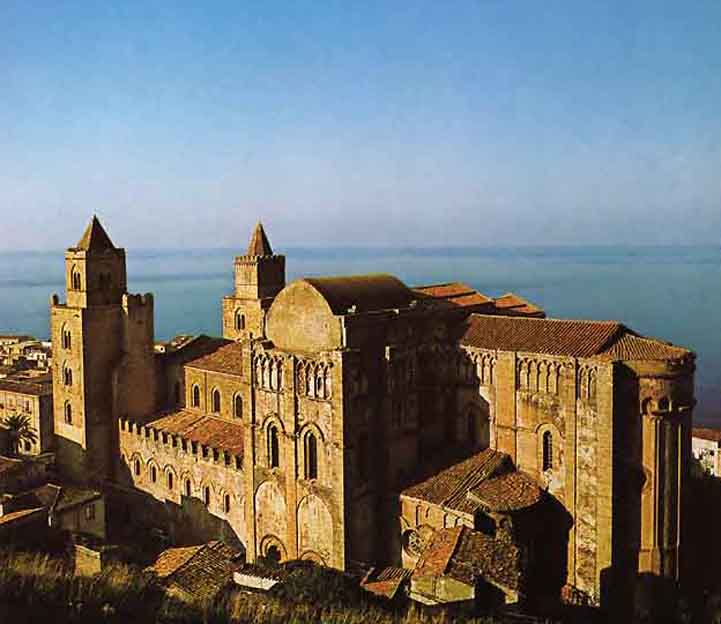
The Duomo from the hill.
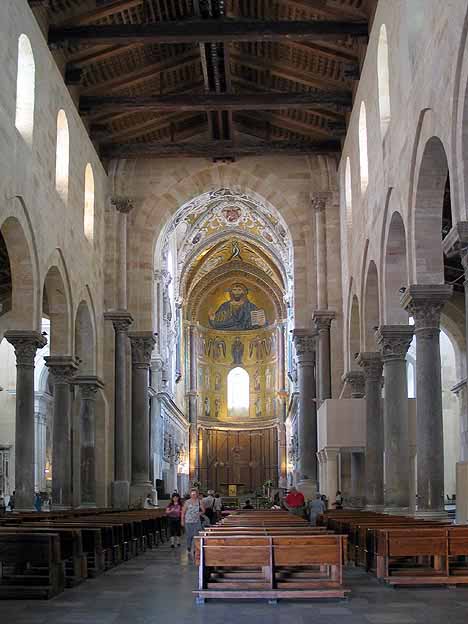
The nave
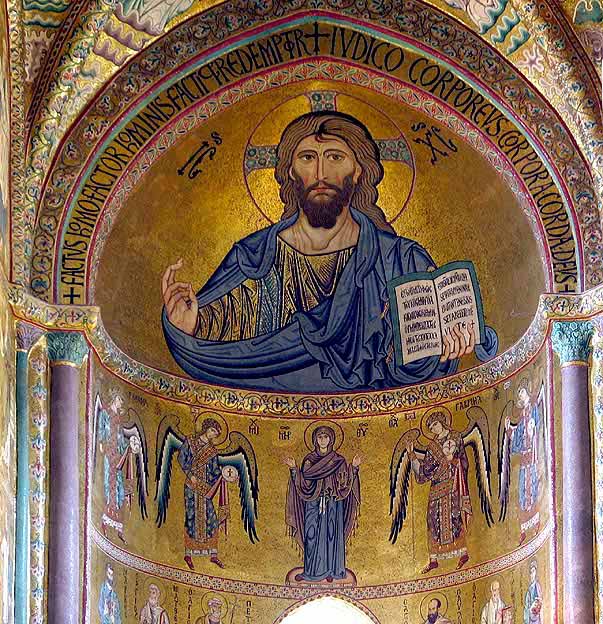
Byzantine Mosaic of Christ surrounded by archangels. (1140) Photos RWFG
Más sobre Italy, Cefalu 1131
170: England, Fountains Abbey, 1132
This marker is part of an illustrated Survey of Romanesque Architecture, 300 to 1300 AD. To see and read all comments you have to download the post to your hard disk.
England, Fountains Abbey, the romantic ruins of a Cistercian monastery 1132

Photo by Ken & Janie Rowell, Panoramio
Más sobre England, Fountains Abbey, 1132
171: Germany, Reichenau Niederzell 1134
This marker is part of an illustrated Survey of Romanesque Architecture, 300 to 1300 AD. To see and read all comments you have to download the post to your hard disk.
Reichenau Niederzell St. Peter and Paul 1134

The third church, St Peter and Paul in Niederrzell 1134. Baroque 1750-60 Photo by ©Agoe, Panoramio
Niederzell has a restrained late Baroque interior backed by an apse with a 12th cent freco! A beguilingly harmonious miracle. Photo ochmann
Más sobre Germany, Reichenau Niederzell 1134
172: St Remy-Provence, Saint-Paul-de-Mausolle 1134
This marker is part of an illustrated Survey of Romanesque Architecture, 300 to 1300 AD. To see and read all comments you have to download the post to your hard disk.
France, St Remy-Provence, Saint-Paul-de-Mausolle 1134
The place where Van Gogh spend his last years, was a monastery, a very sober late Romanesque Church, noteworthy capitels, a romanesque cloisters

Photo: art-roman.net
Más sobre St Remy-Provence, Saint-Paul-de-Mausolle 1134
173: Scotland, Kirkwall, St. Magnus 1137
This marker is part of an illustrated Survey of Romanesque Architecture, 300 to 1300 AD. To see and read all comments you have to download the post to your hard disk.
Scotland, Kirkwall, St. Magnus Cathedral, Norman 1137

photo by jlgmontesinos, Panoramio
Más sobre Scotland, Kirkwall, St. Magnus 1137
174: Jerichow, Monastery 1148
This marker is part of an illustrated Survey of Romanesque Architecture, 300 to 1300 AD. To see and read all comments you have to download the post to your hard disk.
Jerichow, Premonstratensian convent , 1148
It is included as an example of the late Romanesque, northeastern German brick architecture.
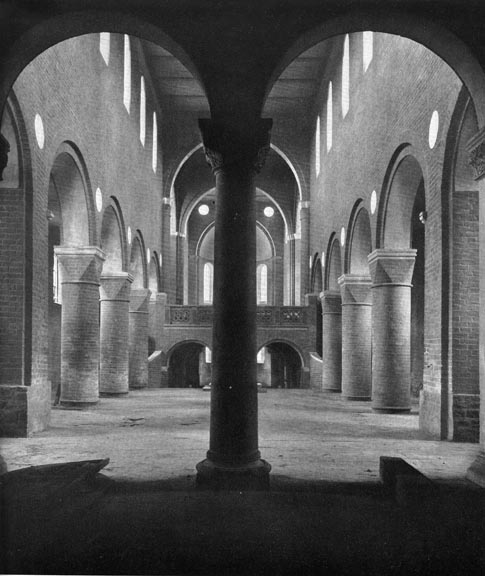
Más sobre Jerichow, Monastery 1148
175: Florence San Miniato al Monte 1140
This marker is part of an illustrated Survey of Romanesque Architecture, 300 to 1300 AD. To see and read all comments you have to download the post to your hard disk.
Florence San Miniato al Monte 1140
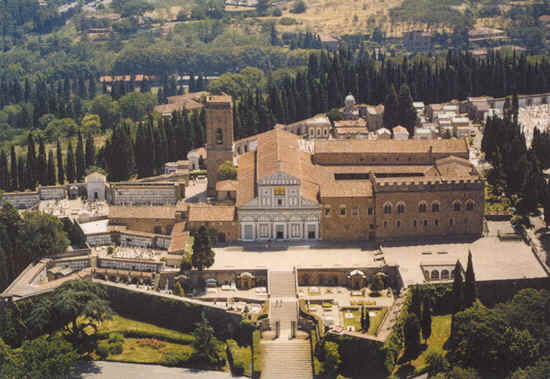
Aerial view of San Miniato. Photo san-miniato-al-monte.com
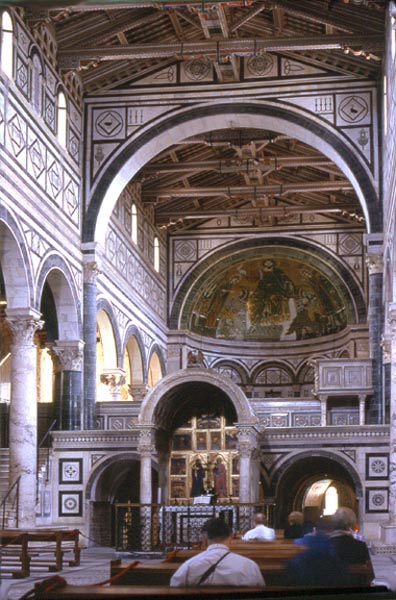
Interior of San Miniato. Photo RWFG
Más sobre Florence San Miniato al Monte 1140
176: Portugal, Coimbra, Old Cathedral Se Velha 1140
This marker is part of an illustrated Survey of Romanesque Architecture, 300 to 1300 AD. To see and read all comments you have to download the post to your hard disk.
Portugal, Coimbra, Old Cathedral Se Velha 1140

Photo Wikipedia
The main motifs are vegetal and geometric and reveal Arab and pre-romanesque influences, but there are also pairs of quadrupeds (including centaurs) or birds facing each other.
There are virtually no human representations, and no Biblical scenes. The absence of sculptured human figures may be due to the fact that many of the artists that worked in the Cathedral were mozarabic, i.e. Christians who lived in Arab territories and that had settled in Coimbra in the 12th century. These artists were perhaps not used to human representations, which are forbidden in Islam.
Más sobre Portugal, Coimbra, Old Cathedral Se Velha 1140
177: Italy, Montichiari Pieve di San Pancratio 1140-1185
This marker is part of an illustrated Survey of Romanesque Architecture, 300 to 1300 AD. To see and read all comments you have to download the post to your hard disk.
Montichiari, Pieve di San Pancratio 1140-1185

Photo Thaïs.it
Más sobre Italy, Montichiari Pieve di San Pancratio 1140-1185
178: France, St-Jacques-des-Guerets 1140
This marker is part of an illustrated Survey of Romanesque Architecture, 300 to 1300 AD. To see and read all comments you have to download the post to your hard disk.
St-Jacques-des-Guerets frescoes 12th cent

Romanesque frescoes in the church on the French part of the pilgrim's path to Santiago. Photo art-roman.net

Christ in Majesty. Photo Wikipedia.
For more photos see art-roman.net
Más sobre France, St-Jacques-des-Guerets 1140
179: France, Murbach Abbey Church 783, 1150
This marker is part of an illustrated Survey of Romanesque Architecture, 300 to 1300 AD. To see and read all comments you have to download the post to your hard disk.
Murbach Abbey Church 783, 1150

Of the Romanesque abbey church, dedicated to Saint Leger, only the transept remains with its two towers. The church was destroyed during the French Revolution (1789)
Photo Wikipedia
Más sobre France, Murbach Abbey Church 783, 1150
180: Belgium, Tournai, Cathedral Notre Dame 1140 - 1160
This marker is part of an illustrated Survey of Romanesque Architecture, 300 to 1300 AD. To see and read all comments you have to download the post to your hard disk.
Belgium, Tournai, Cathedral Notre Dame 1140 - 1160

Photo by JMZ2007, Panoramio
Más sobre Belgium, Tournai, Cathedral Notre Dame 1140 - 1160
181: France, La Roque d'Antheron, Abbeye Silvacane 1144-1343
This marker is part of an illustrated Survey of Romanesque Architecture, 300 to 1300 AD. To see and read all comments you have to download the post to your hard disk.
France, La Roque d'Antheron, Abbeye Silvacane 1144-1343
Cistercensian Establishment 1143, abendoned 1443
Photo Wikipedia
Más sobre France, La Roque d'Antheron, Abbeye Silvacane 1144-1343
182: Italy, Belfiore Madonna della Stra' 1143
This marker is part of an illustrated Survey of Romanesque Architecture, 300 to 1300 AD. To see and read all comments you have to download the post to your hard disk.
Belfiore Chiesa San Michele Madonna della Stra' 1143

Photo Thaïs
Más sobre Italy, Belfiore Madonna della Stra' 1143
183: France, St. Nectaire 1146
This marker is part of an illustrated Survey of Romanesque Architecture, 300 to 1300 AD. To see and read all comments you have to download the post to your hard disk.
France, St. Nectaire 1146
Little altered, St. Nectaire is one of the purest Romananesque churches in the Auvergne.
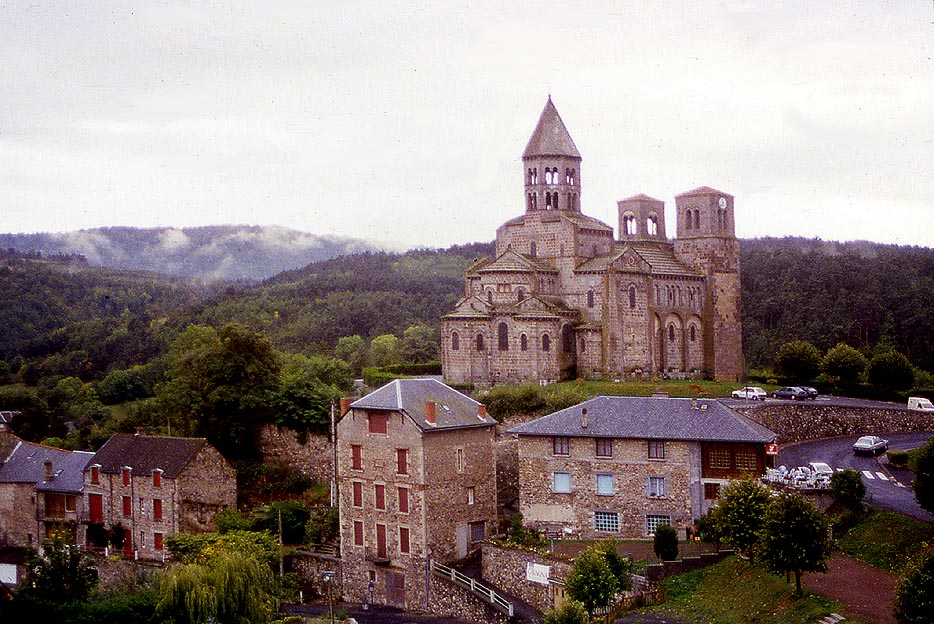
Photo RWFG
Más sobre France, St. Nectaire 1146
184: Portugal, Lisbon Cathedral Se Santa Maria 1147
This marker is part of an illustrated Survey of Romanesque Architecture, 300 to 1300 AD. To see and read all comments you have to download the post to your hard disk.
Portugal, Lisbon Cathedral Se Santa Maria 1147
Photo Wikipedia
Más sobre Portugal, Lisbon Cathedral Se Santa Maria 1147
185: France, Paray-le-Monial Sacre Ceur 1150
This marker is part of an illustrated Survey of Romanesque Architecture, 300 to 1300 AD. To see and read all comments you have to download the post to your hard disk.
Paray-le-Monial, Basilica de Sacre Ceur, 1150

Photo Thaïs-architettura
Más sobre France, Paray-le-Monial Sacre Ceur 1150
186: Italy, Fiesole Badia 1150
This marker is part of an illustrated Survey of Romanesque Architecture, 300 to 1300 AD. To see and read all comments you have to download the post to your hard disk.
Fiesole Badia Fiesolana 11-12th cent

Photo Thaïs-architettura
Más sobre Italy, Fiesole Badia 1150
187: Germany, Cologne Basilika Gross=St.-Martin 1152
This marker is part of an illustrated Survey of Romanesque Architecture, 300 to 1300 AD. To see and read all comments you have to download the post to your hard disk.
Cologne , Basilika Gross St. Martin 1152

The high Romanesque interior.
Photo by b-f-g, Panoramio
Más sobre Germany, Cologne Basilika Gross=St.-Martin 1152
188: Russia, Vladimir, Uspenski Cathedral 1158–1160
This marker is part of an illustrated Survey of Romanesque Architecture, 300 to 1300 AD. To see and read all comments you have to download the post to your hard disk.
Russia Vladimir, Uspenski Cathedral 1158–1160
The magnificent five-domed Assumption Cathedral was designed as a sepulcher of grand princes and dedicated to the holy icon Theotokos of Vladimir, which had been brought to the city by Andrew the Pious. The cathedral was constructed in 1158–1160, expanded in 1185–1189, and painted by the great Andrei Rublev and Daniil Chyorny in 1408.

Photo by Michal.Hugo.Kostal, Panoramio
Más sobre Russia, Vladimir, Uspenski Cathedral 1158–1160
189: Germany, Freising, Dom 1159
This marker is part of an illustrated Survey of Romanesque Architecture, 300 to 1300 AD. To see and read all comments you have to download the post to your hard disk.
Germany, Freising, Dom 1159
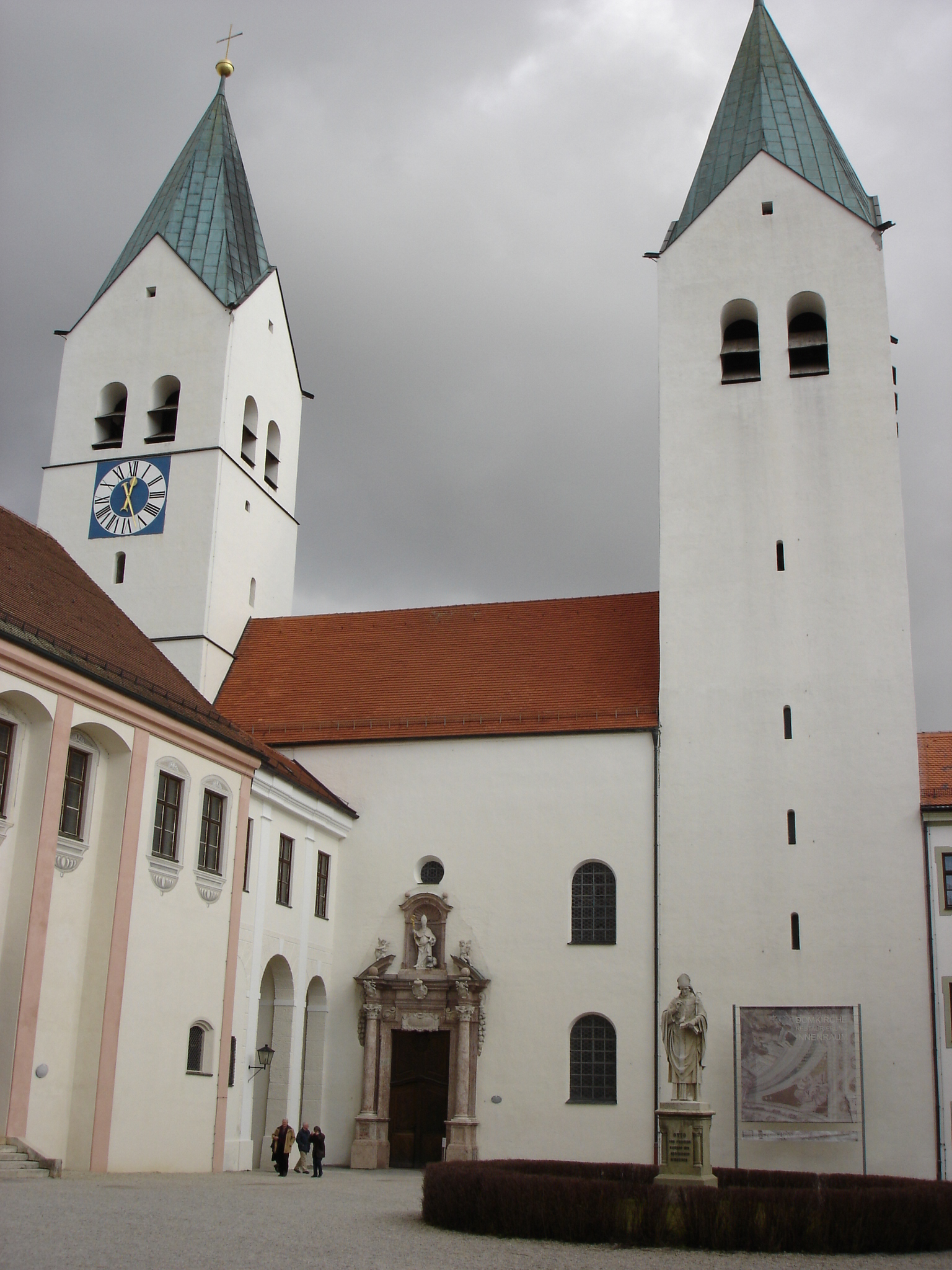
Photo Wikipedia
Más sobre Germany, Freising, Dom 1159
190: France, Issoire St. Autremoine 1160
This marker is part of an illustrated Survey of Romanesque Architecture, 300 to 1300 AD. To see and read all comments you have to download the post to your hard disk.
Issoire, St. Autremoine 1160

The largest of the Auvergnat churches. Photo by dadoux63, Panoramio.
Más sobre France, Issoire St. Autremoine 1160
191: France, Poitiers, St. Pierre 1162
This marker is part of an illustrated Survey of Romanesque Architecture, 300 to 1300 AD. To see and read all comments you have to download the post to your hard disk.
France, Poitiers, Cathedral St. Pierre 1162

Photo Wikipedia
Más sobre France, Poitiers, St. Pierre 1162
192: France, Orcival, Notre Dame 1166
This marker is part of an illustrated Survey of Romanesque Architecture, 300 to 1300 AD. To see and read all comments you have to download the post to your hard disk.
Orcival, Notre Dame 1166
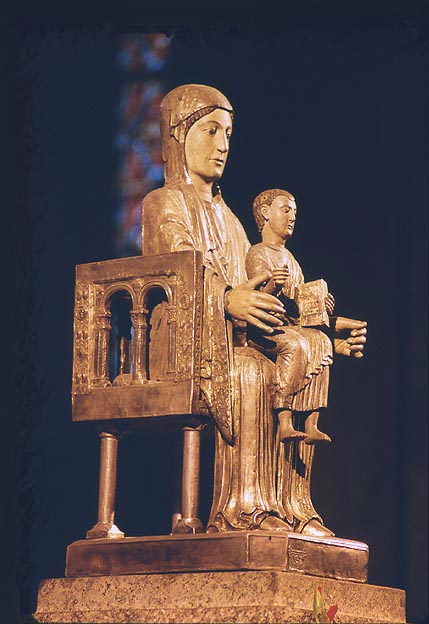
The celebrated Romanesque Madonna, Photo RWFG
Más sobre France, Orcival, Notre Dame 1166
193: France, Brignoles, Abbaye le Thoronet 1170
This marker is part of an illustrated Survey of Romanesque Architecture, 300 to 1300 AD. To see and read all comments you have to download the post to your hard disk.
France, Brignoles, Abbaye le Thoronet, Cistercian Foundation 1170-1200

Photo by JoDeLyon, Panoramio
Más sobre France, Brignoles, Abbaye le Thoronet 1170
194: France, Vezelay 1175
This marker is part of an illustrated Survey of Romanesque Architecture, 300 to 1300 AD. To see and read all comments you have to download the post to your hard disk.
France, Vezelay Basilica1175 - 1200
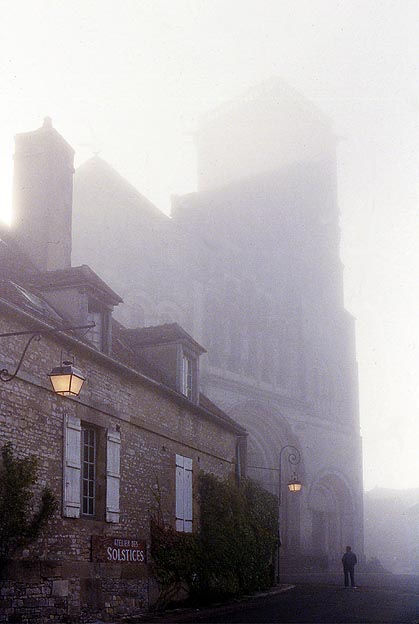
The church looming in the early morning fog. Photo RWFG
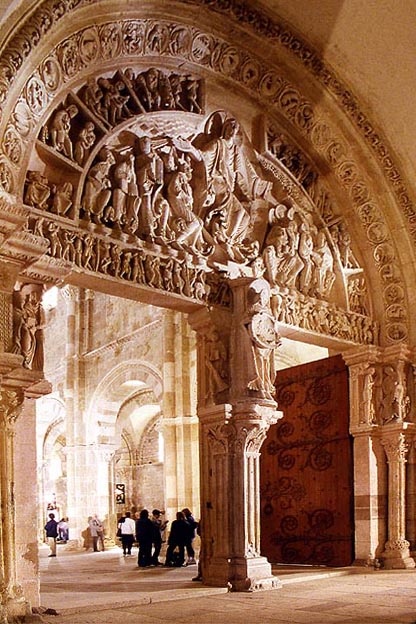
The door through which the pilgrims entered on their way to Compostela. Photo RWFG

The Nave. - No photo will ever describe the effect this space has on the visitor. Photo thais.it
Más sobre France, Vezelay 1175
195: Germany, Cologne, St. Aposteln 1175-1200
This marker is part of an illustrated Survey of Romanesque Architecture, 300 to 1300 AD. To see and read all comments you have to download the post to your hard disk.

Photo by Jan Hilgers, Panoramio
Más sobre Germany, Cologne, St. Aposteln 1175-1200
196: Italy, Vercelli, Chiesa San Bernardo 1175 - 1250
This marker is part of an illustrated Survey of Romanesque Architecture, 300 to 1300 AD. To see and read all comments you have to download the post to your hard disk.
Italy, Vercelli, Chiesa San Bernardo 1175 - 1250

Photo Thaïs.it
Más sobre Italy, Vercelli, Chiesa San Bernardo 1175 - 1250
197: Spain, Benavente, Santa Maria del Azogue, 1180
This marker is part of an illustrated Survey of Romanesque Architecture, 300 to 1300 AD. To see and read all comments you have to download the post to your hard disk.
Spain, Benavente, Santa Maria del Azogue, 1180
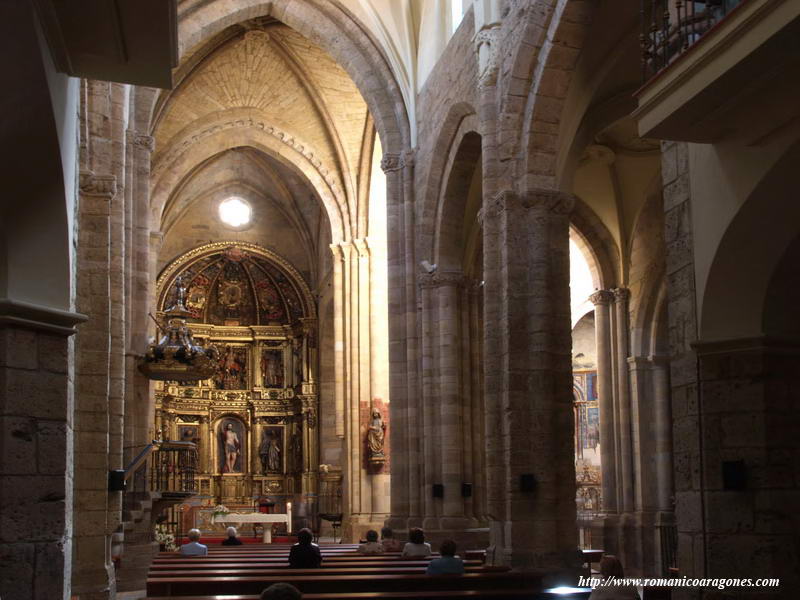
Interior, Photo arquivoltas.com
Más sobre Spain, Benavente, Santa Maria del Azogue, 1180
198: France, Abbaye de la Cerisy-la-Forêt
This marker is part of an illustrated Survey of Romanesque Architecture, 300 to 1300 AD. To see and read all comments you have to download the post to your hard disk.
Abbaye de la Cerisy-la-Forêt, Manche

Photo by mich2e Panoramio
Más sobre France, Abbaye de la Cerisy-la-Forêt
199: Italy, Palermo Monreale 1180
This marker is part of an illustrated Survey of Romanesque Architecture, 300 to 1300 AD. To see and read all comments you have to download the post to your hard disk.
Italy, Palermo Monreale
Monreale, Norman Cathedral, 1180 AD
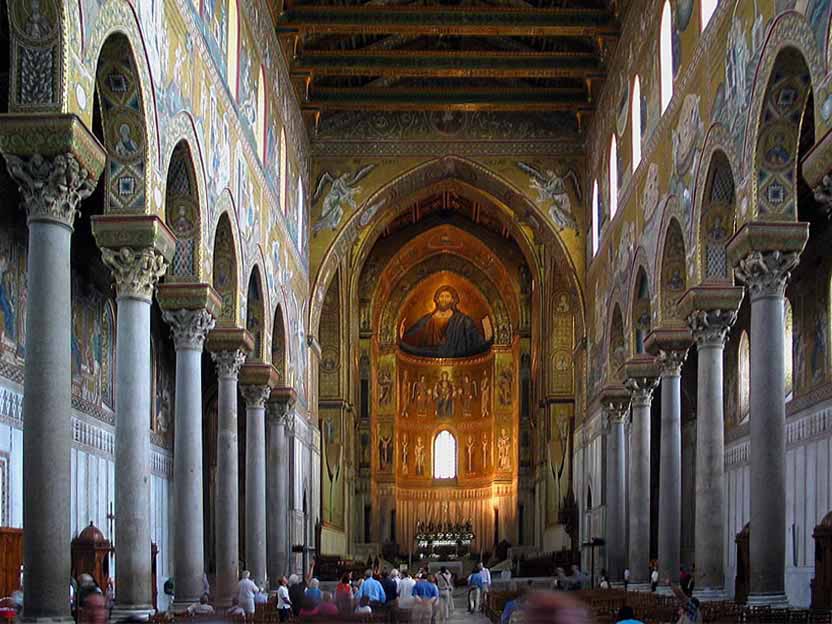

Photos RWFG
Más sobre Italy, Palermo Monreale 1180
200: Italy, Sovicille, Pieve di San Giovanni Battista, Ponte allo Spino 1189,
This marker is part of an illustrated Survey of Romanesque Architecture, 300 to 1300 AD. To see and read all comments you have to download the post to your hard disk.
Italy, Sovicille, Pieve di San Giovanni Battista (Parish Church Ponte allo Spino) 1189
is one of the most interesting Romanesque buildings in the Sienese Tuscany. The church has three naves separated by pillars and ending in apses.
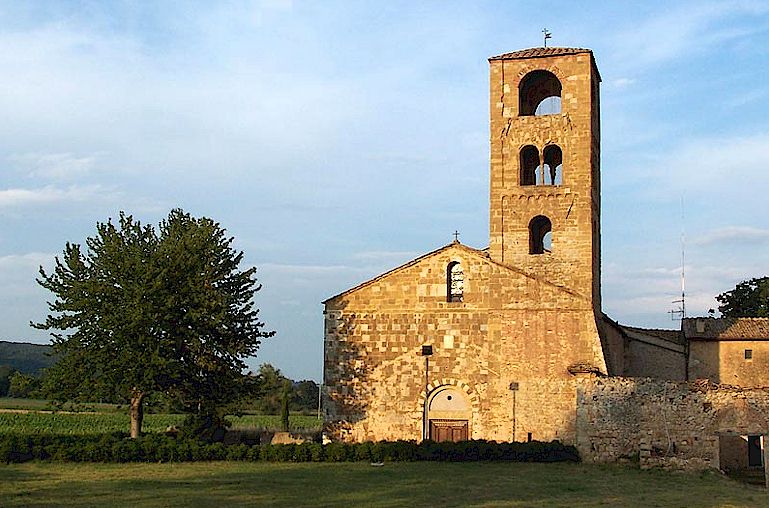
Photo abbeys-of-tuscany.com
Más sobre Italy, Sovicille, Pieve di San Giovanni Battista, Ponte allo Spino 1189,
201: Russia, Vladimir, Dimitri Sobor, 1194–1197
This marker is part of an illustrated Survey of Romanesque Architecture, 300 to 1300 AD. To see and read all comments you have to download the post to your hard disk.
Russia, Vladimir, Dimitri Sobor, 1194–1197
The warrior-like cathedral of St. Demetrius was built in 1194–1197 as a private chapel of Vsevolod the Big Nest in the courtyard of his palace and was consecrated to his holy patron, St. Demetrius. For all its formal unity, the cathedral represents a truly international project of Russian and Byzantine masters, Friedrich Barbarossa's masons, and carvers sent by Queen Tamar of Georgia.

Photo by Roman Strukov, Panoramio
Más sobre Russia, Vladimir, Dimitri Sobor, 1194–1197
202: Georgia, Samtavissi Cathedral 12th cent
This marker is part of an illustrated Survey of Romanesque Architecture, 300 to 1300 AD. To see and read all comments you have to download the post to your hard disk.
Samtavisi is one of the purest examples of classical Georgian architecture (12th cent). Besides its ornaments are exceptionally well preserved
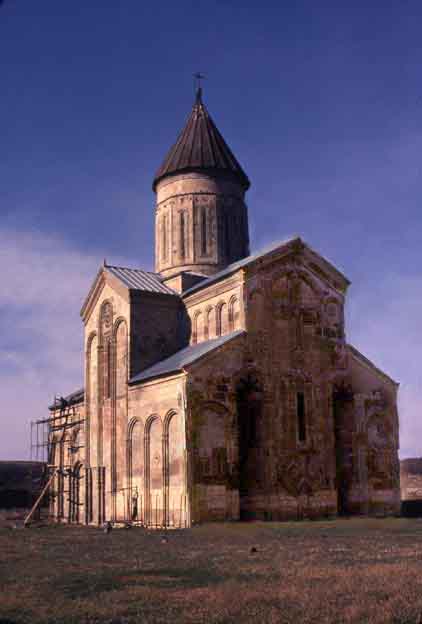
Phtoto RWFG
Más sobre Georgia, Samtavissi Cathedral 12th cent
203: France, Gourdon 12th cent
This marker is part of an illustrated Survey of Romanesque Architecture, 300 to 1300 AD. To see and read all comments you have to download the post to your hard disk.
France, Gourdon 12th cent

Interior, frescoes in the the apse (late 12th cent)

Nativity. Photos art-roman.net
Más sobre France, Gourdon 12th cent
204: France, Arles, St. Trophime 12th -15th cent
This marker is part of an illustrated Survey of Romanesque Architecture, 300 to 1300 AD. To see and read all comments you have to download the post to your hard disk.
Church of St. Trophime 12th -15th cent

Photo Wikipedia
Más sobre France, Arles, St. Trophime 12th -15th cent
205: Germany Kloster Maubronn 1147- 14th cent.
This marker is part of an illustrated Survey of Romanesque Architecture, 300 to 1300 AD. To see and read all comments you have to download the post to your hard disk.
Germany, Kloster Maubronn, Cistercian establishment 1147- 14th cent
Transitional Romanesque to Gothic. One of the most beautiful and best preserved Cistercian monasteries in Germany.

The Romanesque part of the monastic buildings seen from the yard.
Photo by coplaep, Panoramio

The fountain in the Gothic cloisters.
Photo flickr photo
Más sobre Germany Kloster Maubronn 1147- 14th cent.
206: Spain, Monastero de San Andrés del Arroyo 1181
This marker is part of an illustrated Survey of Romanesque Architecture, 300 to 1300 AD. To see and read all comments you have to download the post to your hard disk.
Monastero de San Andrés del Arroyo 1181

Photo by fjmanzanal, Panoramio

The cloister of the monastery, Photo by hlqq, Panoramio
Más sobre Spain, Monastero de San Andrés del Arroyo 1181
207: Burgos Cathedral 1221-1567
This marker is part of an illustrated Survey of Romanesque Architecture, 300 to 1300 AD. To see and read all comments you have to download the post to your hard disk.
Burgos Cathedral 1221-1567
The cathedral was begun by King Ferdinand III of Castile on the site of the former Romanesque cathedral in 1221, beginning at the chevet, which was completed in nine years. First consecrated in 1260, then there was a lengthy hiatus of almost 200 years before the cathedral was completed in 1567, with the completion of the lantern spire over the main crossing.

The church above the roofs of the town. Photo Wikipedia
Más sobre Burgos Cathedral 1221-1567
208: Münster Dom St Paul 1225
This marker is part of an illustrated Survey of Romanesque Architecture, 300 to 1300 AD. To see and read all comments you have to download the post to your hard disk.
Münster Dom St. Paul, the original building of 1225 was completely destroyed by Allied bombing. It was reconstructed after WW II.

Photo by BRThomas, flickr
Más sobre Münster Dom St Paul 1225
209: Faurndau, Stiftskirche 1230
This marker is part of an illustrated Survey of Romanesque Architecture, 300 to 1300 AD. To see and read all comments you have to download the post to your hard disk.
Faurndau, Stiftskirche 1230
An example of the old-fatherly instistance on past forms in Southern Germany - This beautiful space is from the late Romanesque period!
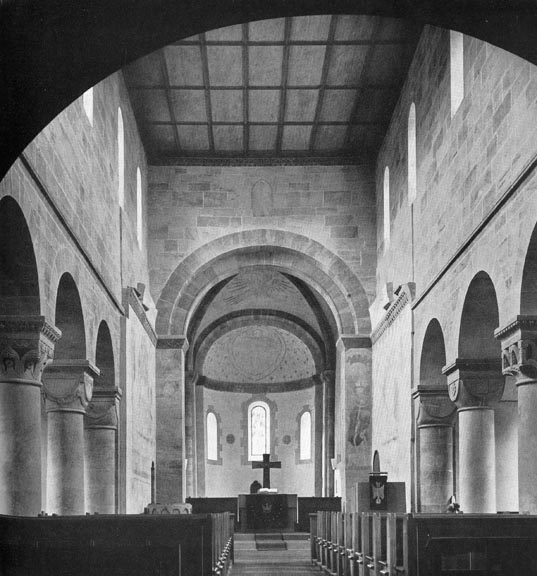
Más sobre Faurndau, Stiftskirche 1230
210: Turkey, Trabzon, Aghia Sofia 1240
This marker is part of an illustrated Survey of Romanesque Architecture, 300 to 1300 AD. To see and read all comments you have to download the post to your hard disk.
Trabzon, Aghia Sophia, 1240
The former Greek cathedral is now a museum. Its frescoes dating from 1250 have recently been restored by a British foundation. The murals are, nevertheless, in poor condition. They are an outstanding example of the last century of Byzantine painting before the demise of the Kingdom of Trabzond
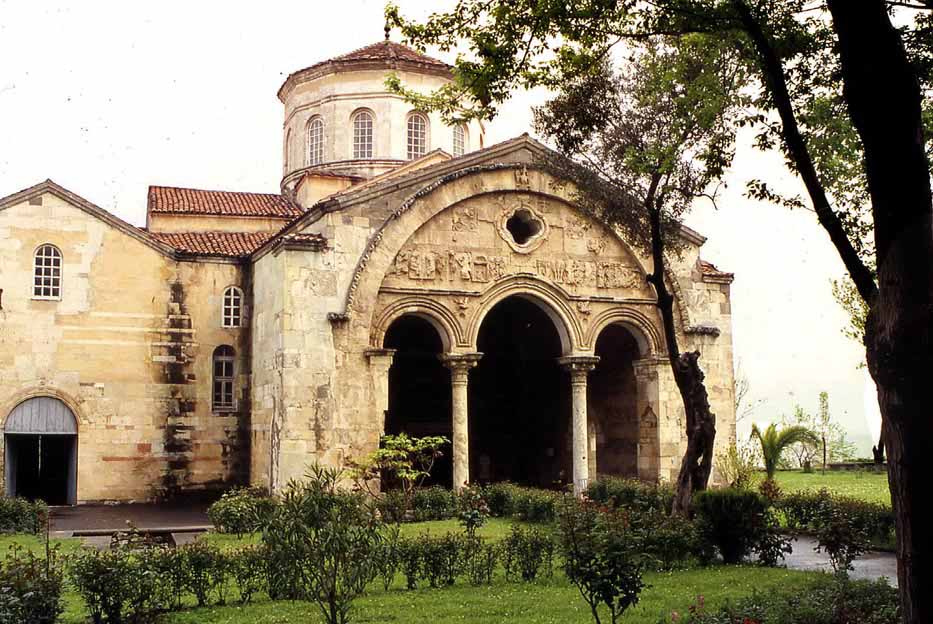
Four antique columns carry the dome:
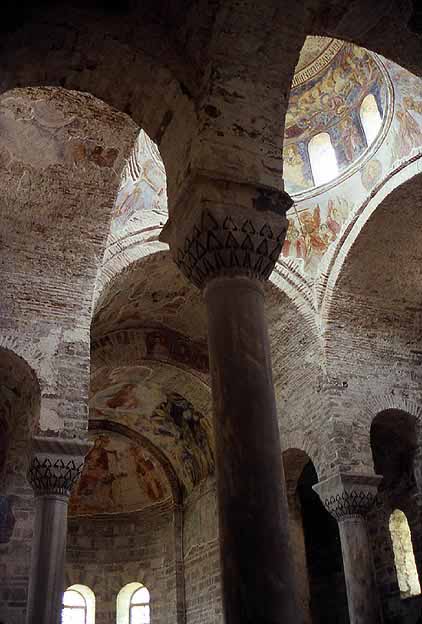
The Frescoes
Frescoes in the dome
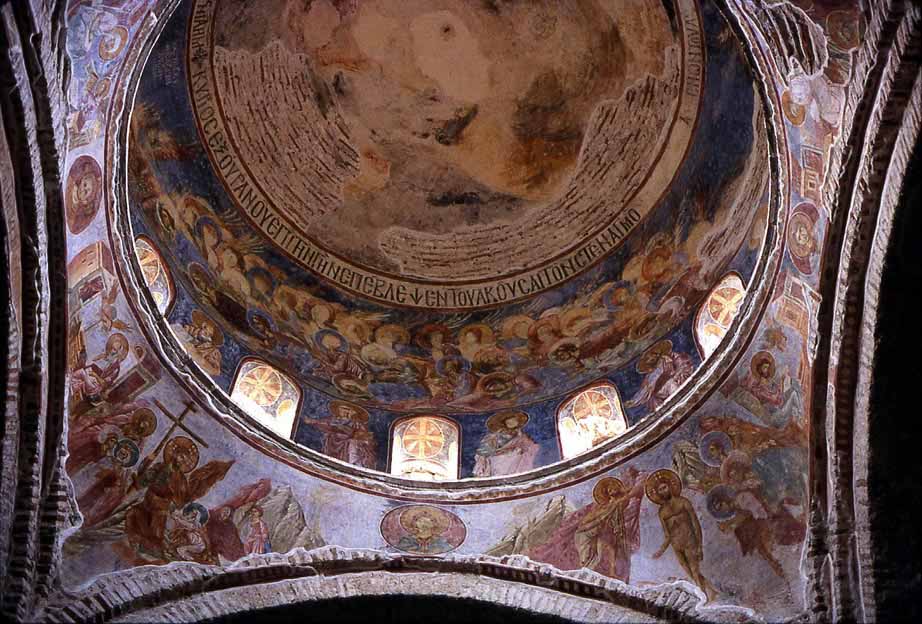
St. John baptizing Christ:
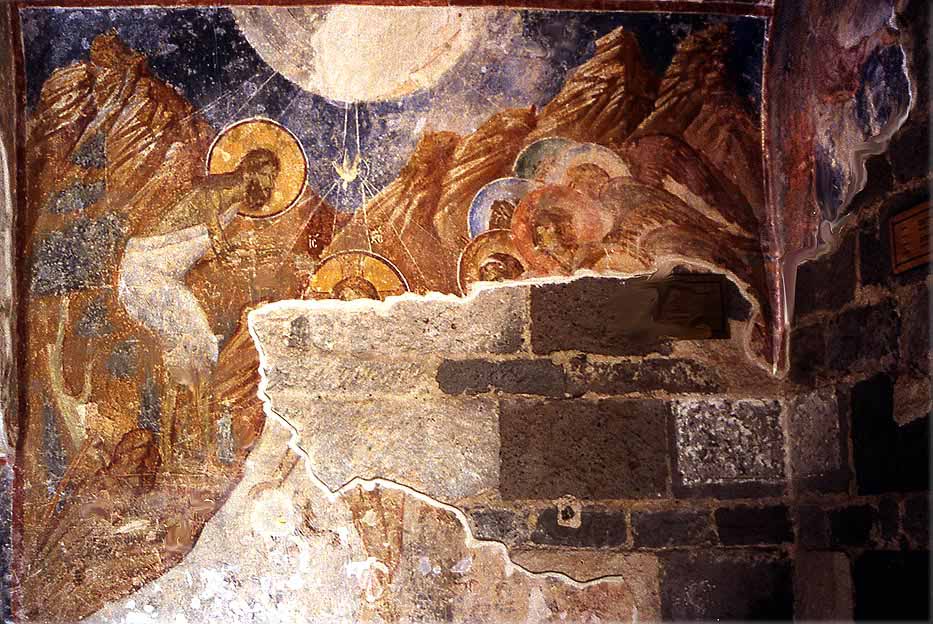
Christ teaching the Sermon on the Mount and the feeding of the 5000
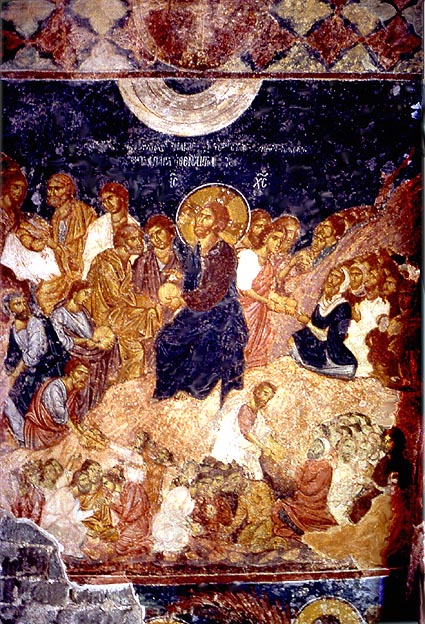
A fragment of the Last Supper — Judas sits separately on a stool in the foreground, the apostles have no haloes
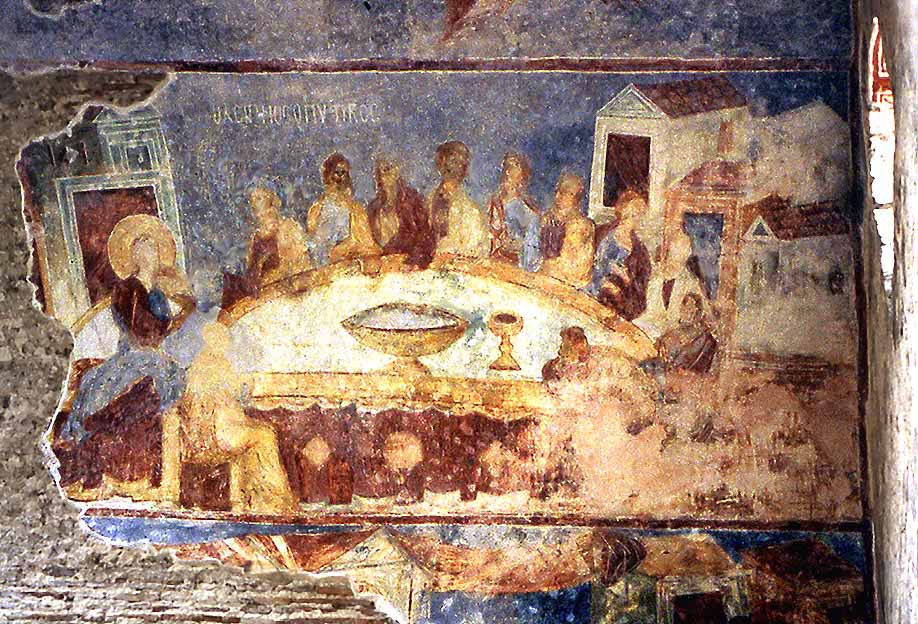
The Wedding at Kana
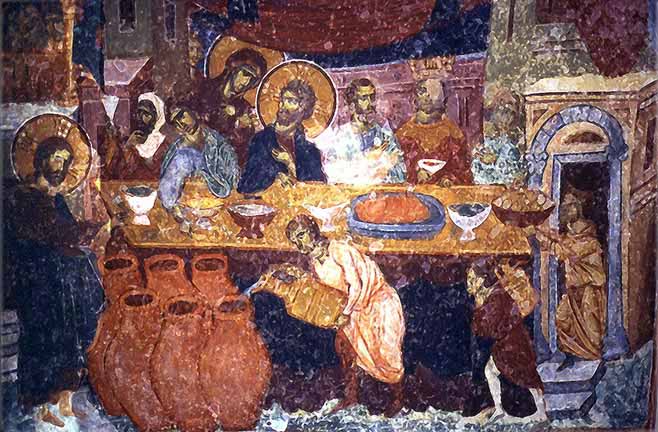
The Madonna Theotokos (Carrying God) (before 1300!) in the apse and the Elevation of Christ in the center of the vault of the naos.
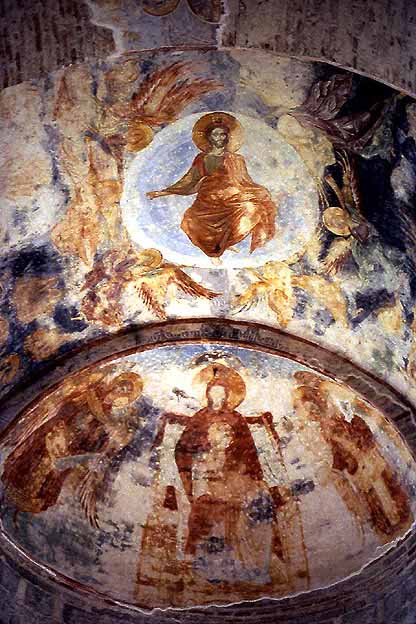
Más sobre Turkey, Trabzon, Aghia Sofia 1240
211: Germany, Heisterbach 1250
This marker is part of an illustrated Survey of Romanesque Architecture, 300 to 1300 AD. To see and read all comments you have to download the post to your hard disk.
Kloster Heisterbach 13th cent


Photos thaïs.it
Más sobre Germany, Heisterbach 1250
212: Germany, Altenkrempe 1250
This marker is part of an illustrated Survey of Romanesque Architecture, 300 to 1300 AD. To see and read all comments you have to download the post to your hard disk.
Basilika Altenkrempe 1250
Photo Thaïs.it
Más sobre Germany, Altenkrempe 1250
213: Armenia, Geghard Monastery 1250
This marker is part of an illustrated Survey of Romanesque Architecture, 300 to 1300 AD. To see and read all comments you have to download the post to your hard disk.
Armenia, Geghard Monastery, 1250
Armenian monastery, partly carved out of a mountain. Though the monastery has been around since before the 4th century, the main cathedral was built in 1215.

Geghard from the entry gate. Photo by andrejpausic, Panoramio
Más sobre Armenia, Geghard Monastery 1250
214: Germany, Xanten Dom St. Viktor 1260?
This marker is part of an illustrated Survey of Romanesque Architecture, 300 to 1300 AD. To see and read all comments you have to download the post to your hard disk.
Xanten Dom St. Viktor 1260?

Photo by rainerbaer, Panoramio
Más sobre Germany, Xanten Dom St. Viktor 1260?
215: France, Aigues-Mortes Notre Dame 1270
This marker is part of an illustrated Survey of Romanesque Architecture, 300 to 1300 AD. To see and read all comments you have to download the post to your hard disk.
France, Aigues-Mortes Notre Dame 1270
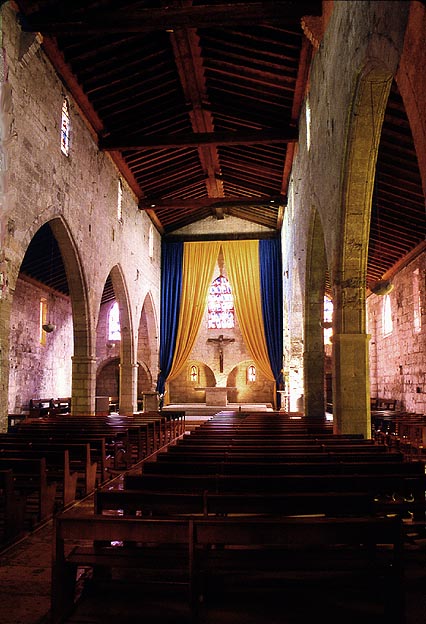
The church of King St. Louis IX and the unhappy 6th and 7th Crusades (1248 and 1272). The trasnsition to the Gothic style has taken place.
Photo RWFG
Más sobre France, Aigues-Mortes Notre Dame 1270
216: Spain, Fuentidueña, San Miquel 12th-13th cent
This marker is part of an illustrated Survey of Romanesque Architecture, 300 to 1300 AD. To see and read all comments you have to download the post to your hard disk.
Fuentidueña, Iglesia de San Miquel 12th-13th cent
The church was dismantled and moved to the Cloisters Museum in New York in 1957 in exchange for the frescoes of San Baudelio de Berlanga, now in the Prado Museum in Madrid

Photo arte-romanico.com
Más sobre Spain, Fuentidueña, San Miquel 12th-13th cent
217: Georgia, Kintsvisi Cathedral, 12th-13th cent
This marker is part of an illustrated Survey of Romanesque Architecture, 300 to 1300 AD. To see and read all comments you have to download the post to your hard disk.
The church of St. Nicholas dates from the 13th century. Its unique frescoes are from the same time. The blue in its frescoes is unique among Georgian churches.. The main apse:
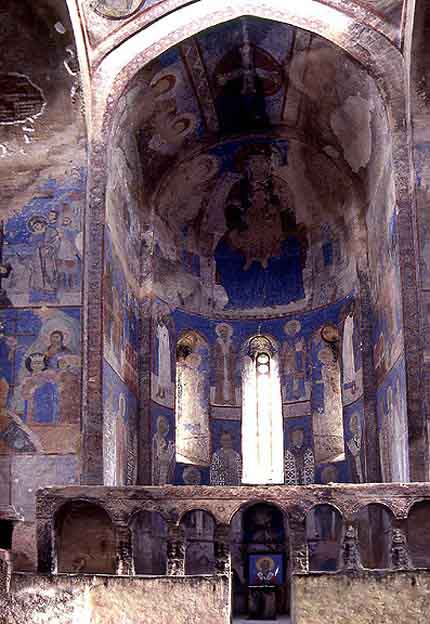
Left side with the celebrated images of Queen Tamara, her father King George, and her son and future king Lasha blessed by Christ.
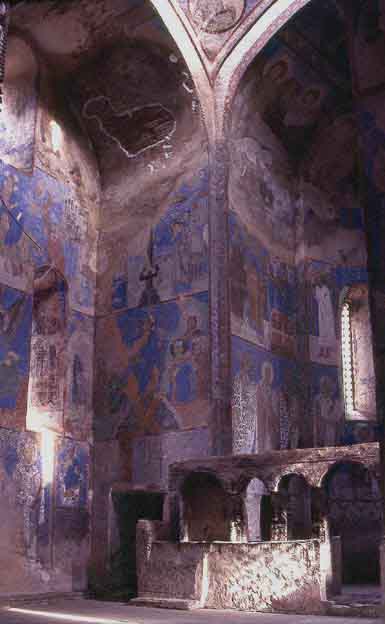
Next to the main church there is the ruin of a second, older church (12th cent) with a large, uncanonical and very Georgian fresco of the Madonna - unprotected from the elements.
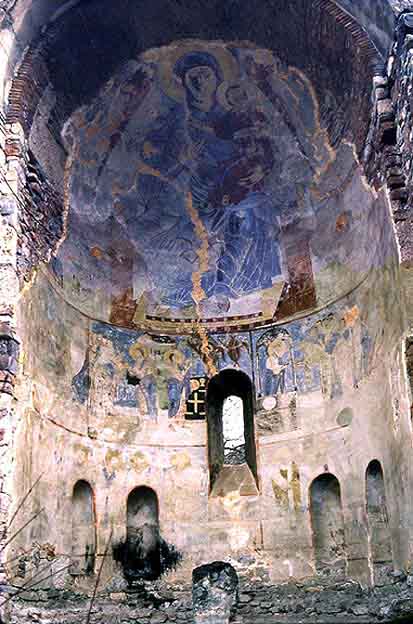
Photos RWFG
Más sobre Georgia, Kintsvisi Cathedral, 12th-13th cent
218: Macedonia, Ohid Santa Sofia 12th cent
This marker is part of an illustrated Survey of Romanesque Architecture, 300 to 1300 AD. To see and read all comments you have to download the post to your hard disk.
Macedonia, Ohid, Santa Sofia 12th cent(?)

Photo by TATANGALAR, Panoramio
Más sobre Macedonia, Ohid Santa Sofia 12th cent
219: Germany Cologne S. Maria im Capitol 12th cent
This marker is part of an illustrated Survey of Romanesque Architecture, 300 to 1300 AD. To see and read all comments you have to download the post to your hard disk.
Cologne, Basilica S. Maria im Capitol 12th cent
Photo sacred-destinations.com
Más sobre Germany Cologne S. Maria im Capitol 12th cent
220: Cologne, Abbey St. Kunibert 13th cent
This marker is part of an illustrated Survey of Romanesque Architecture, 300 to 1300 AD. To see and read all comments you have to download the post to your hard disk.
Abbey St. Kunibert 13th cent

Photo by raka00, Panoramio
Más sobre Cologne, Abbey St. Kunibert 13th cent
221: France, Dijon Saint-Bénigne 12th cent
This marker is part of an illustrated Survey of Romanesque Architecture, 300 to 1300 AD. To see and read all comments you have to download the post to your hard disk.
Dijon Saint-Bénigne 12th cent.

Interior classical Burgundy 12th cent.
Photo by kobiel, Panoramio

The crypt
Photo from thais.it/architettura/romanica/
Más sobre France, Dijon Saint-Bénigne 12th cent
222: Spain, Sepúlveda, Iglesia San Salvador 12th cent?
This marker is part of an illustrated Survey of Romanesque Architecture, 300 to 1300 AD. To see and read all comments you have to download the post to your hard disk.
Spain, Sepúlveda, Iglesia San Salvador 12th cent?

Photo by 4ullas, Panoramio
Más sobre Spain, Sepúlveda, Iglesia San Salvador 12th cent?
223: Spain, San Baudelio de Berlanga 11th-12th cent
This marker is part of an illustrated Survey of Romanesque Architecture, 300 to 1300 AD. To see and read all comments you have to download the post to your hard disk.
Spain, San Baudelio de Berlanga 11th-12th cent

The chapel. Photo by santiul, Panoramio

Frescoes in its interior. Photo by VICMAEL, Panoramio
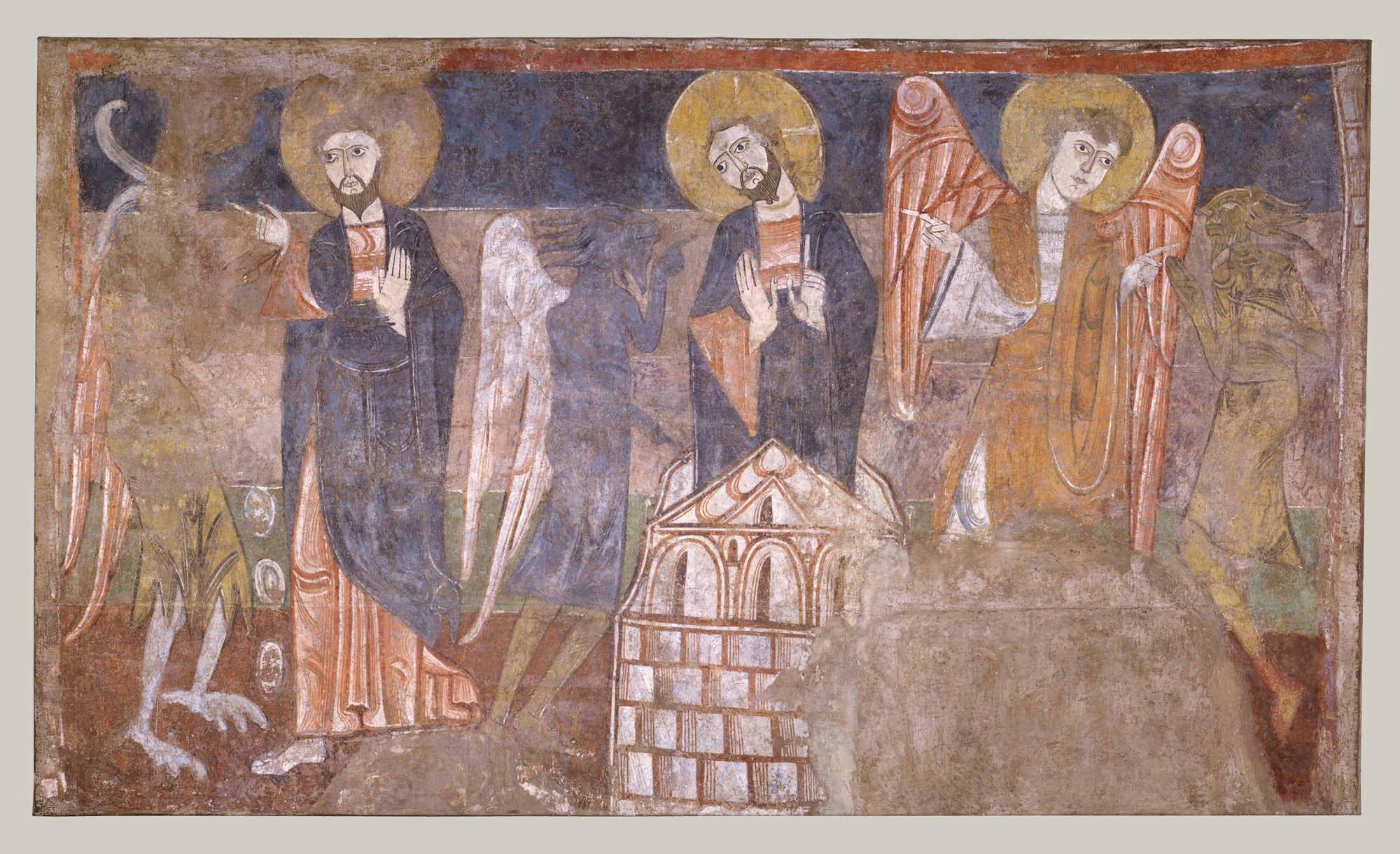
The Temptation of Christ, ca. 1125, Hermitage of San Baudelio de Berlanga, province of Soria, Spain, Fresco transferred to canvas. Photo: The Cloisters Collection, Metropolitan Mus. New York (now in the Prado, Madrid?)
Más sobre Spain, San Baudelio de Berlanga 11th-12th cent
224: France, Abbatiale de Cruas 12th cent
This marker is part of an illustrated Survey of Romanesque Architecture, 300 to 1300 AD. To see and read all comments you have to download the post to your hard disk.
France, Abbatiale de Cruas 12th cent
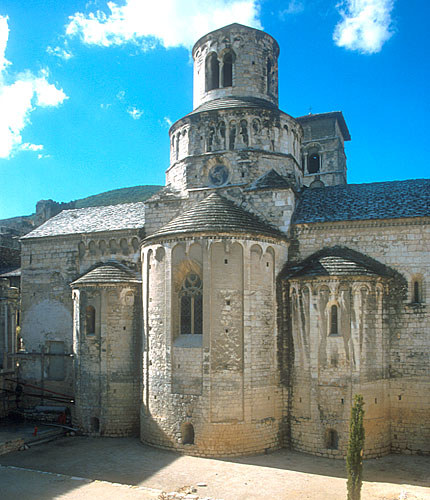
Photo patrimoine-ardeche.com
Más sobre France, Abbatiale de Cruas 12th cent
225: Spain, Corunna, Collegiata S. Maria del Campo 12th cent?
This marker is part of an illustrated Survey of Romanesque Architecture, 300 to 1300 AD. To see and read all comments you have to download the post to your hard disk.
Spain, Corunna, Collegiata S. Maria del Campo 12th cent?

| Photo by davcer, Panoramio
Más sobre Spain, Corunna, Collegiata S. Maria del Campo 12th cent?
226: France, Abbaye de Fontgombault 12-13th cent
This marker is part of an illustrated Survey of Romanesque Architecture, 300 to 1300 AD. To see and read all comments you have to download the post to your hard disk.
France, Abbaye de Fontgombault 12-13th cent

Aerial view of the monastery. Photo ansfac.org
Más sobre France, Abbaye de Fontgombault 12-13th cent
227: France, Boscherville, Abbey Saint-Georges 12th cent
This marker is part of an illustrated Survey of Romanesque Architecture, 300 to 1300 AD. To see and read all comments you have to download the post to your hard disk.
Boscherville, Abbey Saint-Georges 12th cent.

Photo by Stéphane Duval, Panoramio
Más sobre France, Boscherville, Abbey Saint-Georges 12th cent
228: Spain, Portomarin, San Juan, 12thcent
This marker is part of an illustrated Survey of Romanesque Architecture, 300 to 1300 AD. To see and read all comments you have to download the post to your hard disk.
Spain, Portomarin, San Juan, 12th cent
It is an unusual Late Romanesque temple as it is designed to be both a church and a castle and so has architectural characteristics of both buildings. As a church it has one barrel vaulted nave, a semicircular apse and all the typical decorations of Romanesque churches; these include a carved portal with archivolts, rose windows and carved capitals.

Photo by aagundin, Panoramio
Más sobre Spain, Portomarin, San Juan, 12thcent
229: Spain, Segovia, San Marco, Mozarab 12th cent
This marker is part of an illustrated Survey of Romanesque Architecture, 300 to 1300 AD. To see and read all comments you have to download the post to your hard disk.
Segovia, San Marco, Mozarab, 12th cent

Photo by gorostiza, Panoramio
Más sobre Spain, Segovia, San Marco, Mozarab 12th cent
230: Spain, Zamora, Catedral de Salvador 12th cent
This marker is part of an illustrated Survey of Romanesque Architecture, 300 to 1300 AD. To see and read all comments you have to download the post to your hard disk.
Zamora, Catedral de Salvador 12th cent

Photo by fjmanzanal, Panoramio
Más sobre Spain, Zamora, Catedral de Salvador 12th cent
231: Spain, Cillamayor, Santa Maria la Real 12th cent
This marker is part of an illustrated Survey of Romanesque Architecture, 300 to 1300 AD. To see and read all comments you have to download the post to your hard disk.
Cillamayor, Church of Santa María la Real

Photo by Jerónimo Ramos, Panoramio
Más sobre Spain, Cillamayor, Santa Maria la Real 12th cent
232: Spain, Soria, Claustro de San Juan de Duero, 12th cent
This marker is part of an illustrated Survey of Romanesque Architecture, 300 to 1300 AD. To see and read all comments you have to download the post to your hard disk.
Soria, Claustro de San Juan de Duero, 12th cent
The cloisters of San Juan de Duero in Soria is a rare and unique example of Mozarabian form elements in Christian architecture :

Photo by VICMAEL., Panoramio
Más sobre Spain, Soria, Claustro de San Juan de Duero, 12th cent
233: Spain, Carrion de los Condes, Iglesia Maria Victoria 10th-12th cent
This marker is part of an illustrated Survey of Romanesque Architecture, 300 to 1300 AD. To see and read all comments you have to download the post to your hard disk.
Carrion de los Condes, Iglesia Maria Victoria 10-12th cent

Photo by ferdariz, Panoramio
Más sobre Spain, Carrion de los Condes, Iglesia Maria Victoria 10th-12th cent
234: Spain, Barrio de Santa María, Santa Eulalia ?
This marker is part of an illustrated Survey of Romanesque Architecture, 300 to 1300 AD. To see and read all comments you have to download the post to your hard disk.
Barrio de Santa María, Ermita di Santa Eulalia, Mozarab 12th cent
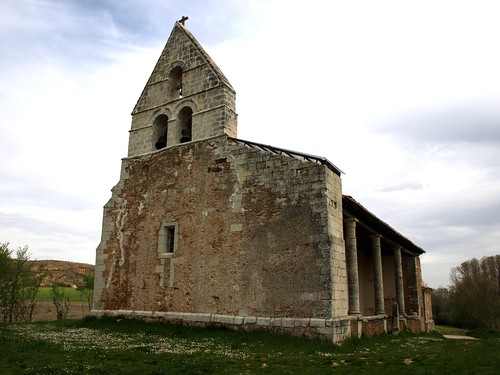
Exterior of the Eremita Santa Eulalia.
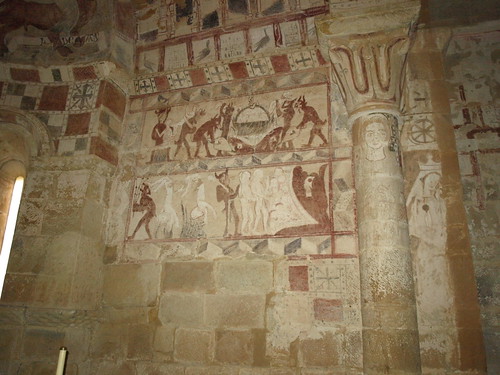
Mozarab murals: Hell . Photos flickr photos
Más sobre Spain, Barrio de Santa María, Santa Eulalia ?
235: Spain, Olmos de Ojeda, Santa Eufemia 12th cent
This marker is part of an illustrated Survey of Romanesque Architecture, 300 to 1300 AD. To see and read all comments you have to download the post to your hard disk.
Olmos de Ojeda, Santa Eufemia 12th cent

Photo by diegourdiales, Panoramio
Más sobre Spain, Olmos de Ojeda, Santa Eufemia 12th cent
236: Spain, Carrion, Iglesia di Santiago 13th cent
This marker is part of an illustrated Survey of Romanesque Architecture, 300 to 1300 AD. To see and read all comments you have to download the post to your hard disk.
Carrion, Iglesia di Santiago 13th cent

Photo: by Maghabel, Panoramio
The church is famous for its early Romanesque sculpture:

Más sobre Spain, Carrion, Iglesia di Santiago 13th cent
237: Spain, Duratón, Iglesia de N. S. de la Asuncion 12th cent
This marker is part of an illustrated Survey of Romanesque Architecture, 300 to 1300 AD. To see and read all comments you have to download the post to your hard disk.
Duratón, Iglesia de Nuestra Señora de la Asuncion 12th -15th cent

Photo by mamarugan, Panoramio
Más sobre Spain, Duratón, Iglesia de N. S. de la Asuncion 12th cent
238: Spain, La Coruña, Iglesia de Santiago 12th cent
This marker is part of an illustrated Survey of Romanesque Architecture, 300 to 1300 AD. To see and read all comments you have to download the post to your hard disk.
Spain, La Coruña, Iglesia de Santiago 12th cent

Photo by bronchk, Panoramio
Más sobre Spain, La Coruña, Iglesia de Santiago 12th cent
239: France, St. Gervazy, Black Madonna 12th cent
This marker is part of an illustrated Survey of Romanesque Architecture, 300 to 1300 AD. To see and read all comments you have to download the post to your hard disk.
Auvergne, St. Gervazy, Black Madonna 12th cent
In this tiny village church used to stand one of the rarest of the abstract wooden Romasnesque Black Madonna's.
This precious sculpture was stolen in 1989, and has not been found since..
A plaster copy replaces the original.
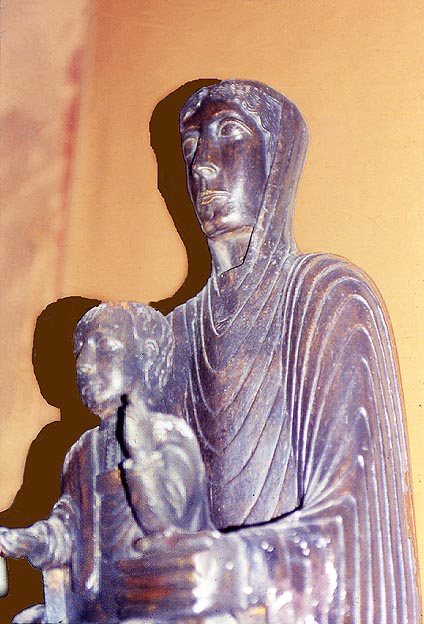
Photo RWFG
Más sobre France, St. Gervazy, Black Madonna 12th cent
240: Spain, Noia Iglesia di San Martino 12th cent
This marker is part of an illustrated Survey of Romanesque Architecture, 300 to 1300 AD. To see and read all comments you have to download the post to your hard disk.
Spain, Noia Iglesia di San Martino 12th cent

Photo by maxlasen, Panoramuio
Más sobre Spain, Noia Iglesia di San Martino 12th cent
241: France, Brioude, Basilica St-Julien, 12th, 14th, 16th cent
This marker is part of an illustrated Survey of Romanesque Architecture, 300 to 1300 AD. To see and read all comments you have to download the post to your hard disk.
France, Brioude, Basilica St-Julien, 12th, 14th, 16th cent

The high-Romanesque nave (12th and 16th cent) with frescoes of the 14th cent.
Photo by little drummerboy, Panoramio
Más sobre France, Brioude, Basilica St-Julien, 12th, 14th, 16th cent
242: Spain, Aquilar de Campoo, Hermitage of Santa Cecilia 12th cent
This marker is part of an illustrated Survey of Romanesque Architecture, 300 to 1300 AD. To see and read all comments you have to download the post to your hard disk.
Aquilar de Campoo, Hermitage of Santa Cecilia 12th cent

Photo Juan Antonio Garcia Cuevas
Más sobre Spain, Aquilar de Campoo, Hermitage of Santa Cecilia 12th cent
243: France, Chatel Montagne Church 12th cent
This marker is part of an illustrated Survey of Romanesque Architecture, 300 to 1300 AD. To see and read all comments you have to download the post to your hard disk.
France, Chatel Montagne former Benedictine Monastery Church 12th cent.
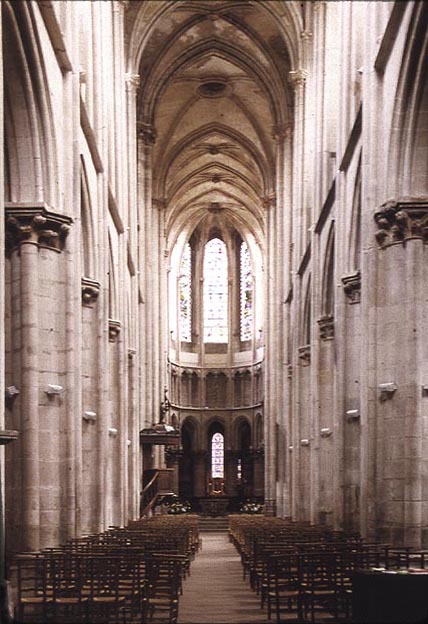
Photo RWFG.
Más sobre France, Chatel Montagne Church 12th cent
244: Germany, Breisach Münster St Stephan 13th cent
This marker is part of an illustrated Survey of Romanesque Architecture, 300 to 1300 AD. To see and read all comments you have to download the post to your hard disk.
Germany, Breisach Münster St Stephan 13th cent

Photo by Piotr Tofil, Panoramio
Más sobre Germany, Breisach Münster St Stephan 13th cent
245: Germany, Kobern/Mosel Matthiaskapelle 13th cent
This marker is part of an illustrated Survey of Romanesque Architecture, 300 to 1300 AD. To see and read all comments you have to download the post to your hard disk.
Germany, Kobern/Mosel Matthiaskapelle 13th cent

Photo: by Marcel BREZ, Panoramio

Interior. Spanish Mozarab influences on the Mosel? Photo Thaïs.it
Más sobre Germany, Kobern/Mosel Matthiaskapelle 13th cent
246: Macedonia, Ohrid, St. John of Kaneo, 13th cent
This marker is part of an illustrated Survey of Romanesque Architecture, 300 to 1300 AD. To see and read all comments you have to download the post to your hard disk.
Macedonia, Ohrid, St. John of Kaneo, 13th cent (?), The youngest but the most romantic churches of Ohrid.

Photo by smartinix, Panoramio
Más sobre Macedonia, Ohrid, St. John of Kaneo, 13th cent